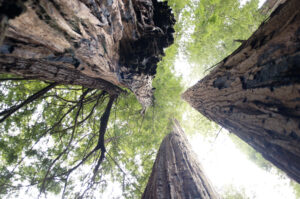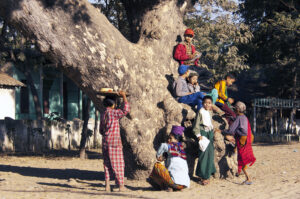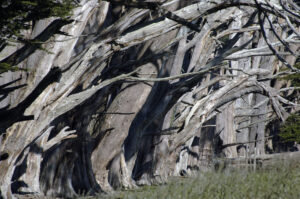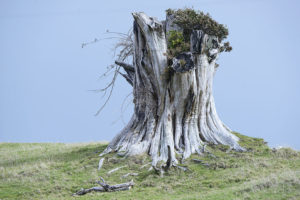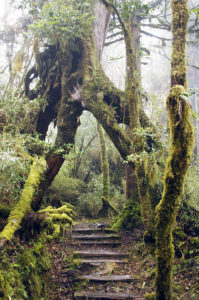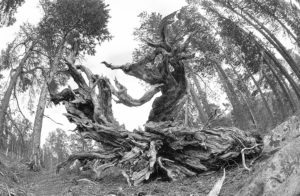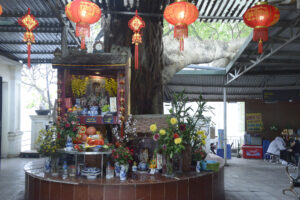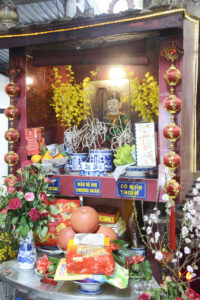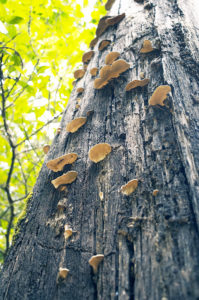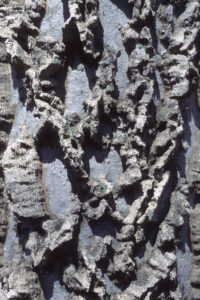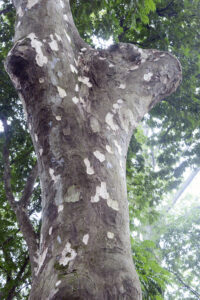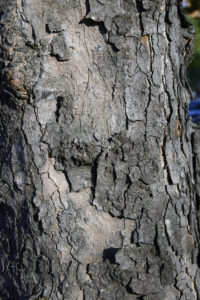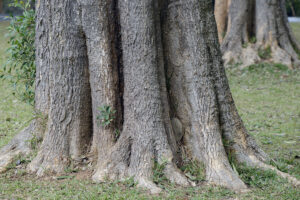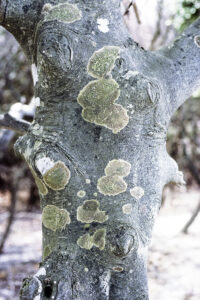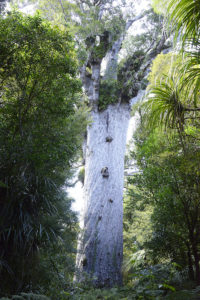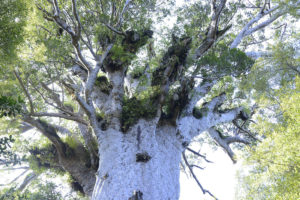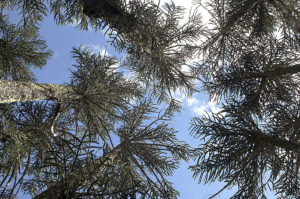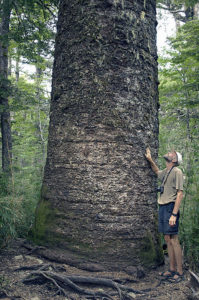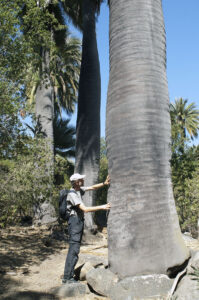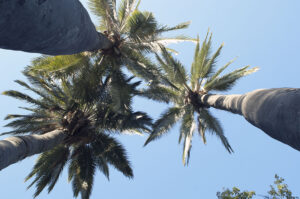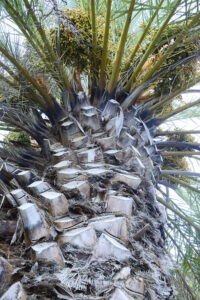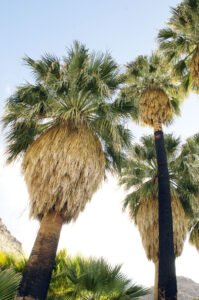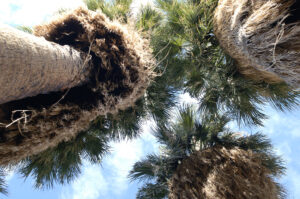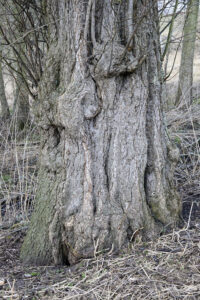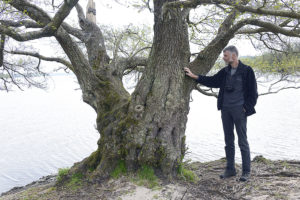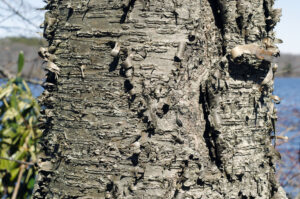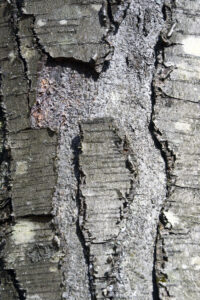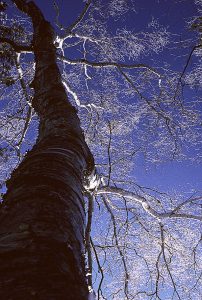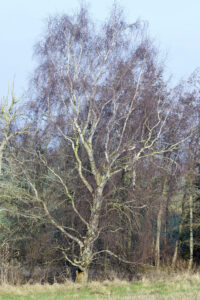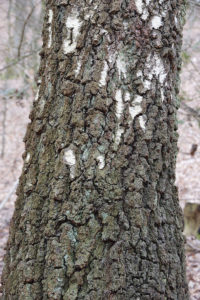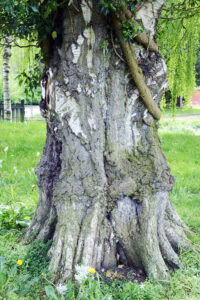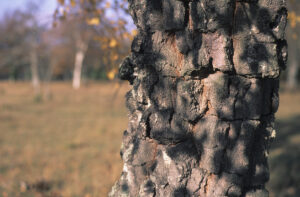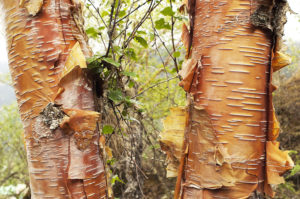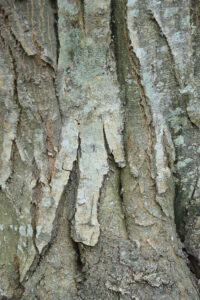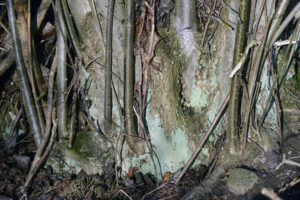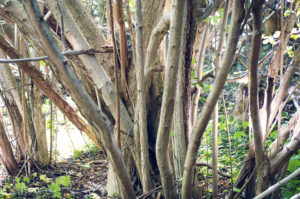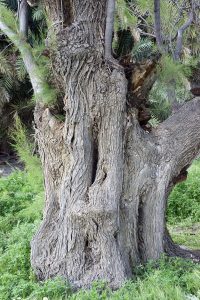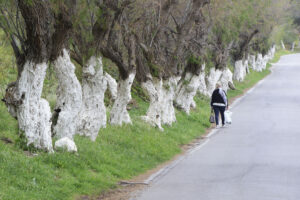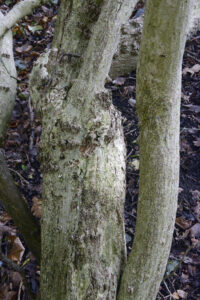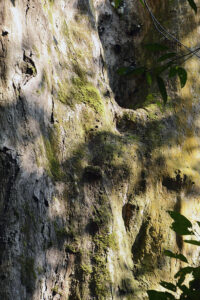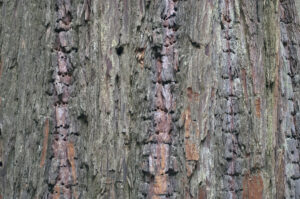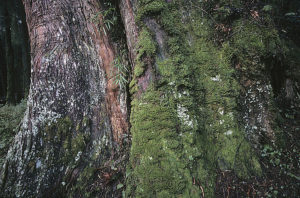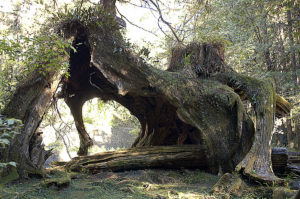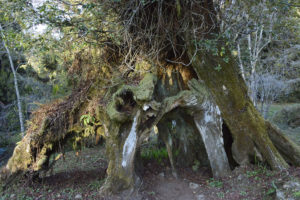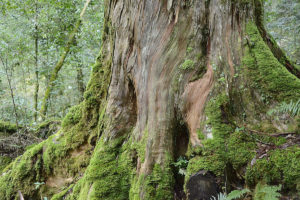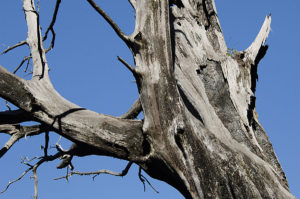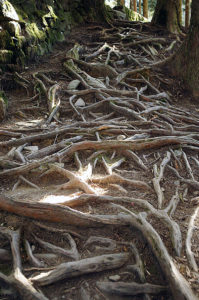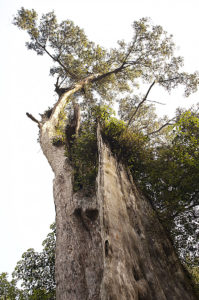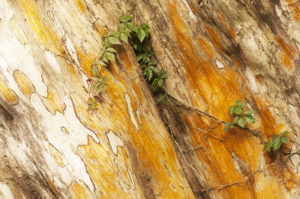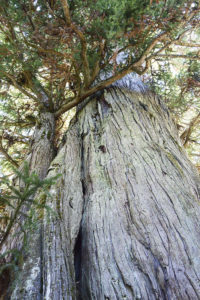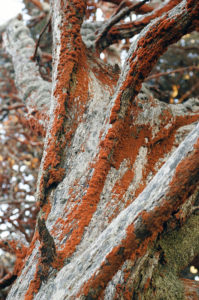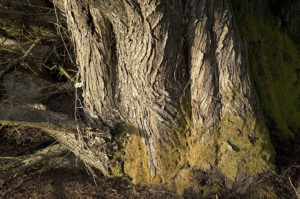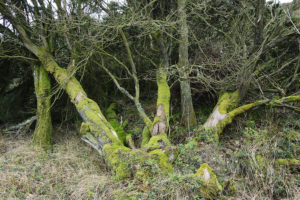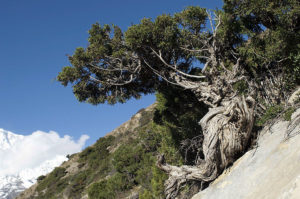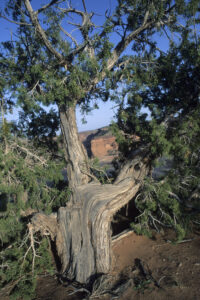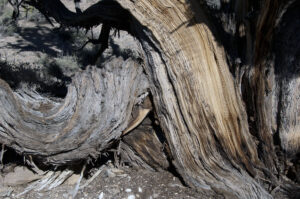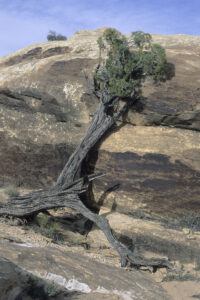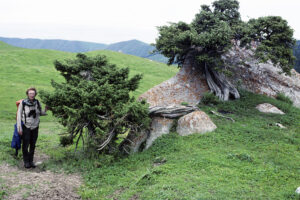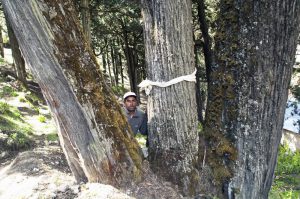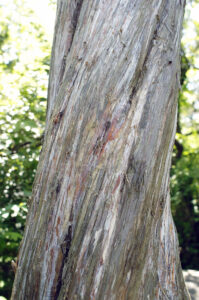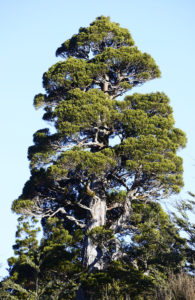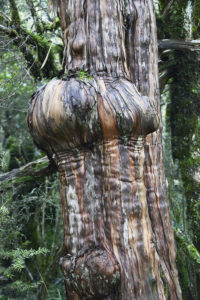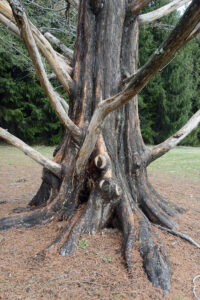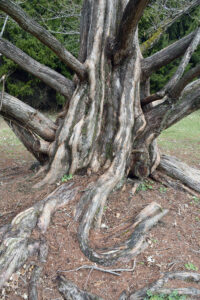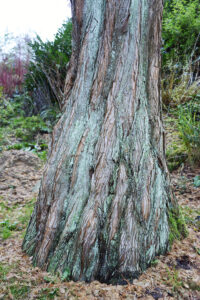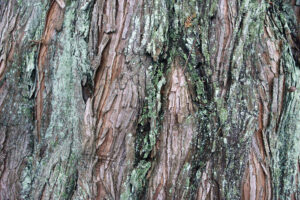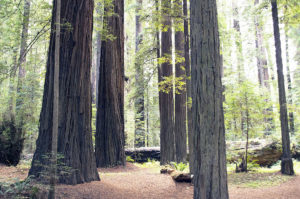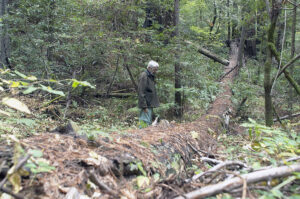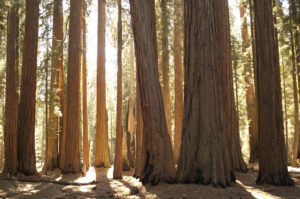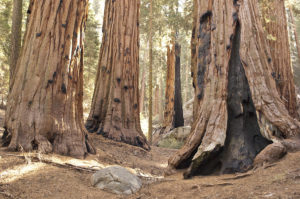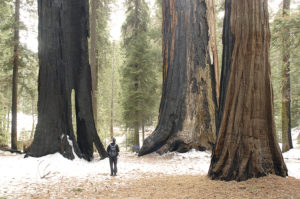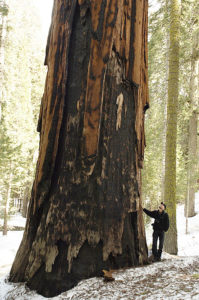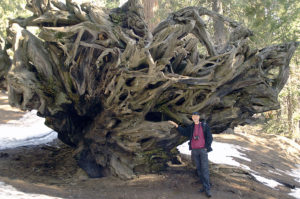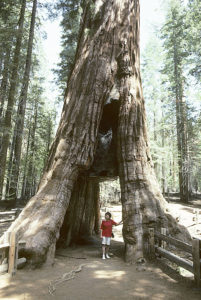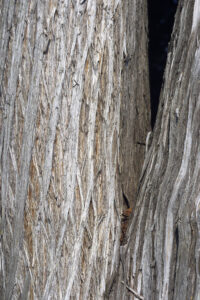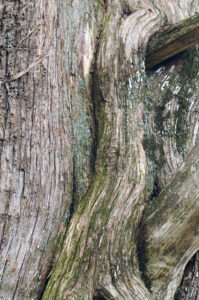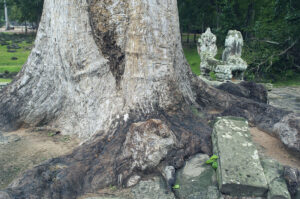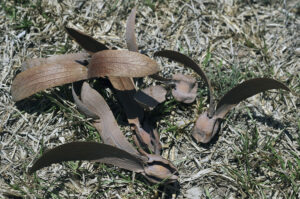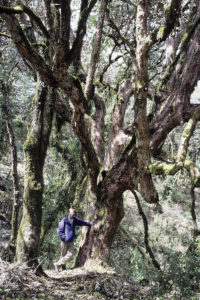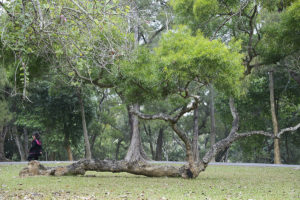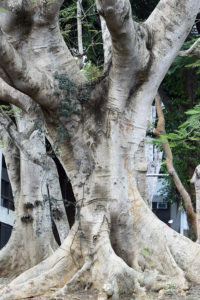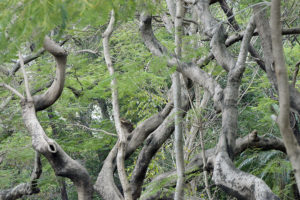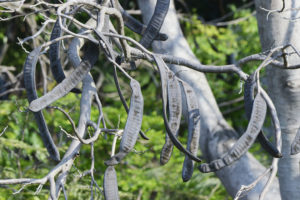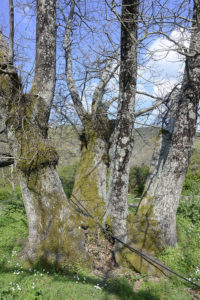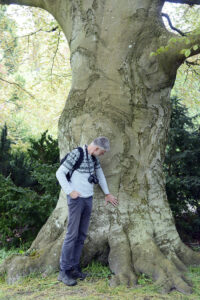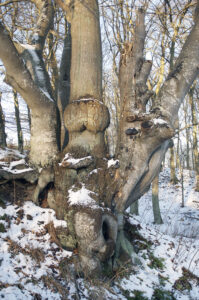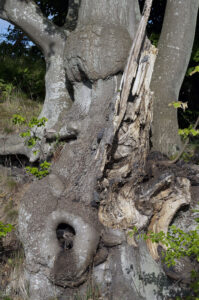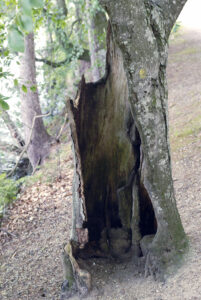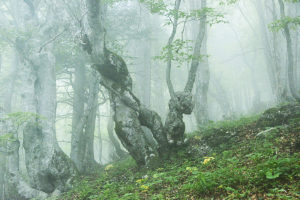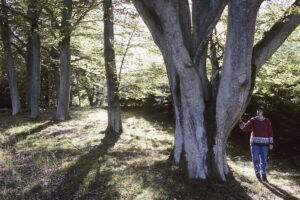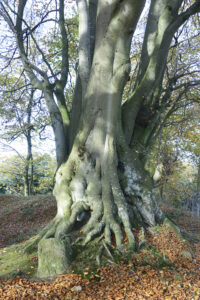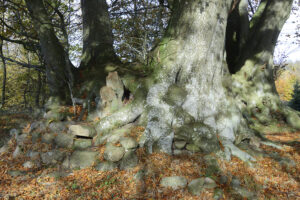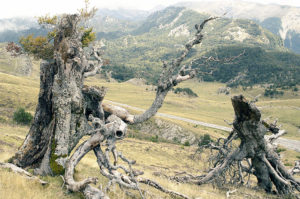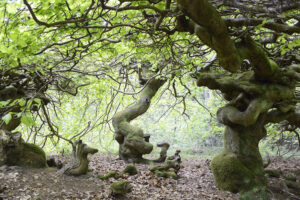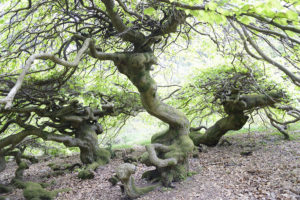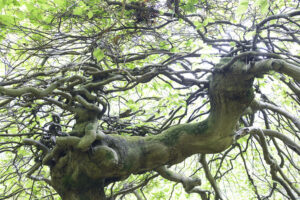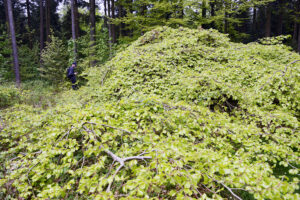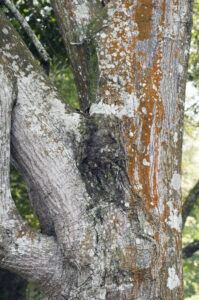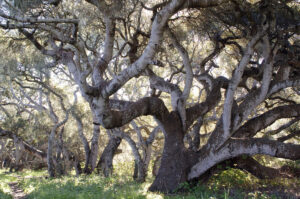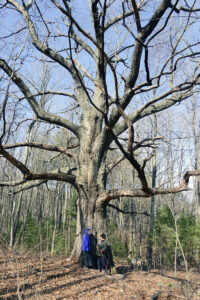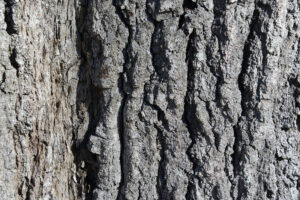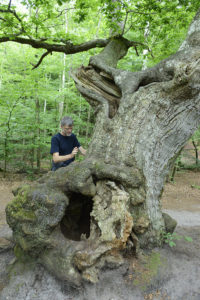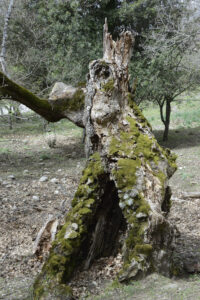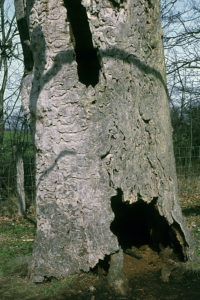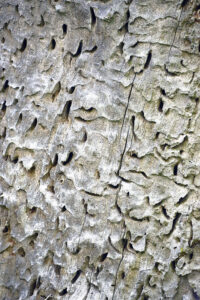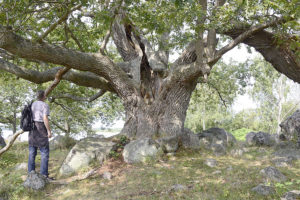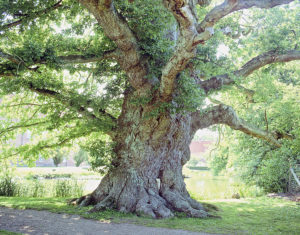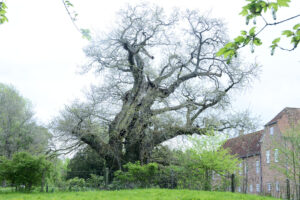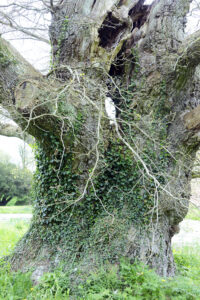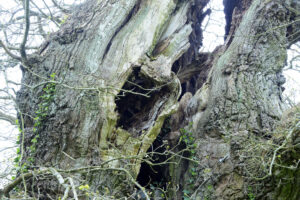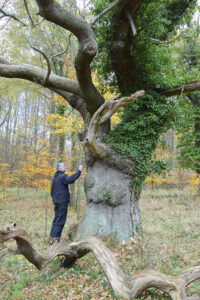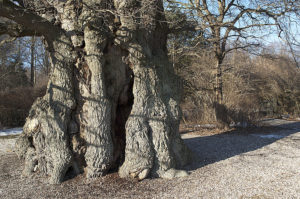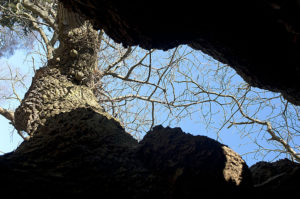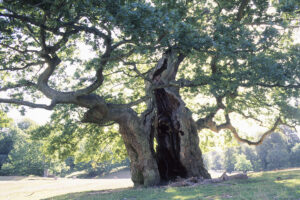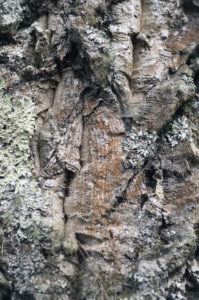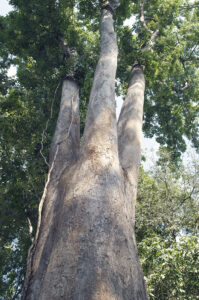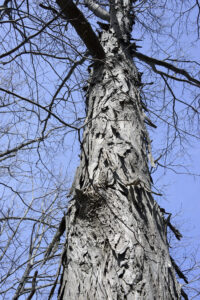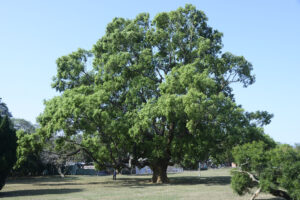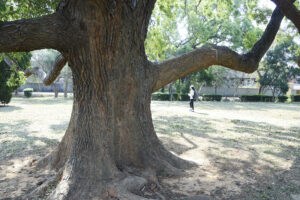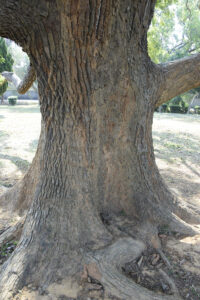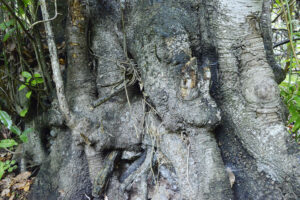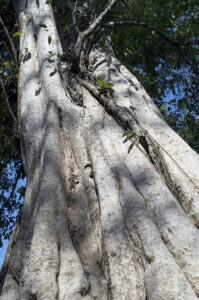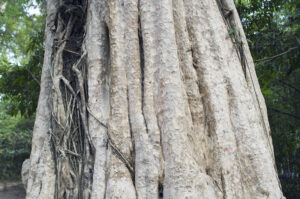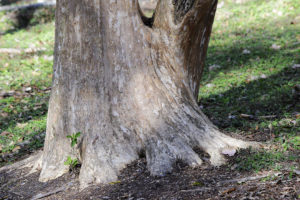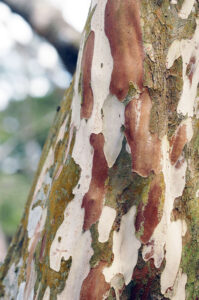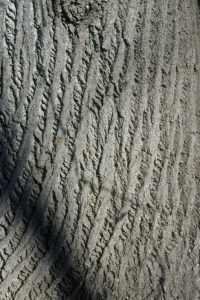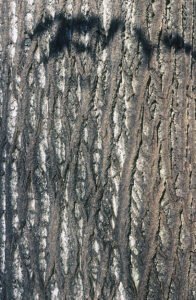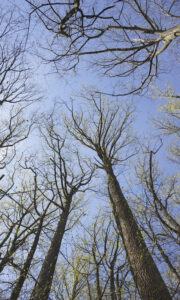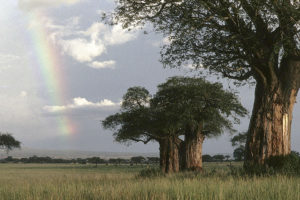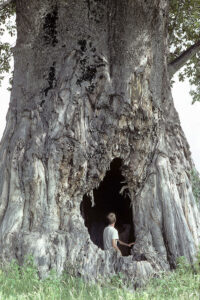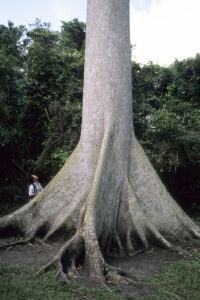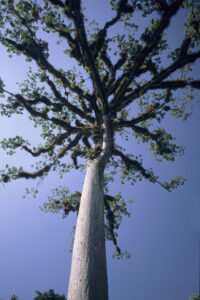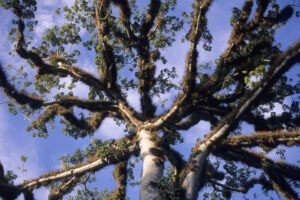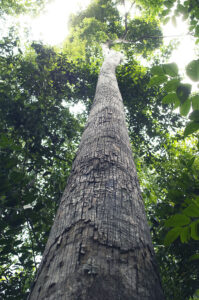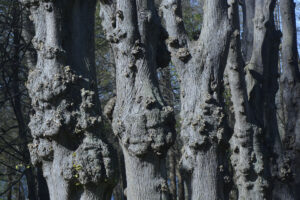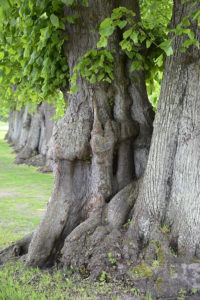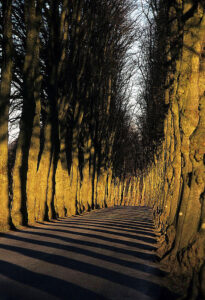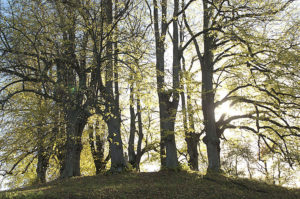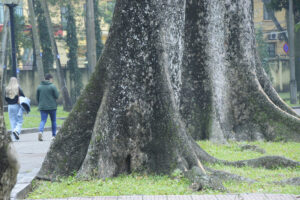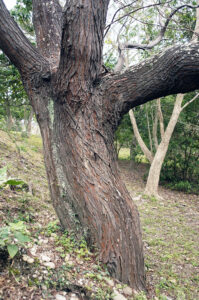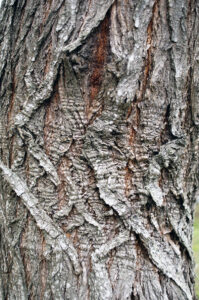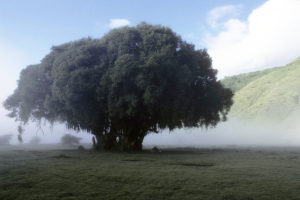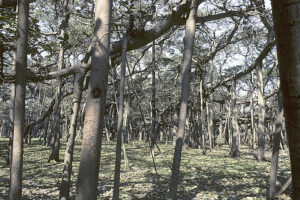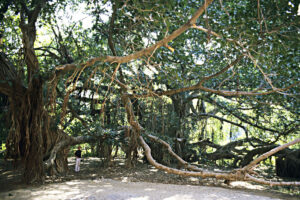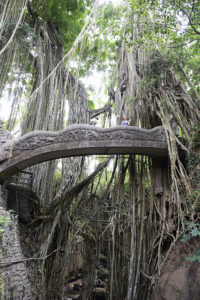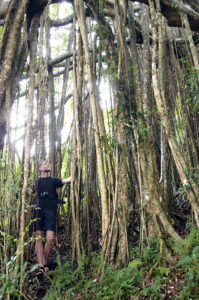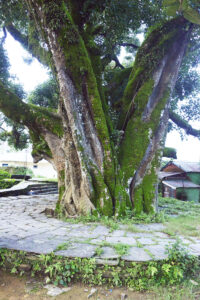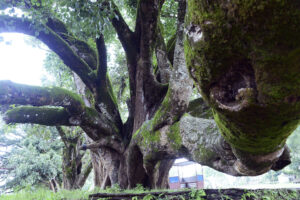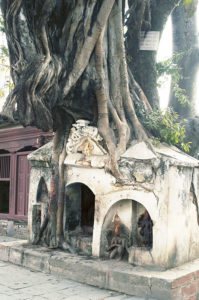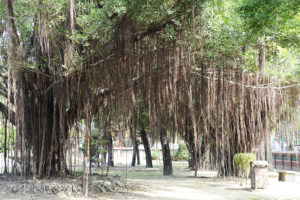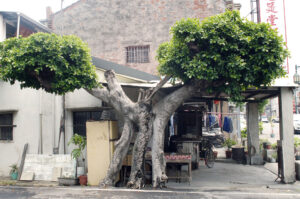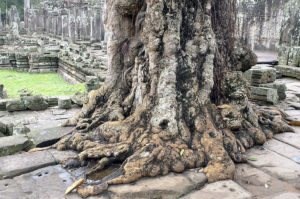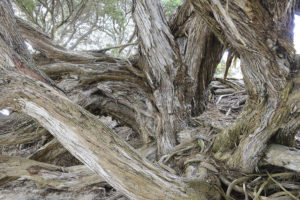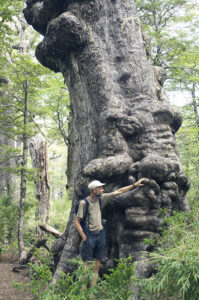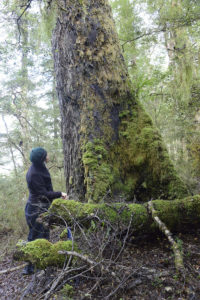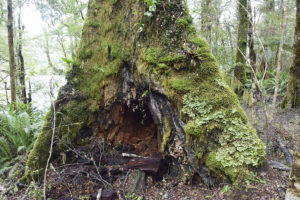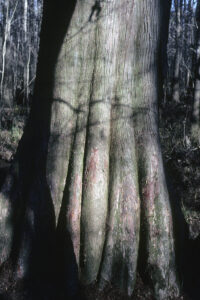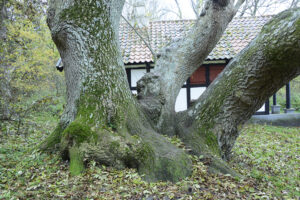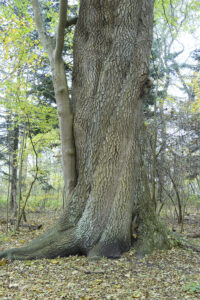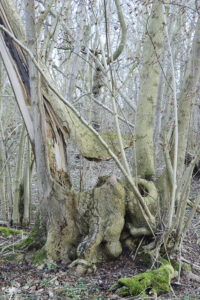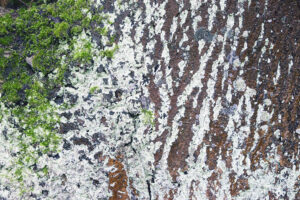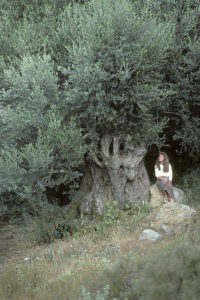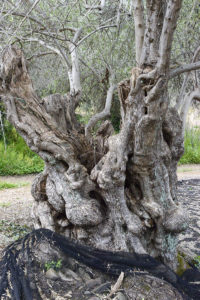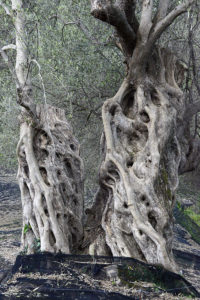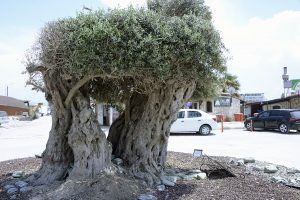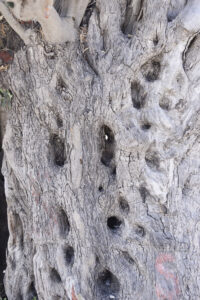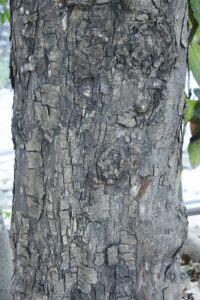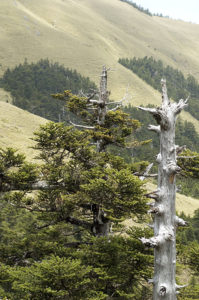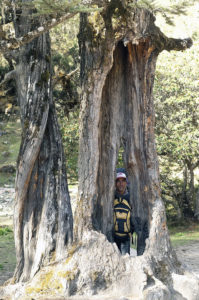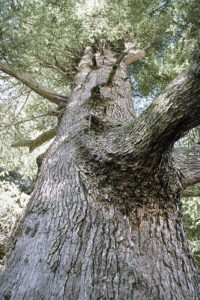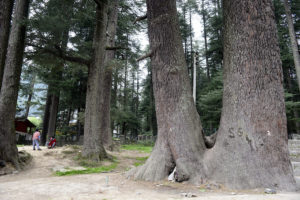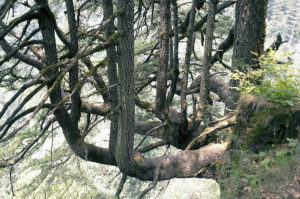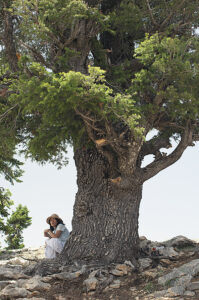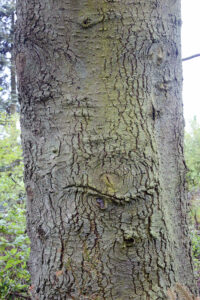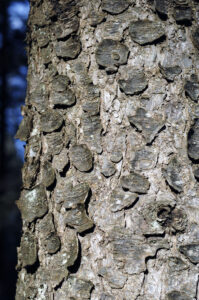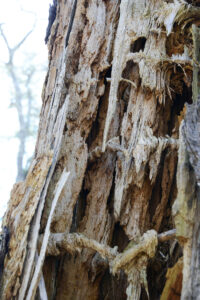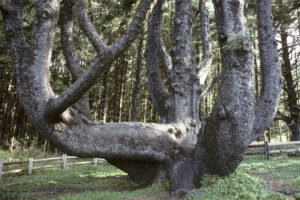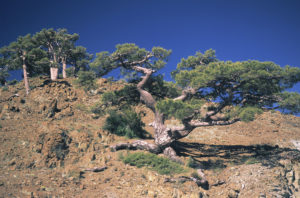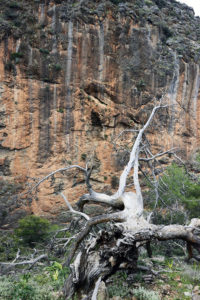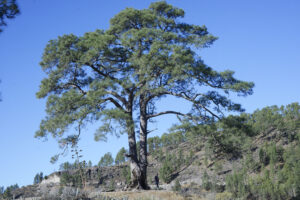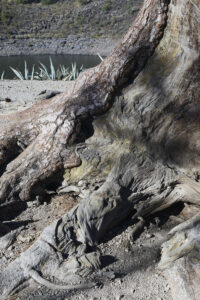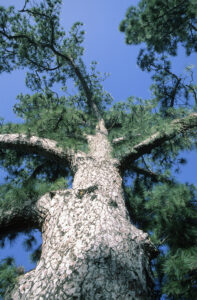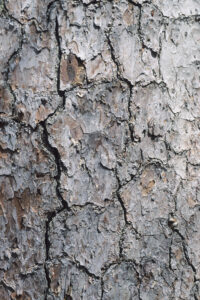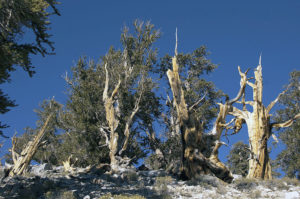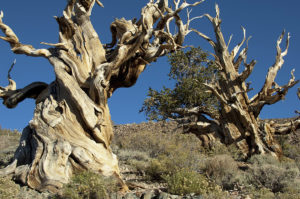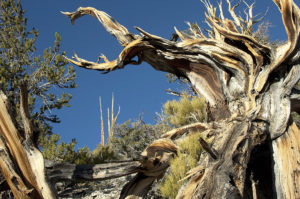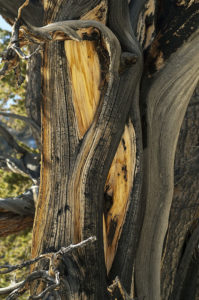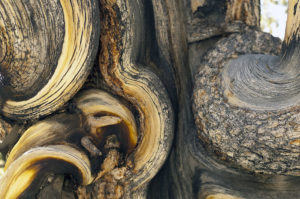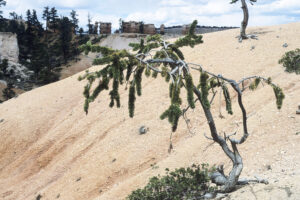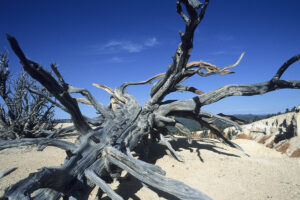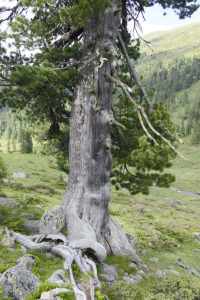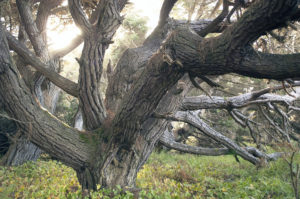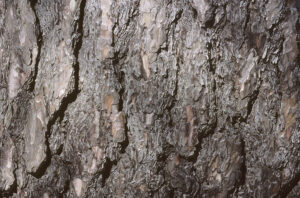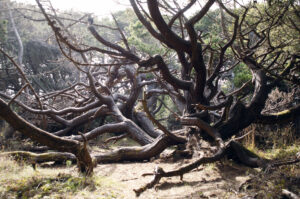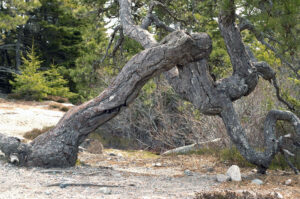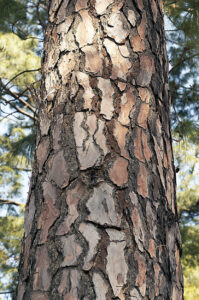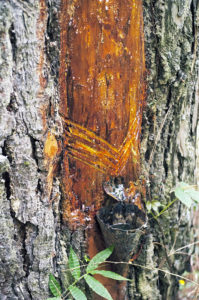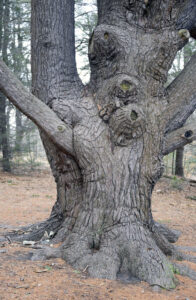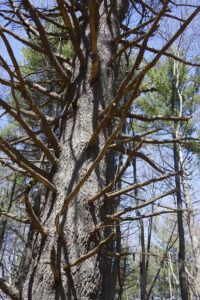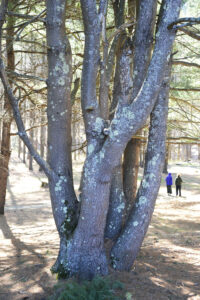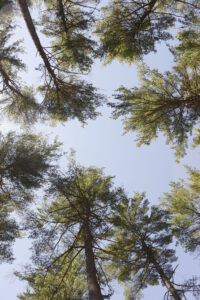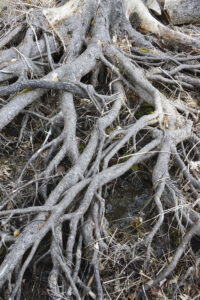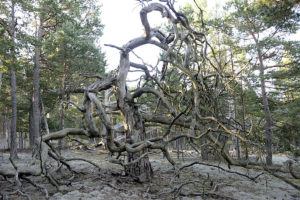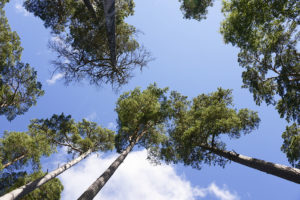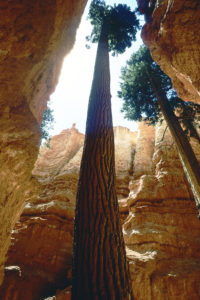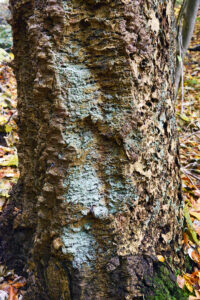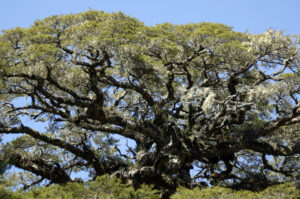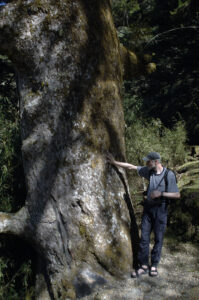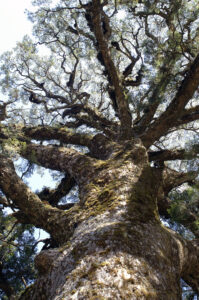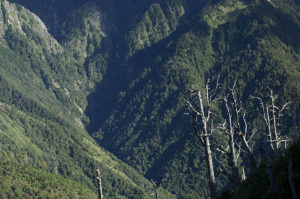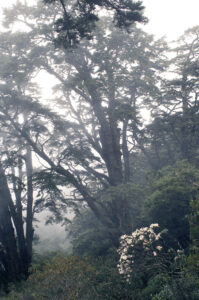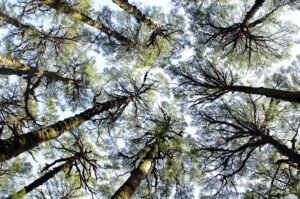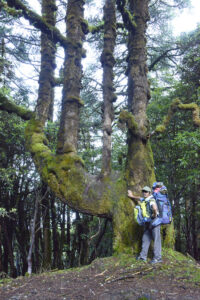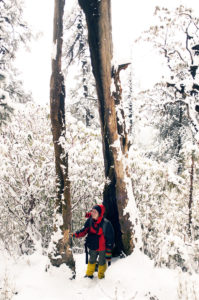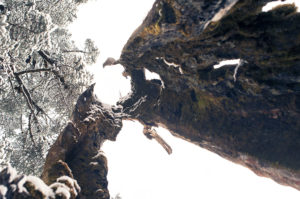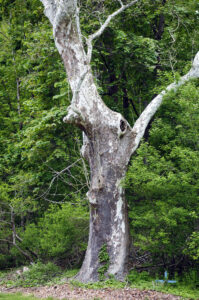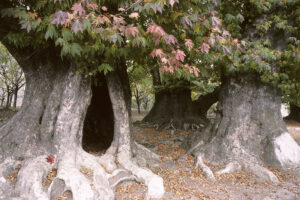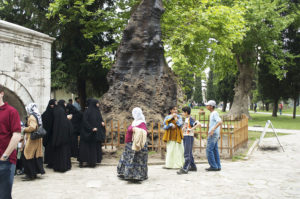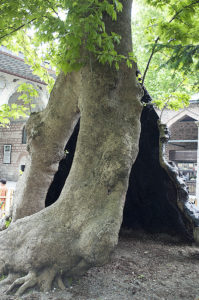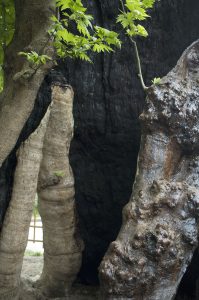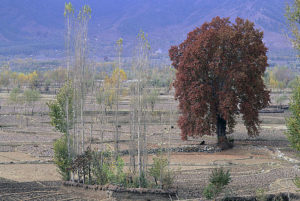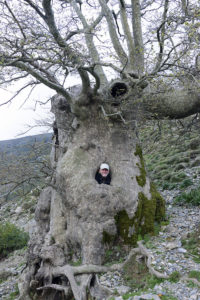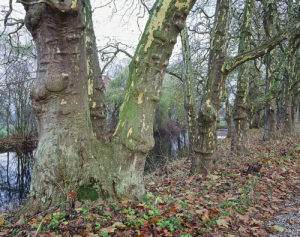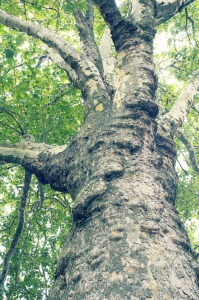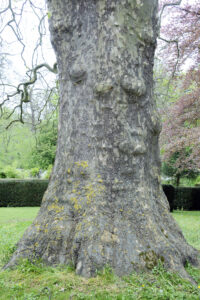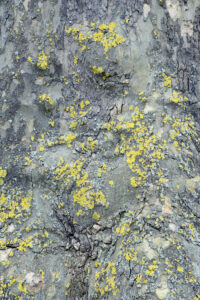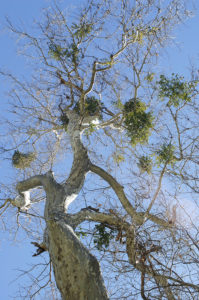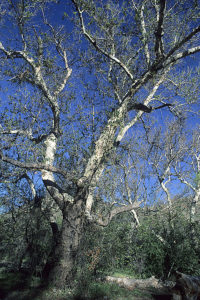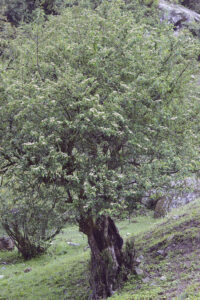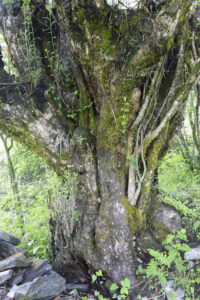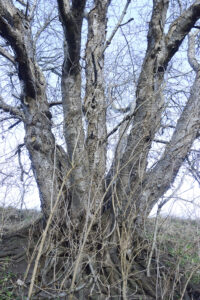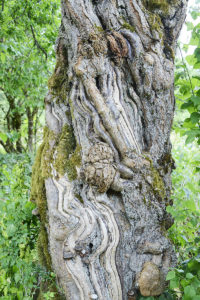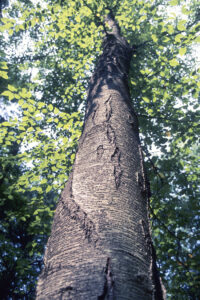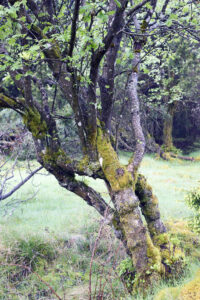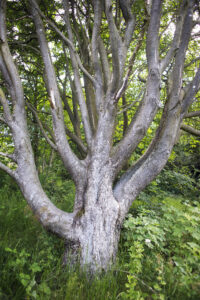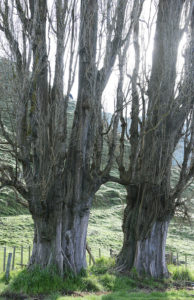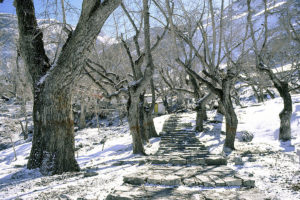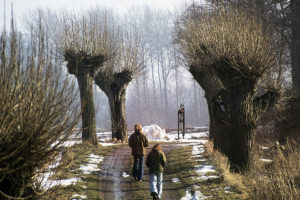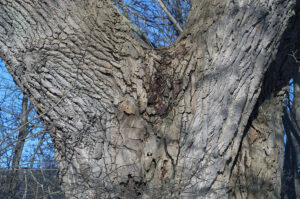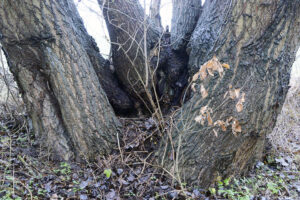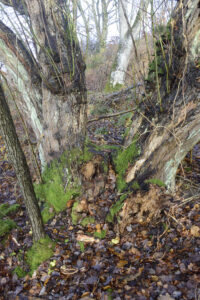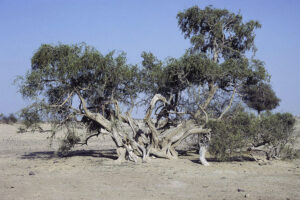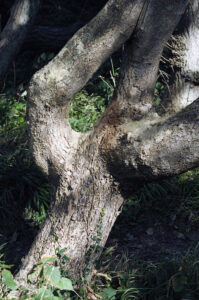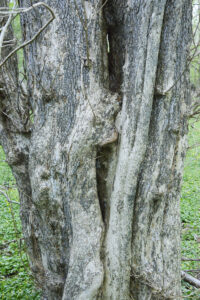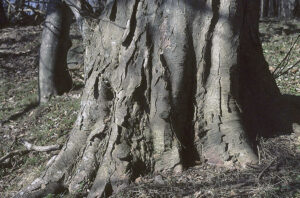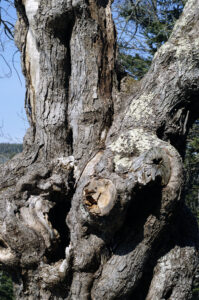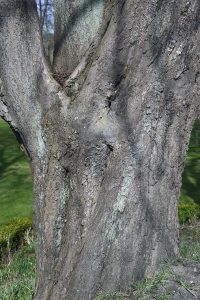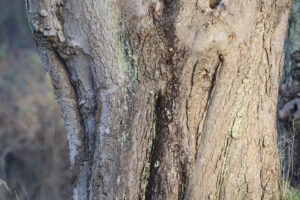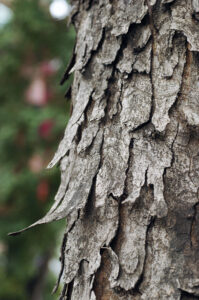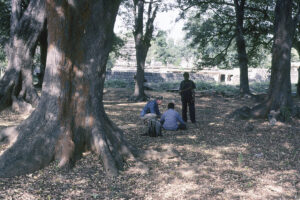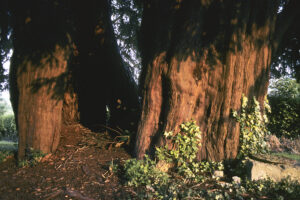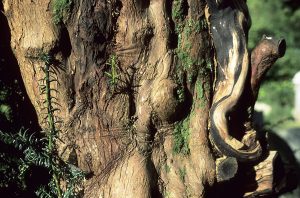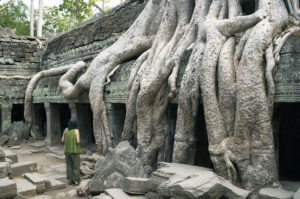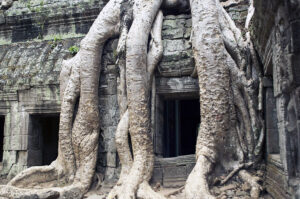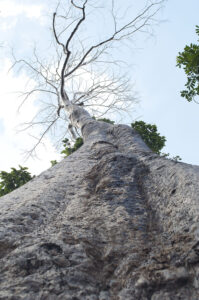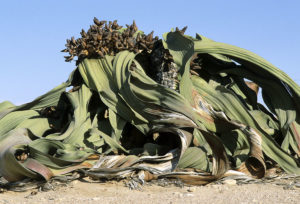Ancient and huge trees
Magnificent trunks of coast redwood (Sequoia sempervirens), soaring towards the sky, Humboldt Redwood State Park, California. (Photo copyright © by Kaj Halberg)
People, gathered at the foot of a huge tree, Myanmar. Many women and children in Myanmar smear a white paste, called thanaka, in their face to protect the skin against the sun, and it also makes the skin smooth. This paste is made from branches of the orange jessamine tree (Murraya paniculata). (Photo copyright © by Kaj Halberg)
Planted row of ancient cypresses, near Manchester, California. (Photo copyright © by Kaj Halberg)
For some reason or other, this stump of a giant tree has been allowed to remain in the middle of agricultural land near Ohakune, New Zealand. The stump ’lives’ on, as several bushes have taken root in its top. (Photo copyright © by Kaj Halberg)
The Chinese Hemlock Nature Trail leads through montane monsoon forest in Taipingshan National Forest, eastern Taiwan. In this picture, the trail is passing beneath the roots of an ancient tree. (Photo copyright © by Kaj Halberg)
The root net of a toppled conifer, photographed with a very wide-angled lens, Stora Sjöfallet National Park, Lapland, Sweden. (Photo copyright © by Kaj Halberg)
In 1902, when the Long Bien railway station in Hanoi, Vietnam, was built, this tree was spared, and the roof was built accordingly. Since then it has grown to huge dimensions, and today it functions as a Buddhist shrine inside the waiting hall. The areial roots of a strangler fig (Ficus) are wrapped around its trunk. (Photos copyright © by Kaj Halberg)
Fungi, growing on the trunk of a burned forest tree, Silent Valley National Park, Kerala, India. (Photo copyright © by Kaj Halberg)
Old and giant trees appeal to most people. Standing under a huge, gnarled trunk, thousands of years old, makes the majority of us feel very humble indeed.
In the old days, however, most people had an entirely different view of these giant beings. Everywhere on the planet, huge tracts of thousand-year-old forests were ruthlessly cut down by the lumber industry, or to make way for farming or urbanization. Numerous examples of this destructive behaviour are described on the page Folly of Man.
Even today, there are well-educated people who do not appreciate old trees. Danish author Thorkild Bjørnvig (1918-2004) once told me about an incident, which took place on his residential island, Samsø. One of the residents in the local community lived in a farmhouse, in front of which grew an enormous old horsechestnut tree (Aesculus hippocastanum). One day, Bjørnvig noticed that the tree had disappeared, and he asked the owner why. This was his answer: “For a long time, that tree has been a thorn in my flesh!”
Below, a number of trees are described, presented in alphabetical order according to family, genus, and species.
Altingiaceae
This family was named for the genus Altingia, which is now regarded as a synonym of Liquidambar – the only present genus in the family.
Liquidambar Sweetgum
A genus of 15 species of large, deciduous trees, 25-40 m tall, with palmately lobed leaves, which have a pleasant aroma when crushed. The leaves often attain brilliant colours in autumn and winter, including bright red, orange, yellow, and purple. Pictures depicting such leaves are shown on the page Autumn.
The fruit is a globular, woody capsule, to 4 cm across, covered in prickles, presumably an adaptation to being attached to the fur of animals, which then spread the seeds in this way. Pictures depicting the capsules are shown on the page Plants: Burs.
These plants were formerly placed in the witch-hazel family (Hamamelidaceae), but has now been transferred to Altingiaceae. They are found from north-eastern India eastwards to China, Taiwan, and Korea, and thence southwards through Indochina to Sumatra and Java, and also in the eastern United States, Mexico, and Central America, with an isolated species in south-western Turkey and on Rhodes. Several species are cultivated elsewhere as ornamental trees.
The generic name is derived from the Latin liquidus (‘fluid’) and the Arabic anbar, which, via the Moors, became ambar in Spanish and amber in English. The generic and common names both allude to the fragrant sap of several species of the genus, which was formerly used in the cosmetic industry.
Liquidambar styraciflua American sweetgum
This species, also known by a number of other popular names, including hazel pine, bilsted, redgum, satin-walnut, and alligator-wood, is native to south-eastern United States, and is also found in montane areas of southern Mexico and Central America. The leaves are almost star-shaped, with 5 to 7 pointed lobes, and the fruits are ball-shaped, hard, and spiky. A picture, depicting the colourful autumn foliage, is shown on the page Autumn.
The specific name is Latin, meaning ‘flowing with storax’ (a plant resin), like the generic name alluding to the gum.
A close relative, Chinese sweetgum (L. formosana), is presented on the page Autumn.
Deeply furrowed and corky bark of sweetgum, Point of Rocks Park, Richmond, Virginia. (Photo copyright © by Kaj Halberg)
Anacardiaceae Sumac family
Dracontomelon duperreanum Indochina dragonplum
An evergreen tree, to 20 m tall, with buttresses. The bark often peels off in flakes, creating a beautiful pattern on the trunk. The leaves are pinnately divided, with 11-15 alternate, oblong leaflets. Inflorescences are panicles with small bluish-white, bell-shaped flowers. The fruit is a globular yellow drupe, to 4 cm across.
It is distributed in southern China and northern Indochina, growing in forests up to elevations around 350 m.
The fruits are much utilized in the Vietnamese cuisine, as souring agent, or cooked with duck. After being preserved in sugar, it can be used to make a cooling drink.
The generic name is derived from Ancient Greek draco (‘dragon’) and melon (‘apple’), referring to the fruit.
Indochina dragonplum, Hanoi Botanical Garden, Vietnam. (Photo copyright © by Kaj Halberg)
Pistacia Pistachio trees
This genus, comprising about 11 species, is native to southern Texas, Mexico, Central America, southern Europe, northern and eastern Africa, and from the Middle East eastwards to China, Vietnam, and the Philippines.
The generic name is derived from pistakia, the Ancient Greek name of the true pistachio tree (P. vera).
Pistacia chinensis Chinese pistachio tree
This small tree is native from Afghanistan eastwards to Myanmar, China, and Taiwan, and thence southwards to the Philippines. A disjunct population is found in the Caucasus.
Due to its hardiness, and the attractive autumn foliage, it is widely cultivated in temperate and subtropical areas around the world. In warmer areas, it sheds the leaves in mid-winter. Pictures, depicting this winter foliage, are shown on the page Autumn.
Chinese pistachio tree is very commonly planted in parks and along streets in Taiwanese cities. This picture shows an old tree with peeling bark, Taichung. (Photo copyright © by Kaj Halberg)
Apocynaceae Dogbane family
Alstonia
A genus of evergreen trees and shrubs with about 45 species, distributed in tropical regions of Africa and Asia, New Guinea, Australia, Mexico, and Central America, with a core area in Malaysia and Indonesia. Some of the species grow very large, for instance A. pneumatophora, which may reach a height of 60 m, with a trunk diameter over 2 m.
The generic name honours Charles Alston (1685-1760), professor of botany in Edinburgh.
Alstonia scholaris Blackboard tree
This tree, also known by several other names, including devil tree, milkwood-pine, and white cheesewood, is found in mixed forests, from the Indian Subcontinent eastwards to south-western China, and thence southwards through Indochina, the Philippines, Indonesia, and New Guinea to northern Australia.
It grows to 40 m tall, with greyish bark, and young branches have numerous lenticels. The leaves, arranged in whorls of 3-10, are glossy-green above, greyish below, obovate, to 23 cm long and 8 cm broad, tip usually rounded. Flowers are white, tubular, to 1 cm long, in dense clusters. The fruit is a pod-like follicle, very narrow, to 40 cm long.
The bark contains a very bitter, milky sap. Bark and leaves are utilized medicinally for headache, influenza, bronchitis, and pneumonia, and the wood is used for making coffins.
The specific name is Latin, meaning ‘relating to schools’, alluding to the former usage of the wood for blackboards.
Bark of a huge blackboard tree, Taichung, Taiwan. According to Kew Gardens, this species is not native to Taiwan, but it is very commonly planted on the island. (Photo copyright © by Kaj Halberg)
Aquifoliaceae Holly family
Ilex Holly
This is the sole genus of the family, comprising about 480 species of evergreen or deciduous trees, shrubs, or climbers, distributed almost worldwide. The fruit is a berry-like drupe, containing 1 or 2 nuts.
In Ancient Rome, ilex was the name of the holm oak (Quercus ilex). In 1753, Swedish naturalist Carl Linnaeus (1707-1778) adopted this name as the generic name of hollies, probably due to the similarity of the leaves of the common holly (Ilex aquifolium) to those of the holm oak. The ancient name of holly was acrifolium, from Proto-Italic akris (‘sharp’) and the Latin folium (‘leaf’), which was later changed into aquifolium.
Ilex opaca American holly
A medium-sized evergreen tree, usually below 20 m high, but may occasionally grow to 30 m. The trunk diameter is less than 50 cm in most individuals, but may sometimes be up to 1.2 m. The leaves are quite similar to those of the common holly, but less glossy.
It is native to the eastern United States, from Massachusetts and southern New York State southwards to northern Florida, and thence westwards to eastern Oklahoma and eastern Texas.
The specific name is Latin, meaning either ‘growing in the shade’ or ‘giving shade’.
Trunk of an old American holly with lichens, Fire Island, Long Island, New York State. (Photo copyright © by Kaj Halberg)
Araucariaceae Araucaria family
Agathis Kauri trees
Kauris, together with members of the genus Araucaria (below), belong to an ancient group of trees, which first appeared during the Jurassic period (190 to 135 million years ago).
Mature trees have straight trunks, in some species to 60 m tall, with little or no branching below the crown. The bark is smooth, pale grey or grey-brown, usually peeling into irregular flakes. Young leaves are often a coppery-red, varying in shape from ovate to lanceolate, whereas older leaves are green, elliptic to linear, leathery and thick. Female cones are huge, ovate or globular, maturing after 2 years.
These trees, altogether 17 species, are found in Malaysia, Indonesia, the Philippines, New Guinea, north-eastern Australia, and New Zealand.
Several species yield resin, called kauri gum. The durable timber is excellent for boat-building, and to make guitars and other items.
The generic name is Latin, denoting something notable or precious, derived from Ancient Greek agathon (‘a good thing’), originally from agathos (‘good’).
Agathis australis Southern kauri tree
This iconic species is restricted to the northernmost part of New Zealand’s North Island. It is among the world’s largest trees, growing to over 50 m tall, with trunk girths up to 16 m. Although their age is difficult to estimate, it is believed that they may live for more than 2,000 years.
Today, the largest kauri is found in Waipoua Forest. It is called Tane Mahuta (‘Lord of the Forest’), which refers to Tane, the Maori god of trees and birds. The height of this majestic tree is c. 46 m, its girth is about 15.5 m, and its volume is estimated at 516 m3. In the past, even larger specimens were known. The largest on record, called The Great Ghost, was about 8.5 m in diameter, with a girth of c. 26.9 m. It was consumed by fire around 1890.
When the Maoris settled in New Zealand about 700 years ago, small-scale usage of kauri began. The timber was utilized to construct houses and boats, and for carving. Kauri trees exude a gum through cracks in the trunks, and, over the years, large quantities are built up in the soil beneath the trees. The Maoris used this gum to start fires, and also for chewing, after it had been soaked in water and mixed with the milky juice of common sow-thistle (Sonchus oleraceus).
A full-scale destruction of these magnificent forests began with the arrival of Europeans in the 1700s and 1800s. Sailors found that the trunks of young kauri were ideal for ships’ masts and spars, and settlers utilized the high-quality timber of mature trees for construction. Kauri gum was also used at a large scale to manufacture varnishes and other products. The gum was obtained through digging or, more destructively, by bleeding live trees. Large areas of kauri forest were also cleared for farmland until as late as the mid-1900s.
It has been estimated that kauri forests once covered between 10,000 and 15,000 km2. Today, a tiny fraction, c. 70 km2, exists, corresponding to 0.5% of the original extent.
Now the kauri is facing a new threat, called kauri dieback. This disease is caused by a fungus, Phytophthora agathidicida, which attacks the trees through their shallow root system, eventually causing their death. There is no known cure for this disease, and its spread can only be reduced by avoiding trampling near kauri roots. (Source: doc.govt.nz/nature/native-plants/kauri)
The specific name is Latin, meaning ‘southern’.
The largest known kauri is Tane Mahuta (‘Lord of the Forest’), which may be more than 1,500 years old. (Photos copyright © by Kaj Halberg)
Araucaria
This genus contains 20 species, which occur in Chile, Argentina, and southern Brazil, in New Guinea and eastern Australia, and on a number of islands in the south-western part of the Pacific. No less than 14 species are endemic to New Caledonia.
Most species are large, with a massive, erect trunk, in some species reaching a height of 80 m. The branches grow in whorls, covered in leathery or needle-like leaves. Female cones are globular, the largest ones to 25 cm across. They contain up to 200 large, edible seeds. Male cones are cylindric, to 10 cm long and 5 cm wide.
The generic name was derived from the name of a Chilean tribe, the Araucanians, who ate the seeds of Araucaria araucana (below).
Araucaria araucana Pehuén, Chilean monkey-puzzle tree
Grand forests of this tree are ubiquitous in Conguillio National Park and a few other places in the Andes. Elsewhere, it is endangered. It is described in depth on the page Travel episodes – Chile 2011: The white forest.
Forest of pehuén, Conguillio National Park, Chile. (Photo copyright © by Kaj Halberg)
This gigantic pehuén, called Araucaria Madre (‘Mother of monkey-puzzle trees’), is about 1,800 years old, 50 m tall, and has a diameter of c. 2.1 m. – Conguillio National Park. (Photo copyright © by Kaj Halberg)
Arecaceae Palms
Jubaea chilensis Chilean palm
This stately tree, the only member of the genus, is endemic to a small area in central Chile. It may grow to 25 m tall, with a very thick trunk, sometimes up to 1.3 m in diameter. The dark green leaves are pinnate, to 5 m long, with pinnae to 50 cm long.
In a botanical context, a juba is a loose panicle, whose axis falls to pieces. Perhaps this is the case in this species. However, the name may also refer to King Juba II (c. 50 B.C. – 19 A.D.) of Numidia (in present-day Algeria and Tunisia), who had a great interest in plants and often described them.
A stronghold of the Chilean palm is La Campana National Park, where these pictures were taken. (Photos copyright © by Kaj Halberg)
Phoenix Date palms
A genus of 14 species, distributed from the Canary Islands and Africa across the Middle East, Arabia, and the Indian Subcontinent to Indochina and southern China, and thence southwards to the Philippines and Indonesia.
The generic name is derived from phoinikos, the Greek word for the cultivated date palm (P. dactylifera), used by Greek scholar and botanist Theophrastos (c. 371-287 B.C.), and also by Roman naturalist Pliny the Elder (23-79 A.D.). It may refer to the Phoenicians, or to Phoenix, son of Amyntor and Cleobule in Homer’s Iliad, or to the phoenix, the sacred bird of Ancient Egypt. (Source: U. Quattrocchi 2000. CRC World Dictionary of Plant Names)
Phoenix canariensis Canary Islands date palm
As its name implies, this species is endemic to the Canary Islands. It grows to 20 m tall, occasionally to 40 m, with pinnate leaves to 6 m long and with 80-100 leaflets on both sides of the central rachis. The fruit is an ovoid, yellow to orange drupe, to 2 cm long. It is edible, but not very tasty.
Old Canary Islands date palm, Barranco Mogán, Gran Canaria. The withered leaves, which remain on the trunk for several years, have been chopped off. (Photo copyright © by Kaj Halberg)
Washingtonia American fan palms
A small genus with only 2 species of fan palms, W. filifera, which is native to the Mohave and Colorado Deserts in southern California, northern Baja California, a few places in south-western Arizona, and W. robusta, which is endemic to north-western Mexico.
The generic name was given in honour of George Washington (1732-1799), the first president of the United States (1789-1797).
Washingtonia filifera California fan palm
An impressive fan palm, to 20 m tall, with a trunk diameter up to 1 m, and numerous huge, terminal, fan-shaped leaves, which may grow to 4 m long, with leaflets to 2 m. The leaf-stalk, to 2 m long, is heavily armed with sharp thorns. The inflorescence is huge, to 5 m long, with masses of white flowers, maturing into small blackish-brown drupes, to 1 cm across, with a thin layer of sweet flesh over a single seed.
The scattered growths thrive in oases with springs, but may also be found in drier areas.
California fan palms with hanging ‘bags’ of old leaves, Oasis of Mara, Joshua Tree National Park, California. (Photos copyright © by Kaj Halberg)
Betulaceae Birch family
Alnus Alder
This genus, comprising about 40 species of shrubs or trees, is distributed throughout the northern temperate zone, with a few species in Central America and the Andes. The fruits are very distinctive, woody, resembling diminutive cones.
The generic name is the classical Latin name of alders. Some authorities connect the name with High German elo (’greyish-yellow’), and with Sanskrit aruna (’reddish-yellow’), referring to the fact that the wood of common alder (below), when cut, assumes a bright reddish-brown colour. The common name evolved from the Old English word for these trees, alor, which in turn derived from Proto-Germanic aliso.
Alnus glutinosa Common alder
Also known as black alder, this species is native to the major part of Europe, south-western Asia, and northern Africa. It thrives in wet locations, living in symbiosis with a nitrogen-fixing actinomycete bacterium, Frankia alni. These bacteria cause the growth of coral-like nodules on the roots of the trees, inside which thick-walled cells are formed, housing the bacteria. Protected here against the harmful oxygen of the air, the bacteria change nitrogen into nitrates, which can be utilized by the alder trees. This is the reason that these trees are able to grow in oxygen-poor soils. The nitrates enrich the soil, making it possible for other plants to grow in these poor soils.
The specific name is derived from the Latin gluten (’glue’), alluding to the glutinous leaf buds and newly opened leaves.
Trunk of an ancient common alder, Funen, Denmark. Note the ceramic insulator to the right, almost overgrown by bark. (Photo copyright © by Kaj Halberg)
Lars Skipper, admiring an old common alder, growing at the shore of Lake Mossø, central Jutland, Denmark. (Photo copyright © by Kaj Halberg)
A row of old alders along Gudenåen River, central Jutland, Denmark. (Photo copyright © by Kaj Halberg)
Betula Birch
A genus with 50-60 species, distributed in temperate and subarctic areas of Europe, Asia, and the Americas. Male and female flowers are borne in catkins, in separate inflorescences, males pendulous, females erect. The fruit fragments into 3-lobed scales and winged nutlets when mature.
In Norse religion, the birch represented Freya, the Great Mother Goddess, and among Celtic peoples the star goddess, Arianrhod, whose caer (‘throne’) was situated in the Corona Borealis (Northern Lights). She was invoked through the birch to assist in births and initiations.
Previously, the soft birch wood was carved into numerous items, including furniture, cups, bowls, bobbins, cradles, and toys. The bark separates into thin strips, which peels off easily. It is tough, water proof and rot proof, making it perfect as roofing material. It was also utilized to make buckets, baskets, bottles, plates, and shoes, and for writing and drawing. Due to its content of volatile oils, rolled-up bark could be used as torches.
Danish author and artist Claus Bering (1919-2001) once sat on his terrace, writing, and from a large birch tree a lot of seeds and seed scales blew into his hair and his coffee. He was curious to know how many seeds a big birch tree like that would produce, so he chose a twig with average fertility. There were 12 female catkins on it. He plucked these 12 catkins, pulled them apart, and counted the number of seeds in each of them. On average they contained 350 seeds. Then he counted the number of branches on the tree, about 50, each having on average 32 twigs. Now the calculation was simple: 50x32x12x350 = 6.720.000 seeds. An impressive number!
The generic name is derived from Celtic betu (’glue’), referring to the fact that Celts extracted a glue-like substance from birch sap. In certain areas with Gaelic-speaking peoples, including Wales and Brittany, birch is still called bezuenn or bedwen. The name birch is derived from Proto-Germanic berko, in all probability rooted in Sanskrit bhurja, the name of a species of birch.
Betula alleghaniensis Yellow birch
This tree is widely distributed in south-eastern Canada and eastern United States, found from Minnesota eastwards to Newfoundland, southwards to Tennessee and northern Georgia. It is the provincial tree of Quebec.
It is a medium-sized, deciduous tree, growing to about 24 m tall, occasionally to 30 m, with a trunk diameter to 0.9 m, making it the largest North American birch species. It often becomes about 150 years old, and some specimens to 300 years have been reported.
The specific name alludes to the Allegheny Mountains, a part of the Appalachians, whereas the common name refers to the yellowish bark of this species.
The bark of this old yellow birch is peeling off in small strips, Kenoza Lake, Haverhill, Massachusetts. (Photo copyright © by Kaj Halberg)
Betula lenta Sweet birch, black birch
A medium-sized, deciduous tree, usually below 24 m tall, occasionally to 30 m and rarely to 35 m, with a trunk diameter up to 60 cm. On older trees, the bark cracks into irregular, scaly plates. The oldest known specimen was about 370 years old.
It is found from southernmost Ontario and southern Maine southwards through New England and the Appalachian Mountains to northern Georgia and Alabama.
The common name refers to the sap that can be tapped to make syrup. It is stronger than maple sap, and is mainly used to make birch beer. The inner bark may be eaten raw, but has been labelled ’emergency food’. Tea can be made from twigs and inner bark.
Peeling bark of an old sweet birch, Winnikenni Park, Haverhill, Massachusetts. (Photo copyright © by Kaj Halberg)
Betula papyrifera Paper birch
Paper birch with the snow-white bark is a medium-sized, deciduous tree, often growing to 20 m tall, occasionally to 40 m, with a trunk diameter up to 75 cm. The leaves are doubly serrated, with sharp teeth. It is a pioneer species, which often takes over an area that has burned or been cleared of other trees.
It is widely distributed in subarctic areas of North America, southwards to northern Montana, the Great Lakes area, and New England. It is the provincial tree of Saskatchewan and the state tree of New Hampshire.
The specific and common names refer to the fact that paper can be produced from the wood, which also make sexcellent firewood. The sap may be boiled down to produce syrup, which has a sugar content of about 1%.
Large paper birch, covered in frozen rain, Freeport, Maine. (Photo copyright © by Kaj Halberg)
Betula pendula Silver birch, warty birch
This species is very widespread and common in Eurasia, from Norway, Ireland, and Spain eastwards to eastern Siberia and Japan, southwards to the Balkans, Turkey, the Caucasus, Kyrgyzstan, and China. It has also been introduced to North America, where it is considered invasive in some parts. It forms forests in many regions, but may also grow singly in open areas.
It is typically between 15 and 25 m tall, occasionally to 30 m, the trunk usually under 40 cm across at breast height. The bark is golden-brown at first, later turning to white and peeling off in flakes. The base of old trees has numerous corky fissures. The twigs are slender and often pendulous, giving rise to the specific name. The leaves are heart-shaped, long-pointed, margin doubly toothed. They turn a lovely yellow in autumn.
The name silver birch refers to the white bark, which peels off in strips, whereas the name warty birch alludes to the twigs having a rough surface due to numerous resinous ‘warts’.
Old silver birch, Funen, Denmark. (Photo copyright © by Kaj Halberg)
As silver birches age, the colour of the bark on the lower part of the trunk changes from almost pure white to blackish. This one was encountered in central Jutland, Denmark. (Photo copyright © by Kaj Halberg)
Weeping birch is a cultivated form of silver birch with hanging branches. This old specimen is in the garden of the Boller Estate, near Horsens, Denmark. Ivy (Hedera helix) is climbing up the trunk. (Photo copyright © by Kaj Halberg)
Betula pubescens Downy birch
This species resembles silver birch (above), but may be identified by the downy twigs and leaf-stalks, margin of the leaves is singly, not doubly toothed, and the twigs are not hanging. Almost all older individuals are infested with a fungus, Taphrina betulina, which causes twigs to form large galls, popularly called witches’ brooms.
It is likewise widespread and common in Eurasia, but is more northerly, found from Iceland, Ireland, and Portugal eastwards to eastern Siberia, southwards to the Caucasus, northern Iran, and southern Siberia.
The specific name is derived from the Latin pubes (’downy’), like the common name alluding to the downy twigs.
In former days, birch populations in Arctic regions were regarded as a subspecies, tortuosa, of the downy birch. However, genetic research indicates that it evolved from hybridization between downy birch and dwarf birch, and today most authorities regard it as a variety of the former, named B. pubescens var. pumila.
Bark of an old downy birch, Ismanstorp, Öland, Sweden. (Photo copyright © by Kaj Halberg)
Betula utilis Himalayan birch
This large deciduous tree may grow to 35 m tall, but is much smaller and shrub-like at higher altitudes. It is easily identified by its white, brownish, or reddish bark, which peels off in very thin horizontal flakes. Lenticels are very numerous on trunk and branches. Branches red-brown, smooth, twigs downy, with dense resinous glands. The stalked leaves are ovate or oblong, smooth above, with resinous glands, to 10 cm long, 6 cm broad, woolly-hairy beneath when young, margin irregularly saw-toothed, tip pointed.
Inflorescences are yellowish, male catkins slender, to 10 cm long, appearing before the leaves. Female catkins are solitary or 2-3 together, to 5 cm long and 1.2 cm broad when in fruit. The nutlet is ovoid or ellipsoid, to 3 mm long, with membranous wings to 3 mm wide.
This species is very common in mountains, from Afghanistan eastwards to western China, often forming pure stands at altitudes between 2,500 and 4,300 m.
The specific name is Latin, meaning ‘useful’. Locally, the wood is used for building construction and as firewood. The bark is used as roof cover, and to make paper, and is also burned as incense. A paste of the bark is utilized for wounds and burns, a decoction of the bark for jaundice and earache, a paste of the resin for boils, and also as a contraception remedy. The foliage is lopped for fodder.
The reddish bark of Himalayan birch peels off in large, thin flakes. These older trees were encountered near Kyangjuma, Khumbu, eastern Nepal. (Photo copyright © by Kaj Halberg)
Carpinus Hornbeam
A genus with about 50 species of deciduous trees, distributed in Asia, Europe, and the Americas. No less than 27 species are endemic to China. Previously, this genus was placed in the now defunct family Corylaceae.
The generic name is the classical Latin name of hornbeams, probably derived from Proto-Indo-European kar (‘hard’), alluding to the hard wood of these trees. The common name is from Middle English hernbem, hern– of uncertain meaning and origin, bem a corruption of the German baum (‘tree’).
Carpinus betulus Common hornbeam
A medium-sized tree, often to 25 m tall, sometimes to 30 m, with smooth, greyish bark. Leaf buds are to 1 cm long, pressed close to the twig. The leaves resemble those of the common beech (Fagus sylvatica), to 9 cm long, with serrated margin. Male and female catkins appear after the leaves, pollination is done by wind. The fruit is a small nut, to 8 mm long, partially surrounded by a leafy involucre, to 4 cm long.
This species is found in the major part of Europe, from England, Denmark, and southern Sweden southwards to the Mediterranean, eastwards to western Russia, the Caucasus, and northern Iran.
The hard wood was formerly utilized for various items, including cog wheels in mills, pulleys on sailing ships, bottoms of planers, shoe trees, and hammers in pianos. Today, it is mostly used as excellent, slow-burning firewood.
The specific name is Latin, meaning ‘birch-like’, alluding to the catkins, which resemble those of birch trees (Betula).
The furrowed bark of an old hornbeam, Nature Reserve Vorsø, Horsens Fjord, Denmark. (Photo copyright © by Kaj Halberg)
Corylus Hazel
A genus with about 16 species of deciduous trees and large shrubs, widely distributed in Europe, from Ireland and Portugal eastwards to the Ural Mountains, and from Scandinavia and Finland southwards to the Mediterranean, the Caucasus, and Iran, in eastern Asia, from north-eastern China southwards to northern Indochina and the Himalaya, and in North America, from southern Canada southwards to southern United States.
Hazels have simple, rounded leaves with double-toothed margins. The flowers appear very early in spring, before the leaves. Male catkins are pale yellow, to 12 cm long, whereas the female catkins are very small, largely concealed in the buds, with only the bright-red, small styles protruding. The fruit is a nut, to 2.5 cm long and 2 cm wide, surrounded by a large, leafy involucre, called a husk, which encloses the nut partly or fully, depending on the species.
The generic name is the classical Latin word for hazel trees.
Previously, this genus was placed in the now defunct family Corylaceae.
Corylus avellana European hazel
This tree is found in the major part of in Europe, from Ireland and Portugal eastwards to the Ural Mountains, and from Scandinavia and Finland southwards to the Mediterranean, the Caucasus, and the Alborz Mountains in northern Iran.
Usually, it is a large shrub to about 10 m tall, sometimes to 15 m, typically with many slender trunks clustered together. It prefers sunny places, and specimens in forests are often low and stunted. The ovoid nut, to 2 cm long, is partly covered by the husk.
The specific name was given by Swedish naturalist Carl Linnaeus (1707-1778), who took this name from De historia stirpium commentarii insignes, published by German physician and botanist Leonhard Fuchs (1501-1566) in 1542, in which it was described as Avellana nux sylvestris (‘forest nut of Avella’, a town in southern Italy). In turn, that appellation was taken from Naturalis Historia, by Roman naturalist Pliny the Elder (23-79 A.D.).
The succession of a wild growth of common hazel is described on the page Nature Reserve Vorsø: Expanding wilderness.
The base of an ancient European hazel, Funen, Denmark. (Photo copyright © by Kaj Halberg)
Numerous trunks of an old European hazel, Zealand, Denmark. (Photo copyright © by Kaj Halberg)
Casuarinaceae Ironwood family
Casuarina Ironwood, she-oak
This genus, comprising about 14 species of trees, is native to the Indian Subcontinent, Indochina, the Philippines, Malaysia, Indonesia, New Guinea, Australia, and islands in the Pacific. Several species have been planted, or accidentally introduced, in many other places, where they easily become naturalized, and some species are now often regarded as invasive plants.
Photosynthesis of these plants is done by the green, soft, pendulous branchlets, and the leaves are reduced to scales, arranged in whorls of 5 to 20 around the branchlets. Male flowers are in spikes along the branchlets, whereas the female flowers sit in spikes on short flower-stalks, which look different from the true branchlets. The fruit is small and cone-like.
The generic name is derived from Casuarius, the Latin name of cassowaries, due to the resemblance of the branches to the feathers of these birds. Both common names refer to the durable wood of these trees. The strange term she-oak arose, when the quality of the timber was equaled to that of the English oak (Quercus robur).
Casuarina equisetifolia Coastal ironwood
This species is usually below 12 m tall, but may reach a height of 35 m under favourable conditions. The greyish bark is smooth on younger trees, but deeply furrowed on old trees. The branchlets may grow to 30 cm long.
It has about the same distribution as that of the genus, but has become naturalized in many countries and is considered a pest in Florida, Bermuda, and Hawaii.
The specific name means ‘with foliage like Equisetum’ (horsetail), which is somewhat erroneous, as the leaves of this plant are reduced to scales. It must be admitted, however, that the twigs look like horsetail plants.
Coastal ironwood has been extensively planted on Cretan beaches. This ancient specimen was observed on Preveli Beach. (Photo copyright © by Kaj Halberg)
This row of white-painted coastal ironwood trees was observed on the Rodopos Peninsula, Crete. (Photo copyright © by Kaj Halberg)
Celastraceae Bittersweet family
Euonymus Spindle tree, burning-bush
A large genus with about 130 species of deciduous or evergreen shrubs, small trees, or climbers. The fruit is a globular capsule, pink or white, which splits open to reveal the seeds, which are covered by a fleshy, orange or red layer. This fleshy layer attracts birds, which eat it, thereby dispersing the seeds in their droppings.
Most species are native to eastern Asia, with 50 species endemic to China. Others occur in Europe, northern Africa, Madagascar, Indonesia, New Guinea, eastern Australia, North America, Mexico, and Central America.
The generic name is derived from Ancient Greek eus (‘good’) and onoma (‘name’). It is not clear why Swedish naturalist Carl Linnaeus (1707-1778) applied this name to this genus. The name spindle tree stems from the former usage of the hard wood of the European spindle tree (below) to make spindles for wool-spinning, whereas the name burning-bush refers to the brilliant autumn foliage of several species.
Euonymus europaeus European spindle tree
This is a small tree, rarely reaching a height of 10 m, with a trunk to 20 cm across. It is widely distributed in Europe, from the British Isles, southern Scandinavia, and the Baltic countries southwards to the Mediterranean, eastwards to central Russia and the Caucasus. It mainly grows at forest edges.
The gorgeous fruits are red, pink, or purplish capsules, opening late in the autumn to reveal the black seeds, which are coated with a fleshy orange layer. These fruits look very inviting indeed, but the seeds contain highly toxic alkaloids, and several cases of poisoning of children have been reported.
The wood of this species is very hard and was formerly used to make butchers’ skewers and spindles for wool-spinning.
A close relative, the eastern burning-bush (E. atropurpureus), is presented on the page Autumn.
This old spindle tree has toppled, but is still full of life, Nature Reserve Vorsø, Horsens Fjord, Denmark. (Photo copyright © by Kaj Halberg)
Combretaceae Leadwood family
Terminalia Tropical almonds
A huge genus of large trees, counting about 280 species, distributed in tropical and subtropical regions around the world.
The generic name is from the Latin terminus (‘end’), referring to the fact that the leaves appear at the very tips of the shoots. Despite the common name, these plants are not even distantly related to the true almond (Prunus amygdalus). The name alludes to the fruits, which resemble almonds.
Several pictures, depicting the glorious winter foliage of the Indian almond (Terminalia catappa), are shown on the page Autumn.
Terminalia myriocarpa East Indian almond
This tree is typically between 15 and 25 m tall, but may grow to huge dimensions, to a height of 40 m, with a diameter up to 4 m, and with large buttresses, sometimes to 5 m tall. The bark is grey and smooth, flaking with age. The leaves are elliptic, to 20 cm long, dull green, finely toothed along the margins. The flowers are small, pale yellow, in slender, terminal clusters. The fruit is small, initially green, becoming bright pink when mature.
It is distributed in forests, from eastern Nepal eastwards to southern China, and thence southwards through Indochina to Sumatra. In the Himalaya, it may be found up to elevations around 1,700 m.
It is sometimes cultivated as an ornamental. The wood is used as timber for construction of houses, floors, and boats.
The specific name is derived from Ancient Greek myrios (‘ten thousand’) and karpos (‘fruit’).
This magnificent East Indian almond in Cuc Phuong National Park, Vietnam, has been dubbed ‘Thousand-year-old tree’. Mosses and algae are growing on the trunk. (Photo copyright © by Kaj Halberg)
Cupressaceae Cypress family
Calocedrus Incense-cedars
A small genus of 4 conifers, one native to western North America, 3 to eastern Asia.
These trees are rather closely related to members of the genus Thuja (below), with similar overlapping scale-like leaves, but the leaves are in what looks like whorls of 4 (in reality 2 x 2), not evenly spaced apart as in Thuja, instead with the successive pairs closely, and then distantly spaced. Calocedrus cones have only 2-3 pairs of erect scales, rather than 4-6 pairs of very thin scales in Thuja.
The generic name is derived from Ancient Greek kallos (‘beautiful’), and Cedrus, the generic name of true cedars (see below under Pinaceae).
Calocedrus decurrens Californian incense-cedar
Formerly called Libocedrus decurrens, this large conifer, growing to about 57 m tall, may have a trunk diameter up to 3 m. Before settlers started logging at a large scale, trees reportedly reached 69 m, with a diameter of 4 m. It grows very slowly, but can reach an age of more than 500 years.
It is distributed from Oregon southwards through California and western Nevada to northern Baja California.
Indigenous tribes utilized it for numerous purposes, the bark to construct temporary conical-shaped huts and also more permanent houses, and to produce fire by friction. Hunting bows and baskets were made from thin branches. It was also used medicinally for stomach problems.
On old incense-cedars, the bark is deeply furrowed and up to 15 cm thick. This old specimen was photographed in Kings Canyon National Park, Sierra Nevada, California. The small holes in the bark were probably drilled by a sapsucker (Sphyrapicus). (Photo copyright © by Kaj Halberg)
Chamaecyparis False cypresses
A genus of about 6 species of evergreen conifers, 2 in Japan, 2 in Taiwan, one in eastern United States, and one along the Pacific coast, from California north to Washington. Full-grown trees vary in size from 20 to 70 m. Individuals up to a year old have needle-like leaves, whereas older specimens have scale-like leaves. The cones are globular or ovoid, with 8-14 scales, each bearing 2-4 small seeds.
The generic name is derived from Ancient Greek khamai (‘near the earth’) and kyparissos (‘cypress’) – an odd name, considering that some of these trees can attain heights of 70 m.
Two species are native to Taiwan, the red false cypress and the yellow false cypress, both presented below.
Following the Sino-Japanese war of 1894, Taiwan was ceded to Japan and became a Japanese colony. In 1912, the Japanese government began large-scale logging of false cypresses in the Alishan area, and where the Alishan Mountain Railway today passes through areas at higher elevations, cypress forests once covered the entire landscape.
Soon, the forests on Taiping Shan, Ilan County, and Pahsien Shan, Nantou County, were also opened up for logging, and later also many other areas. An endless stream of cypress logs flowed out of the mountains, to be transported across the sea to Japan, where they were used for various purposes, including pillars for Shinto shrines.
Early surveys estimated that, before logging began, about 20 million ancient false cypresses were found in Taiwan. Of the approximately 300,000 false cypresses at Alishan, which were more than 1,000 years old, all that remains today is a few giant trees, scattered among introduced Japanese red cedar (Cryptomeria japonica).
Large-scale logging of these magnificent trees was continued, even after the Japanese left Taiwan in 1945 – in fact, right up to 1989. Today, the only larger areas of ancient false cypresses are forests on Hsiukulan Shan, central Taiwan, and on Chilan Shan, Ilan County. (Source: Chang Chin-ju, Ancient Giants of the Forest – Taiwan’s False Cypresses)
Chamaecyparis formosensis Red false cypress
A magnificent tree, endemic to Taiwan, where it grows in the central mountains in areas of high precipitation, at elevations between 1,000 and 2,900 m.
This species is slow-growing, but when left in peace it may live for at least 2,000 years and grow to enormous dimensions, to 60 m tall with a trunk diameter up to 7 m. The bark is reddish-brown, vertically fissured. Adult leaves are scale-like, to 3 mm long, tip pointed, green above and below, with an inconspicuous band of pores at the base, in which respect it differs from yellow false cypress (below). Leaves on young plants are needle-like, to 8 mm long, soft and bluish-green. The cones are ovoid or oblong, to 1.2 cm long and 8 mm across.
It is threatened by habitat loss and excessive felling for its valuable timber.
In 1544, when the Portuguese first saw Taiwan from the sea, they named it Formosa (‘beautiful’). Since then many plants and animals, which were described from specimens collected on the island, were named various forms of this word.
The oldest and largest red cypress in Alishan National Forest, about 2,000 years old, height 43.5 m, circumference 13 m. (Photo copyright © by Kaj Halberg)
Red cypress, c. 1,000 years old, Alishan National Forest. (Photo copyright © by Kaj Halberg)
These red cypresses in Alishan National Forest are called ‘Three Generations Trees’. The first generation is a decayed trunk, lying on the ground. A seed sprouted in this trunk and lived for several hundred years before dying. A third tree has sprouted in the remains and is now a vigorous tree. (Photo copyright © by Kaj Halberg)
Stump of an old red cypress, Alishan National Forest. (Photo copyright © by Kaj Halberg)
The lower part of the trunk of an ancient red cypress, Dasyueshan National Forest. (Photo copyright © by Kaj Halberg)
Two red cypresses in Yushan National Park, named the Fuci Trees, were killed by a forest fire in 1963. The dried-out trunks remained standing for many years, but one of them fell in 2019. (Photo copyright © by Kaj Halberg)
This trail in Alishan National Forest has been worn by so many visitors’ feet that the roots of a red cypress has appeared on the surface. (Photo copyright © by Kaj Halberg)
Chamaecyparis taiwanensis Yellow false cypress, Taiwan cypress
This tree, by many authorities regarded as a subspecies, formosana, of Japanese false cypress (C. obtusa), is native to the mountains of Taiwan, where it grows in areas of high rainfall and air humidity, at altitudes between 1,300 and 2,800 m, whereas C. obtusa is primarily found on drier mountain tops.
Yellow false cypress grows to 40 m tall, with a trunk diameter up to 2 m. The bark is reddish-brown, vertically fissured. Older leaves are scale-like, to 1.5 mm long, green above and below, the underside with a white band of pores at the base, in which respect it differs from red false cypress (above), tip acute (unlike the blunt tip on leaves of C. obtusa). Leaves on seedlings are needle-like, to 8 mm long. Female cones are globular, to 9 mm across (smaller than those of C. obtusa).
An essential oil, named Taiwan Hinoki, is obtained from twigs and wood. This oil is valued for its ability to kill harmful bacteria, viruses, and fungus. It is also excellent for respiratory problems, blocked sinuses, high blood pressure, and skin diseases. Research indicates that its fragrance can effectively release tension and stress.
The wood is excellent for construction and furniture. The species is protected by law and may only be harvested with special permission, but in recent years there has been several cases of trees being cut illegally.
Yellow cypresses, 600-700 years old, Mingchih National Forest. The lower picture shows a close-up of the bark, with a climber. (Photos copyright © by Kaj Halberg)
Cunninghamia
A genus with one or two species, depending on authority. Some regard C. lanceolata, which is found in southern China, as a separate species, others consider it a subspecies of C. konishii (below).
Apparently, the generic name honours two persons, Scottish physician James Cunningham (died 1709), who introduced this genus into cultivation in 1702, and British botanist Allan Cunningham (1791-1839), who collected plants in Brazil and Australia. In 1839, he died of consumption in Sydney, only 47 years old.
Cunninghamia konishii Lunta spruce
A very large tree, growing to 50 m tall, with a trunk diameter up to 3.5 m, crown conical or pyramidal, dark green. Bark dark grey, dark brown, or reddish-brown, with deep fissures on older trees, which crack into flakes and thereby exposing the aromatic, yellowish or reddish inner bark. The needles are stiff, linear-lanceolate, arranged in dense spirals, glossy dark green above, to 6.5 cm long and 5 mm wide. Male cones are broadly obovoid, to about 2 cm long, sitting in groups of 8-20, female cones ovoid, to 3 cm long and wide, scales spreading at maturity.
In the wild, its occurrence is restricted to Taiwan, the Fujian Province in south-eastern China, and a few locations in northern Laos and Vietnam. According to the IUCN Red List of Threatened Species (2017), it is endangered in the wild.
The specific name is a Japanese surname, but I have not been able to find out who is being honoured. The English name refers to a mountain in Taiwan, Luan Ta, where this species was first found in 1908.
This huge Lunta spruce in Taroko National Park, Taiwan, called ‘Pilu Sacred Tree’, is about 3,200 years old, 50 m high, and has a trunk diameter of about 3.5 m. (Photos copyright © by Kaj Halberg)
Lichens grow on the furrowed bark of this Lunta spruce in Malabang National Forest, Hsinshu, northern Taiwan. (Photo copyright © by Kaj Halberg)
Cupressus Cypress
About 15 species of these grand trees are distributed from the Mediterranean eastwards across the Middle East and the Himalaya to southern China and northern Indochina. Previously, a number of North American trees were included in this genus, but have now been transferred to the genus Hesperocyparis (below).
The generic name is derived from Ancient Greek kyparissos, the classical word for the Mediterranean cypress (C. sempervirens).
Cupressus torulosa Himalayan cypress
This magnificent tree may grow to 45 m tall, with a diameter up to 3.5 m, with spreading branches and drooping branchlets. The leaves are scale-like, triangular, to 1.8 mm long, with white margins, densely overlapping. The bark often peels off in large strips. When young, the cones are bluish, globular, to 2 cm long and 1.8 cm wide, grey when older, scales separating, when the fruit dries out.
It is distributed from Kashmir eastwards through the Himalaya to south-eastern Tibet, growing in dry areas, mostly on calcareous soil, at altitudes between 1,800 and 3,300 m. Its foliage is often burned as incense in Hindu and Buddhist shrines.
The specific name is derived from the Latin torulus, diminutive of torus (‘swelling’), presumably alluding to the furrowed bark.
Two magnificent specimens of Himalayan cypress, Upper Kali Gandaki Valley, Mustang, central Nepal. (Photo copyright © by Kaj Halberg)
Hesperocyparis Western cypresses
These trees, comprising about 16 species, were formerly placed in the genus Cupressus (above). They are distributed from extreme western and southern United States southwards to Costa Rica. Most of the species have a very restricted range, and only a few are widely distributed.
The generic name is derived from Ancient Greek hesperos (‘western’) and kyparissos, the classical word for cypress.
Hesperocyparis macrocarpa Monterey cypress
This tree, previously known as Cupressus macrocarpa, is native to central California, formerly growing only on two small locations, Point Lobos State Park and Pebble Beach, both in Monterey County, south of San Francisco. Today, however, it has been planted in many other areas along the Pacific Coast, and also in Europe, New Zealand, South Africa, and elsewhere.
Due to the strong winds that blow in its native area, this species often becomes stunted, with an irregular trunk and a flat-topped crown. In sheltered places, it may grow up to 40 m tall, with a trunk diameter up to 2.5 m. The foliage is bright green, smelling of lemons when crushed. The leaves on older trees are scale-like, to 5 mm long, whereas young trees up to one year old have needle-like leaves, to 8 mm long. Male cones are very small, to 5 mm long, whereas female cones are globular or oblong, to 4 cm long, with 6-14 scales.
The specific name is derived from Ancient Greek makros (‘long’) and karpos (‘fruit’).
Both of these ancient Monterey cypresses were encountered in Point Lobos State Park. In the lower picture, the trunk is covered in an orange alga, Trentepohlia aurea. (Photos copyright © by Kaj Halberg)
Hesperocyparis pygmaea Mendocino cypress
This tree, formerly known as Cupressus pygmaea, is restricted to a very small area around Mendocino, north of San Francisco, California. Its foliage is dull green, with scale-like leaves, to 1.5 mm long, in trees more than one year old, whereas seedlings have needle-like leaves, to 1 cm long. The cones are small, to 2.5 cm long.
The status of this species is disputed. Some authorities, including Kew Gardens, regard it as a separate species. Others maintain that it is a mere variety of the more widespread Gowen cypress (H. goveniana).
Under all circumstances, not much is pygmy-like about this tree, as it may be able to grow to a height of 43 m, with a diameter exceeding 2 m. The specific name may refer to the small cones.
The trunk of an old Mendocino cypress, illuminated by the evening sun, Laguna Point, Mackerricher State Park, California. (Photo copyright © by Kaj Halberg)
Juniperus Juniper
This genus of c. 60 species of trees and shrubs is distributed in almost the entire Northern Hemisphere. The cone is berry-like, with an outer fleshy, leathery layer. Foliage of junipers is often burned as incense at Buddhist and Hindu shrines.
There are various theories as to the origin of the generic name. Some authorities claim that it stems from the Latin iungere (’tie together’ or ’weave’), referring to the use of its branches in baskets and fences, whereas others maintain that it is derived from juvenis (’young’) and parere (’to produce’), referring to the fact that juniper bushes constantly are renewed by new shoots.
The words gin and genever are derived from Juniperus, attesting to the usage of juniper fruits in these beverages.
Juniperus communis Common juniper
This is the most widespread conifer in the world, found in almost the entire northern subarctic and temperate zones, southwards to North Africa, northern Iran, the Himalaya, Japan, and Arizona.
It may grow to a large shrub, but is often prostrate, and may at once be identified by it needle-like leaves, to 1.3 cm long, which have a sharp point. The cone, to 8 mm across, is bluish-black when ripe, often with a bloom.
Common juniper is much utilized in folk medicine, and also plays a substantial role in folklore, described on the page Plants: Plants in folklore and poetry.
The specific name is Latin, meaning ‘common’.
This old juniper in central Jutland, Denmark, has toppled, and the trunk is covered in mosses, but it is still full of life and growing vigorously. (Photos copyright © by Kaj Halberg)
Juniperus indica Black juniper
This high-altitude species is often a shrub, but at lower altitudes it may grow into a tree, up to 20 m tall. It has two kinds of leaves: on younger individuals, and sometimes also on lower branches of older specimens, the leaves are awl-shaped, to 6 mm long, whereas those on older branches are scale-like, to 1.5 mm long, densely overlapping in four ranks, which gives the branch a smooth appearance. The cone is brown when young, later shining blue or black, to 1.3 cm across.
This species is found at altitudes between 2,100 and 5,200 m, from Pakistan eastwards through the Himalaya to south-western China. Its foliage is burned as incense in Hindu and Buddhist shrines, and the fruit is utilized in traditional medicine for fever and headache.
This old and gnarled black juniper was photographed at an altitude of c. 3,600 m, Marsyangdi Valley, Annapurna, central Nepal. (Photo copyright © by Kaj Halberg)
Juniperus osteosperma Utah juniper
A shrub or a small tree, growing to 6 m, rarely 9 m tall. It is native to western United States, from southern Montana, Idaho, and Wyoming southwards to eastern California, Arizona, and western New Mexico. It grows in dry areas, at elevations between 1,300 and 2,600 m. Its cones are berry-like, to 1.3 cm across, bluish-brown, with a whitish waxy bloom.
In former days, Native Americans used the bark for a variety of purposes, including beds, and ate the cones both fresh and in cakes. The gum was smeared on wounds as a protective covering. Tea made from the leaves was given to women to calm their contractions after giving birth. The Navajo would sweep their tracks with boughs from the tree, so that death would not follow them.
The specific name is derived from Ancient Greek osteon (‘bone’) and sperma (‘seed’), alluding to the hard seeds of this species.
Old Utah junipers often have strongly distorted trunks. These were observed in Canyon de Chelly National Monument, Arizona (top), and Inyo National Forest, White Mountains, California. (Photos copyright © by Kaj Halberg)
This stunted Utah juniper in Canyonlands National Park, Utah, has only a 10 cm wide strip of bark on the left side. (Photo copyright © by Kaj Halberg)
Juniperus pseudosabina Turkestan juniper
This shrub or small tree may reach a height of 10 m. It is native to mountains of Central Asia, found in south-central Siberia, Xinjiang, western Mongolia, eastern Kazakhstan, Kyrgyzstan, Tajikistan, north-eastern Afghanistan, and northern Pakistan, growing at altitudes between 2,000 and 4000 m.
The specific name is derived from Ancient Greek pseudes (‘false’) and sabina, the specific name of the savine (Juniperus sabina). Thus, the name means ‘the false savine’, presumably due to its similarity to the savine.
Lene Smith, standing at two ancient Turkestan junipers, growing over rocks, Yrdyk Valley, Kyrgyzstan. (Photo copyright © by Kaj Halberg)
Juniperus recurva Drooping juniper
This species may grow into a tree, up to 20 m tall, but at higher altitudes it becomes a low shrub, often covering large areas. The bark is grey-brown, peeling off in thin strips. The growth is rather lax, and outer branches are often drooping and slightly recurved, hence the specific and common names. Leaves are awl-shaped, to 8 mm long, in whorls of 3, more or less adpressed to the branch and loosely overlapping. The cone is brown when young, later black, shining, ovoid, to 1.3 cm long.
It is distributed from Pakistan eastwards across the Himalaya and southern Tibet to Myanmar and the Yunnan Province, at elevations between 1,800 and 4,600 m.
Wood and foliage are burned as incense at Buddhist shrines.
Strictly speaking, the specific name means ‘bent backwards’ in the Latin. However, in this connection it means ‘bent downwards’, alluding to the pendulous branches.
A growth of magnificent old drooping junipers near the Pangboche Monastery, Khumbu, eastern Nepal. These trees are sacred to the local Tibetan Buddhists – a remnant of the animist Bon religion, in which trees, prominent rocks, etc. were worshipped. This belief dominated in Central Asia prior to the introduction of Buddhism. This subject is described at length on the page Religion: Animism. (Photo copyright © by Kaj Halberg)
Juniperus virginiana Eastern redcedar, eastern juniper
This juniper is native to eastern North America, found from North Dakota and extreme south-eastern Canada southwards to Texas and Florida. It is a slow-growing conifer, usually below 20 m tall, with a trunk diameter up to 1 m, but on rare occasions up to 27 m tall with a diameter of 1.7 m. On poor soils it is low and stunted. The oldest specimen reported was about 940 years old.
Despite the name redcedar this tree is not related to true cedars of the genus Cedrus (see below).
Trunk of an old eastern redcedar, Parker River National Wildlife Refuge, Massachusetts. (Photo copyright © by Kaj Halberg)
Libocedrus
A small genus with 5 species of conifers, native to New Zealand and New Caledonia. The leaves are scale-like, to 7 mm long, in what looks like whorls of four. The cones are up to 2 cm long, with two pairs of rather thin, erect scales, each scale with a spine, to 7 mm long.
The etymology of the generic name is disputed. Some authorities maintain that it is derived from Ancient Greek libos (‘tear’) and kedros (‘cedar’), referring to the resin that oozes from the trunk. Others suggest that it is derived from the Greek libanos (‘incense’), and again kedros.
Libocedrus bidwillii New Zealand cedar
As its name implies, this species is restricted to New Zealand, where it grows in temperate rainforests at altitudes between 250 and 1,200 m. It is listed as near-threatened, and, apart from logging, the main threat is from browsing Australian brushtail possums (Trichosurus vulpecula), which may sometimes kill cedars. This introduced pest is presented on the page Nature: Invasive species.
It was named in honour of British botanist and explorer John Carne Bidwill (1815-1853), who investigated plant life in New Zealand and Australia, discovering several species new to science. In 1851, while marking out a new road in Queensland, Bidwill got lost and was without food for eight days. He eventually succeeded in cutting a way through the scrub with a pocket hook, but never properly recovered from starvation, and died in March 1853, 38 years old. (Source: Serle, P. 1949. Bidwill, John Carne (1815-1853). Dictionary of Australian Biography. Angus & Robertson)
Old New Zealand cedars, Tongariro National Park, New Zealand. Presumably, the lump on the trunk in the lower picture has been caused by fungi. (Photos copyright © by Kaj Halberg)
Metasequoia glyptostroboides Dawn redwood
This genus was described as fossils in 1939. However, in 1942 Chinese botanist Toh Gan discovered an unusual conifer in Lichuan County, Hubei Province. The locals called this tree 水杉 (‘water fir’). In 1942, specimens were collected, and, as it turned out, it belonged to the same genus as the described fossil tree of 1939.
This discovery caused a sensation in botanical circles around the world, and the species was called ‘a living fossil’. It is a large tree, growing to 50 m tall, and it is among the few conifers shedding its foliage in winter. Today, it is a popular ornamental in cooler areas around the globe.
The generic name is composed of Ancient Greek meta (‘near’), and the genus name Sequoia (Californian redwood, below), indicating that it is closely related to that species. The specific name is composed of the genus name Glyptostrobus (Chinese swamp cypress), and the Greek eides (‘like’), thus ‘resembling Chinese swamp cypress’.
An old dawn redwood, Maudslay State Park, Massachusetts. (Photos copyright © by Kaj Halberg)
Bark of an old dawn redwood, eastern Jutland, Denmark. (Photos copyright © by Kaj Halberg)
Sequoia sempervirens Coast redwood
The tallest tree in the world, reaching a height of up to 115 m. It is also among the longest-living trees, some individuals being more than 1,800 years old. Before commercial logging began in the 1850s, this tree occurred in the wild along coastal California (excluding the southernmost parts), northwards to the south-western corner of Oregon. Today, it is restricted to rather scattered locations, from Monterey County, south of San Francisco, northwards to extreme south-western Oregon.
This species was originally named Taxodium sempervirens in 1824 by Scottish botanist David Don (1799-1841), but was moved to a new genus, Sequoia, in 1847 by Slovakian-born Austrian botanist, numismatist and sinologist Stephan Ladislaus Endlicher (1804-1849), also known as Endlicher István László, who was director of the Botanical Garden in Vienna. He never explained the reason for choosing this name. The specific name is derived from the Latin semper (‘always’) and virens (‘green’), thus ‘evergreen’.
Magnificent forest of coast redwood, Humboldt Redwood State Park, California. (Photos copyright © by Kaj Halberg)
Lars Skipper (upper picture) and I seem like midgets, compared to the size and grandeur of these fallen, partly decayed trunks of coast redwood, Humboldt Redwoods State Park. (Photos copyright © by Kaj Halberg)
Sequoiadendron giganteum Giant sequoia
In the wild, this relative of the coast redwood is found only in the Sierra Nevada Mountains of California. Specimens of this tree are the heaviest living beings on the planet, the largest ones having an estimated weight of c. 2,100 tons.
The following quote of Scottish-American writer and environmentalist John Muir (1838-1914), from 1870, is cited in the book John Muir: His Life and Letters and Other Writings, edited by T. Gifford, Mountaineers Books, 1996: “Do behold the King in his glory, King Sequoia! Behold! Behold! seems all I can say. Some time ago I left all for Sequoia and have been and am at his feet, fasting and praying for light, for is he not the greatest light in the woods, in the world? Where are such columns of sunshine, tangible, accessible, terrestrialized?”
Most people of that period did not share Muir’s enthusiasm. Despite the fact that their wood is fibrous and brittle, and of little use for construction, thousands of these magnificent trees were ruthlessly cut down, between the 1880s and 1924, even though their commercial value was marginal. The heavy trees would often shatter when they hit the ground, and it has been estimated that as little as 50% of the timber came to use. The wood was utilized mainly for shingles and fence posts, or even for matchsticks. – Imagine! From grand tree to matchstick!
Today, fortunately, felling of this species is strictly forbidden, and a few magnificent groves have been saved.
The generic name is composed of the genus name Sequoia (Californian redwood, above), and Ancient Greek dendron (‘tree’).
Other pictures, depicting these impressive trees, may be seen on the page Plants: Plants of Sierra Nevada.
Giant sequoias, Giant Sequoia National Park, Sierra Nevada Mountains, California. (Photos copyright © by Kaj Halberg)
Standing next to a giant sequoia, people appear like midgets. (Photo copyright © by Kaj Halberg)
Due to their thick, spongy bark, giant sequoias can withstand forest fires. However, there are limits to this resistance. In these pictures, two of the trees have succumbed. (Photos copyright © by Kaj Halberg)
In the 1930s, this giant sequoia was dubbed ‘Auto Log’, because its trunk was levelled, making it possible for cars to drive on it. This picture shows the root net of this tree. (Photo copyright © by Kaj Halberg)
Likewise in the 1930s, a road was cut through the trunk of this giant sequoia in Mariposa Grove, Yosemite National Park. Today, fortunately, this type of vandalism is strictly prohibited. (Photos copyright © by Kaj Halberg)
Thuja Thuja, white-cedar, red-cedar, arborvitae
This genus contains 5 species, 3 in eastern Asia (China, Korea, and Japan), and 2 in North America. They are evergreen trees with reddish-brown bark, the largest growing to 70 m tall. The shoots are flat, leaves scale-like, to 1 cm long, but seedlings in their first year have needle-like leaves.
The generic name is derived from thuia, the Ancient Greek name of the stinking juniper (Juniperus foetidissima), originally from thuo (‘I sacrifice’), relating to the fact that wood of this species was often burned with animal sacrifices by the ancients to add a pleasing aroma to the fire. Why Swedish naturalist Carl Linnaeus (1707-1778) applied the name to this genus is not clear. Maybe he found that the foliage resembled that of the stinking juniper.
Despite the names red-cedar and white-cedar, these trees are not related to the true cedars (Cedrus) of the Old World. The name arborvitae is Latin, meaning ‘tree of life’, stemming from the medicinal properties of these trees.
Thuja occidentalis Northern white-cedar, eastern arborvitae
A medium-sized tree, normally growing to a height of about 15 m, with a trunk diameter of up to 1 m. However, trees up to 38 m tall with a trunk diameter of 1.8 m have been observed. It is often stunted or prostrate in less favourable locations. The bark is reddish-brown and furrowed, peeling off in narrow, longitudinal strips.
It is distributed in south-eastern Canada and north-eastern United States, with scattered occurrence along the Appalachians southwards to Tennessee and North Carolina. It is widely cultivated elsewhere as an ornamental plant.
Trunks of old northern white-cedars, Lake Champlain, New York (top), and Parker River Wildlife Refuge, Massachusetts. (Photos copyright © by Kaj Halberg)
Thuja plicata Western red-cedar, giant arborvitae
A massive tree, sometimes growing to 70 m tall, with a trunk diameter up to 7 m, mainly growing in areas with a mild climate and high rainfall, in valleys and along streams. It may grow very old, some individuals being more than 1,000 years old.
It is native along the Pacific coast in south-western Canada and north-western United States, but is widely cultivated elsewhere as an ornamental, especially in northern Europe and New Zealand.
Previously, indigenous peoples used the wood of this species for canoes, totem poles, tools, and other items. Fibers from the bark was used to produce rope, baskets, clothing, and rain hats. Today, because of its aroma and resistance to rot, the wood is used for construction of shingles and siding.
The specific name is Latin, meaning ‘folded’, presumably alluding to the fan-like foliage.
This huge western red-cedar with multiple trunks grows in a park on the island of Lolland, Denmark. Lotte Møller Pedersen, who is peeping out behind one of the trunks, gives an impression of its size. (Photo copyright © by Kaj Halberg)
Dipterocarpaceae
Dipterocarpus
About 70 species of large trees, to about 55 m tall, occurring from the Indian Subcontinent eastwards to south-western China, and thence southwards through Indochina and Malaysia to Indonesia and the Philippines.
Many species are utilized for timber, and some were formerly used in traditional herbal medicine.
The generic name is derived from Ancient Greek di (‘two’), pteron (‘wing’), and karpos (‘fruit’), alluding to the two-winged fruit (see picture below).
Dipterocarpus alatus
A large evergreen tree, to 40 m tall, occasionally even to 55 m, with a straight, cylindric bole up to 1.5 m in diameter, often branchless up to 20 m, and with an umbrella-like crown. It is distributed in Bangladesh, north-eastern India, Indochina, and the Philippines.
This species is one of the most important timber trees of Indochina and is extensively logged commercially. It is threatened by habitat loss, listed as endangered in the IUCN Red List of Threatened Species. It is also much exploited for its resin, which is used in traditional medicine, as wood lacquering, and to make boats waterproof. Mixed with beeswax, it is used in bandages for ulcerated wounds. The bark of young trees is taken against rheumatism and liver problems, and is also given to cattle to stimulate appetite.
The specific name is Latin, meaning ‘winged’, alluding to the fruit.
Trunk of Dipterocarpus alatus, Bayon, Angkor Thom, Cambodia. In the background stone lions, carved during the time of the Khmer Empire (see page Religion: Hinduism). (Photo copyright © by Kaj Halberg)
Fallen fruits of Dipterocarpus alatus, showing the two wings, Angkor Wat, Cambodia. These wings gave name to the genus and the entire family. (Photo copyright © by Kaj Halberg)
Ericaceae Heath family
Rhododendron
A huge, almost worldwide genus with c. 1,025 species of evergreen trees, shrubs, shrublets, or climbers, with the largest concentrations in China, the Himalaya, Malaysia, Borneo, and New Guinea. China is the absolute stronghold of the genus, with no less than c. 571 species, of which 409 are endemic. The Himalaya is home to more than 100 species, and a tiny country like Bhutan harbours more than 60.
In Ancient Greek, rhododendron means ‘rose tree’, and, from a distance, the flower clusters of certain species may resemble roses.
A large collection of pictures, depicting rhododendron species from around the world, is shown on the page Plants: Rhododendron.
Rhododendron arboreum
This is one of the largest species of the genus, growing to about 15 m tall. The bark is reddish or brown. Leaves are oblong or lanceolate, to 20 cm long and 4.5 cm wide, glossy green above, the underside covered in a dense felt of whitish, fawn-, cinnamon-, or rusty-coloured hairs, veins on upper surface grooved. Flowers bright red, pink, or white, in clusters of 10-20, corolla bell-shaped, to 5 cm long and across, with 5 lobes to 1.7 cm long.
It is very common in the Himalaya, and in March-April, when the flowering is at its peak, it adds a reddish or pinkish tinge to the forest in numerous places, stemming from millions of flowers. The intensity of the red colour decreases with altitude, and white flowers may be observed near the upper limit of its distribution.
In Nepal, this tree is the national plant, called lali guras (‘red rhododendron’), and the flowers are brought as offerings in Hindu and Buddhist shrines. The petals are edible, utilized for sore throat and cough, and also pickled. Juice of the bark is taken for diarrhoea, dysentery, and cough, a paste of the leaves for headache, juice of the flowers for menstrual problems and dysentery. Juice of the leaves is spread on beds to get rid of vermin, and young leaves are used to stupefy fish in streams. The wood is utilized for making furniture, fences, and charcoal, and as fuel, and dried leaves serve as compost.
It is widely distributed, from Pakistan eastwards to montane areas of northern Thailand and Vietnam, with an isolated subspecies, nilagiricum, in mountains of South India, called Nilgiri rhododendron, and zeylanicum in Sri Lanka. These subspecies are regarded as separate species by some authorities.
The specific name is Latin, meaning ‘tree-like’, referring to its large size.
A magnificent old Rhododendron arboreum, Tadapani, Annapurna, central Nepal. (Photo copyright © by Kaj Halberg)
Fabaceae Pea family
Acacia
These small to medium-sized trees are characterized by flowers with very small petals and numerous stamens. Formerly, the genus contained no less than c. 1,500 species, but according to the latest update of the Angiosperm Phylogeny Group’s classification for flowering plants, it is polyphyletic, today being divided into 5 genera, leaving about 980 species in Acacia, mainly restricted to Australasia. The remaining species have been transferred to the genera Vachellia, Senegalia, Acaciella, and Mariosousa.
The generic name is a Latinized version of Ancient Greek akakia, from akis (‘thorn’), referring to the prominent thorns of the Egyptian acacia (Vachellia nilotica), the first acacia species to be described scientifically.
A number of acacia species are presented on the page In praise of the colour yellow.
Acacia confusa Philippine acacia, Taiwan acacia, Formosan koa
This medium-sized tree, growing to a height of about 15 m, is native from south-eastern China and Taiwan southwards to the Philippines and Indonesia, but has been planted extensively elsewhere, including on many Pacific islands. In Hawaii, it is considered invasive. In Taiwan, where it is very common from the lowlands up to an altitude of c. 2,000 m, it is often protected, as it helps prevent landslides and soil erosion.
Philippine acacia has no true leaves, but phyllodes – winged leaf stalks, which function as leaves. They are scimitar-shaped, up to 11 cm long and 2 cm wide, with 3-5 parallel veins. The wood is very hard and was formerly used as beams in Taiwanese underground mines. Today, it is used to make floors, and to produce charcoal. The plant is also utilized in traditional folk medicine in Taiwan.
The specific name is Latin, meaning ‘mixed’ or ‘confusing’. What it refers to is not clear.
This gnarled Philippine acacia in Tunghai University Park, Taichung, Taiwan, has toppled, but is still growing vigorously. (Photo copyright © by Kaj Halberg)
Delonix
A genus with about 15 species of trees, 13 of which are endemic to Madagascar, with one species in Ethiopia, Somalia, and Kenya, and one in East Africa, and from southern Arabia eastwards to western India.
The generic name is derived from Ancient Greek delos (‘evident’) and onyx (‘claw’), referring to the central, upright petal, which is slightly curved, hereby resembling a claw.
Delonix regia Flamboyant tree, flame tree, royal poinciana
This tree, which grows to 20 m tall, has gorgeous flowers with 4 spreading, broadly spatulate, scarlet or orange-red petals, to 8 cm long, and a fifth, upright petal in the centre, called the standard, which is slightly larger, curved, and spotted with yellow and white. The flowers are arranged in terminal clusters. The pods are green when young, turning dark-brown and woody, as they mature. They may grow to 60 cm long and 5 cm wide.
The leaves are twice pinnate, bright green, growing to 50 cm long, with 20-40 pairs of primary leaflets, each divided into 10–20 pairs of secondary leaflets, not unlike huge feathers. When ageing, the tree may form large buttresses.
It is endemic to dry deciduous forests of Madagascar, but is cultivated as an ornamental in almost all warmer countries.
The specific name is Latin, meaning ‘royal’ – a suitable name!
Flamboyant trees are commonly planted in Taiwan. These pictures are from Tunghai University Park, Taichung. (Photos copyright © by Kaj Halberg)
The huge flat pods of the flamboyant tree can grow to 60 cm long and 5 cm wide. – Tunghai University Park. (Photo copyright © by Kaj Halberg)
Tamarindus indica Tamarind tree
Despite its specific name, meaning ‘from India’, this evergreen tree, growing to 25 m tall, is native to Tropical Africa, but is widely cultivated elsewhere in hot countries. In 1753, when Swedish naturalist Carl Linnaeus (1707-1778) named the plant, it had been cultivated for so long in India, that it was natural for him to think that it was indigenous there. It is the only member of the genus.
The pulp of the fruit is used in cuisines around the world, and in many Latin-speaking countries, a beverage called tamarindo is made from the pulp. It is also utilized in folk medicine, and the juice is used to polish metal.
The generic name is derived from Arabic tamar hindi, meaning ‘Indian date’.
Cyclist, passing by the gnarled trunk of an ancient tamarind tree, Bagan, Myanmar. (Photo copyright © by Kaj Halberg)
Fagaceae Beech family
Castanea Chestnuts
This genus contains about 9 species, native to south-eastern Europe, the Near East, the Caucasus, Iran, China, Korea, Japan, and eastern North America.
The generic name is derived from kastana, the classical Greek name of the sweet chestnut (below).
Castanea sativa Sweet chestnut
This large tree is native to the Mediterranean region, eastwards to the Alborz and Zagros mountains of Iran. It grows to 35 m tall and may live for 500 or 600 years. Cultivated specimens are reputedly 1,000 years old.
Sweet chestnut is widely cultivated for its edible nuts and for its wood. Raw chestnuts are covered by a tough skin, which has an unpleasant, astringent taste. They are usually roasted, which makes it easier to remove the skin. Chestnut orchards are commonly found in Spain, Portugal, France, Switzerland, Italy, Greece, and elsewhere.
During my stay in the Zagros Mountains in south-western Iran (see Travel episodes – Iran 1973: In the mountains of Luristan), I was told that fruits of the sweet chestnut, which is common in these mountains, were an important food item, when the wheat crop failed.
In his book Flora Danica, from 1648, Danish physician and herbalist Simon Paulli (1603-1680) says: ”Galenus* praises the fruits of sweet chestnut above all other kinds of acorns, which are good to eat. We must point out that we do not agree with Johan Bodæo à Stapel, who, with beautiful and learned comments, has illustrated Theophrastum Eresium;** because he claims that sweet chestnuts are a kind of nuts. However, to us it seems more appropriate to regard them as a kind of acorns, but we do not want to go into detail here. (…)
Those, who hold their health in high esteem, should take care that they do not eat too many sweet chestnuts, because the above-mentioned Galenus also says this about them: (…) Sweet chestnuts, cooked or fried or dried over a fire, are always evil, but above all when they are eaten raw.”
*Claudius Galenus (130-210 A.D.), Greek-Roman physician and philosopher.
**A work by Greek scholar and botanist Theophrastos (c. 371 – c. 287 B.C.), called ‘The Father of Botany’.
The specific name is Latin, meaning ‘cultivated’.
Old chestnut tree with several trunks, near Milones, western Crete. Or are they five separate trees, which have sprouted in the same spot from seeds, buried by some animal? (Photo copyright © by Kaj Halberg)
Fagus Beech
A genus of 10 to 13 species of trees, native to temperate and subtropical areas of Europe, Asia, and North America.
The generic name is the classical Latin word for beech, derived from Ancient Greek phagein (’to eat’), alluding to the edible seeds.
Pictures, depicting beeches, are also shown on the pages Nature: Nature’s patterns, and Autumn.
Fagus sylvatica European beech
This species can grow very large, up to 50 m tall, with a trunk diameter of up to 3 m. It is largely restricted to Europe, occurring from England and the Pyrenees eastwards to Poland and Ukraine, and from southern Sweden southwards to Italy and the Balkans, with a patchy occurrence in southern Norway, central Spain, and Turkey.
In the Balkans, it hybridizes with the oriental beech (F. orientalis), which is found in Bulgaria, Greece, Turkey, the Caucasus, and the Alborz Mountains in northern Iran.
The specific name is Latin, meaning ‘growing in forests’, derived from silva (‘forest’).
Huge, moss-covered beech, central Jutland, Denmark. (Photo copyright © by Kaj Halberg)
Lars Skipper admires an old beech in the park of the Boller Estate, near Horsens, Denmark. (Foto copyright © by Kaj Halberg)
Old beeches with several trunks, Jutland, Denmark. They were probably pruned when they were young. (Photos copyright © by Kaj Halberg)
A hollow, but still living beech, Lake Slåen, central Jutland, Denmark. (Photo copyright © by Kaj Halberg)
Fog envelops an old, mis-shaped beech in Triglavski National Park, Slovenia. The stump to the right resembles some long-horned animal. (Photo copyright © by Kaj Halberg)
Elsebeth Norup, standing next to an old beech, Jægerspris, Zealand, Denmark. (Photo copyright © by Kaj Halberg)
These ancient beeches have overgrown a bronzeage dolmen, Lindeskov, eastern Funen, Denmark. (Photos copyright © by Kaj Halberg)
Ancient, dying beeches, growing near St. Martin, in the Spanish Pyrenees. (Photo copyright © by Kaj Halberg)
An aberrant form of beech in central Jutland, Denmark, its branches bending down and growing along the ground. (Photos copyright © by Kaj Halberg)
Lithocarpus Stone oaks
This genus, comprising about 345 species, are found from Nepal and southern Tibet eastwards to Japan, and thence southwards through Indochina and the Philippines to Indonesia and New Guinea.
These evergreen trees, with leathery, mostly entire leaves, differ from true oaks (Quercus, below) mainly by the erect flower spikes, which are pollinated by insects. The fruit is a nut, similar to the acorn of oaks, described below, but the shell is usually very hard, giving rise to the generic name, derived from Ancient Greek lithos (‘stone’) and karpos (‘fruit’).
The North American tanoak was previously included in this genus, but genetic research has revealed that its similarity to stone oaks is an example of convergent evolution. Therefore, it has been moved to a separate genus, Notholithocarpus, described on the page Autumn.
Trunk of an unidentified species of stone oak, covered in lichens and an orange alga, Sun-Moon Lake, Taiwan. (Photo copyright © by Kaj Halberg)
Quercus Oak
A huge genus with maybe 500 species, 469 accepted by Kew Gardens. They are native to temperate and subtropical areas of the Northern Hemisphere, southwards to Columbia, northern Africa, Sri Lanka, and Indonesia.
Male flowers are in pendent catkins, females mostly in erect spikes. The fruit is a nut, called an acorn, which is partly enclosed in a cup-like structure, the cupule, consisting of overlapping bracts, with free tips.
Previously, in large parts of Europe, oaks were sacred trees, dedicated to the highest gods: in Ancient Greece to Zeus, in Rome to Jupiter, in Norse religion to Thor, the god of thunder, and in Celtic religion to Dagda, god of manliness, fertility, and wisdom. Celtic druids often performed their rituals in sacred oak groves, especially worshipping the mistletoes (Viscum album, Santalaceae), growing on the trees.
In Celtic mythology, Blodeuwedd (‘Flower-Face’) is a woman, made from flowers of oak, meadowsweet (Filipendula ulmaria), and broom (Cytisus scoparius).
Oaks are very important timber trees, utilized for numerous items, including boats, furniture, musical instruments, and casks for storage of wine and liqueur, and in former days also for houses and ships. The astringent bark is excellent for tanning. In the old days, acorns were ground and roasted as a substitute for coffee, and they were a most important food for domestic animals, especially pigs, which were roaming the forests in search of them.
In former days, a decoction of the astringent oak bark and leaves was utilized for treating countless ailments, including diarrhoea, frostbite, haemorrhoids, rashes, epilepsy, coughing blood, poisoning, hair loss, volvulus, tuberculosis, and throat infections, to mention but a few. A poultice of fresh leaves was applied to wounds.
The generic name is the classical Latin term for oaks. It probably stems from the name of the Lithuanian god of thunder, Perkunas. The word oak is from the Anglo-Saxon ek, in ancient Germanic aik, of uncertain origin and meaning.
Selections of pictures, depicting oaks, may be seen on the pages Autumn, and Plants: Plants in folklore and poetry.
Quercus agrifolia Coast live oak
The trunk of this medium-sized tree, which sometimes grows to 30 m tall, is often contorted and gnarled, especially on older individuals, which may have a girth of over 6 m. The crown is broadly rounded and dense. The leaves are dark green, ovate, to 7 cm long and 4 cm wide, with spines along the margin. The acorn is slender, reddish-brown, to 3.5 cm long and 1.5 cm broad, with about one fourth enclosed in the cupule. Some specimens may be more than 1,000 years old.
It is native to the lowlands of California, from Mendocino County southwards to northern Baja California.
The specific name is derived from the Latin agri (‘field’) and folium (‘leaf’). No doubt, this name stems from a writing mistake, as it should probably have been acrifolia, derived from Proto-Italic akris (‘sharp’) and again the Latin folium (‘leaf’), alluding to the spines along the leaf margin.
Old coast live oaks, Los Osos Oaks State Reserve, California. (Photo copyright © by Kaj Halberg)
Quercus alba White oak
This large tree is very common in north-eastern North America, found from Ontario and Quebec southwards through the eastern United States to northern Florida, westwards to Minnesota, and thence southwards to Texas.
It often grows to 30 m tall, and specimens to 60 m tall have been reported. Despite its name, the bark is mostly grey, only occasionally white. It can grow very old, some specimens having reached the ripe age of 450 years.
An old white oak with a circumference of 4.2 m, Tattersall Farm Conservation Area, Haverhill, Massachusetts. (Photo copyright © by Kaj Halberg)
Close-up of the bark of the same tree. (Photo copyright © by Kaj Halberg)
Quercus falcata Southern red oak
A medium-sized deciduous tree, often to 30 m tall, but under favourable conditions up to 44 m tall, with a trunk diameter up to 1.5 m. Its leaves are very characteristic, to 30 cm long and 16 cm wide, with 3-5 sharply pointed, bristle-tipped lobes, the central lobe long and narrow.
It is native to the south-eastern United States, from southern Illinois and Indiana and New Jersey southwards to eastern Texas and northern Florida.
The specific name is Latin, meaning ‘sickle-shaped’, referring to the leaves, which are often curved. The common name refers to the leaf colour in autumn.
Large southern red oak with many trunks, Assateague Island, Maryland. (Photo copyright © by Kaj Halberg)
Quercus floribunda
This species, previously named Q. dilatata, is an evergreen tree to 20 m tall, often gregarious. The bark is grey or black, peeling off in strips. The leaves are variable, lanceolate or elliptic, hairless, to 12 cm long and 5.5 cm broad, with 9-12 pairs of veins, margin usually spiny-toothed, sometimes entire. Flowers are yellowish, male catkins to 5 cm long. The cupule is to 2.5 cm across, downy, covering half of the ovoid, brownish acorn, to 2 cm long, with a fine point.
It is distributed from Afghanistan eastwards to central Nepal, growing in forests at elevations between 1,800 and 2,900 m. The wood is used for many items, and also as fuel and for charcoal. The foliage is lopped for fodder.
The specific name is Latin, meaning ‘with an abundance of flowers’.
This large Quercus floribunda, encountered in the Asi Ganga Valley, Uttarakhand, northern India, is sacred to the local people. Stones have been gathered, forming a semi-circle around the tree, and rhododendron flowers have been placed as an offering on one of the stones. Also, coins have been hammered into its bark as an offering, supposedly bringing good luck. These practices are all a remnant of the animist Bon belief, in which trees, prominent rocks, etc. were worshipped. This subject is discussed at length on the page Religion: Animism. (Photo copyright © by Kaj Halberg)
Quercus petraea Sessile oak
This species, also called Cornish oak or durmast oak, is mainly European, found from southern Scandinavia and the British Isles southwards to Portugal, eastwards to Poland and the Balkans, with isolated populations in Turkey, the Caucasus, and northern Iran. It is the national tree of Ireland.
It is a deciduous tree, growing to 40 m tall, leaves dark green, shining, to 14 cm long and 8 cm wide, with 5 or 6 rather small lobes on each side, stalk to 1 cm long. The acorn is to 3 cm long and 2 cm broad.
A picture, depicting leaves and acorns, is shown on the page Plants: Plants in folklore and poetry.
The specific name is Latin, meaning ‘growing in rocky places’, derived from Ancient Greek petra (‘rock’).
The similar common oak (below) has paler, dull green, deeply lobed leaves with two eared lobes at the base, and its acorns are long-stalked.
In this picture, Lars Skipper is admiring an ancient sessile oak, growing on the shore of Lake Almind, Silkeborg, Denmark. (Photo copyright © by Kaj Halberg)
Quercus pubescens Downy oak
Growing to about 20 m tall, this deciduous tree may become several hundred years old, with a stout trunk to 2 m across. The leathery leaves are stalked, broadest above the middle, to 10 cm long and 6 cm wide, dark green above, paler below, with 3-7 pairs of blunt lobes, base heart-shaped or rounded. Both surfaces are covered in downy hairs, less so on older leaves. The acorns are pale brown or yellow, to 2 cm long, pointed, cupule with pointed, overlapping scales, covered by pale grey or almost white downy hairs.
It is native to southern Europe, found from Belgium, France, and southern Germany eastwards to Ukraine and the Caucasus, southwards to Spain, Italy, Greece, and Turkey.
The specific name is Latin, meaning ‘downy’, referring to the downy leaves and cupules.
An ancient downy oak, a single branch still alive, Parco delle Madonie, Sicily. (Photo copyright © by Kaj Halberg)
Quercus robur Pedunculate oak
This species, also known as common oak or English oak, is native to the major part of Europe, from Scandinavia southwards to the Mediterranean, and from Ireland eastwards to the Ural Mountains, the Caucasus, and northern Iran.
It is a deciduous tree, to 40 m tall, with a stout trunk, sometimes with a girth of 11 m. The bark is greyish-brown, vertically grooved on older trees. The leaves are green above, pale green below, oblong or ovate, to 12 cm long and 8 cm wide, very short-stalked, sometimes sessile, with 3-6 rounded lobes on each side and two eared lobes at the base. Male catkins are to 4 cm long, female flowers are small, brown with dark red stigmas, at the tip of new shoots. The acorn is to 4 cm long, ovoid, with a pointed tip, arranged in small clusters on a long stalk.
This tree may live for many hundred years, some specimens estimated to be at least 1,500 years old.
A picture, depicting leaves and acorns, is shown on the page Plants: Plants in folklore and poetry.
The specific name is Latin, meaning ‘strength’ or ‘hardness’, but the word is of the same root as robhos, which means ‘of a dark colour’. Both words can refer to the dark, hard wood of this species.
The name pedunculate oak alludes to its acorns, which sit on 3-5 cm long stalks. The name common oak is somewhat misleading, as it is less common in England than the sessile oak (above), which is similar, but has darker, shiny, less indented leaves and very short-stalked acorns.
Formerly, the forest at Halltorps Hage, Öland, Sweden, was home to about a thousand ancient pedunculate oaks, but, unfortunately, the major part of these were felled in the 1930s, and out of the remaining 30 or so, most are not doing too well. These pictures show a dead oak, its trunk covered in feeding tunnels of larvae of the great capricorn beetle (Cerambyx cerdo). (Photos copyright © by Kaj Halberg)
This old pedunculate oak grows on the island of Almö, Blekinge, Sweden. (Photo copyright © by Kaj Halberg)
Bolleregen (‘The Boller Oak’), about 800 years old, grows at the Boller Estate, near Horsens, Denmark. The upper picture was taken in 1996, the 3 lower in 2024. (Photos copyright © by Kaj Halberg)
An old pedunculate oak, overgrown by ivy (Hedera helix), Hestehaveskoven, eastern Jutland, Denmark. (Photo copyright © by Kaj Halberg)
With a circumference of 10.3 m, the Skovfogedegen (‘Forest Ranger’s Oak’) is one of the largest trees in Denmark. It grows near the south-eastern entrance to Jægersborg Deer Park, north of Copenhagen. It was named after forest ranger Johan Georg Weissler, who, in the early 1800s, arranged his own private oratory inside its hollow trunk. The lower picture was taken from inside the hollow tree. (Photos copyright © by Kaj Halberg)
Ulvedalsegen (‘Wolf Valley Oak’), also called ‘The Theatre Oak’, in Jægersborg Deer Park, is slightly larger than the Forest Ranger’s Oak, with a circumference of 10.4 m. The name Theatre Oak stems from an old tradition of performing plays in front of this old tree. (Photo copyright © by Kaj Halberg)
Quercus variabilis Variable oak, Chinese cork oak
This deciduous tree, growing to 30 m tall, has thick and corky bark with deep grooves. The leaves are dark green above, silvery-white and downy below, oblong, pointed, to 20 cm long and 8 cm wide, each vein ending in short spine on the margin. The acorn is globular, to 2 cm across, with two-thirds enclosed in the cupule, which is covered in soft bristles, to 8 mm long.
It is native to the Far East, occurring in China, Taiwan, Korea, Japan, and northern Vietnam, growing in evergreen and deciduous forests up to elevations around 3,000 m.
It is cultivated on a small scale in China, where the bark is utilized for cork production.
Bark of an old variable oak with lichens, Wuling National Forest, eastern Taiwan. (Photo copyright © by Kaj Halberg)
Irvingiaceae
Members of this family were previously included in the family Simaroubaceae, but 13 species in 3 genera, Irvingia, Allantospermum, and Klainedoxa, have now been transferred to a separate family.
Irvingia
A genus of 7 species of large evergreen trees, some species growing to 50 m tall. Six species occur in central and western Africa. The seventh is described below.
The fruit is a large drupe, enclosed in a layer of fibrous flesh, which is edible and sweet in some species. The nuts are dried and ground into a paste, which can be made into a type of bread. An edible oil is also extracted from the nuts. The hard wood is used in construction.
The generic name honours Scottish naval surgeon Edward George Irving (1816-1855), who was an avid collector of plants.
Irvingia malayana
A tropical evergreen tree, growing to 50 m tall, with greyish or whitish bark and a trunk diameter of up to 50 cm. It is native from Indochina southwards to Sumatra, Borneo, and Java.
The ellipsoid fruit, to 60 mm long, is known as wild almond or barking deer’s mango. It is edible and sweet, and the large seeds, about the size of an almond, are also edible roasted. The wood is used in construction.
The specific name refers to the Malay Peninsula.
Large specimen of Irvingia malayana, Ta Prohm, Angkor, Cambodia. (Photo copyright © by Kaj Halberg)
Juglandaceae Walnut family
Carya Hickory
This is a genus of about 18 species, found in the eastern part of North America, from Canada to southern Mexico, and also in eastern Asia, from Assam and southern China southwards to Indochina.
The generic name is derived from Ancient Greek karyon (‘nut’).
Carya ovata Shagbark hickory
Mature specimens of this species are easy to recognize due to their shaggy bark, which peels off in long strips. It is a large deciduous tree, growing more than 30 m tall, sometimes even to 45 m. It is also long-lived, maybe living more than 350 years.
It is widely distributed, found from south-eastern Minnesota, southern Wisconsin, and south-eastern Canada southwards to Texas and Georgia, with a scattered occurrence in eastern Mexico.
Shagbark hickory, John Greenleaf Whittier’s birthplace, Haverhill, Massachusetts. Whittier (1807-1892) was a Quaker poet and advocate of the abolition of slavery. (Photo copyright © by Kaj Halberg)
Lauraceae Laurel family
Cinnamomum Cinnamon
A huge genus with about 250 species of evergreen trees or shrubs, found in tropical and subtropical Asia and Australia, and on some Pacific islands. The spice cinnamon is obtained by grinding the inner bark of several species, in particular C. verum, which is native to Sri Lanka.
The generic name is derived from the Ancient Greek name of cinnamon, kinnamomon. The Greeks probably learned the word from the Phoenicians, who were great traders, sailing to many places, including the Far East. The name was perhaps ultimately based on the Malay name of these plants.
Cinnamomum camphora Camphor tree
The camphor tree, by some authorities called Camphora officinarum, may grow to 30 m tall, often with a trunk diameter of 3 m, and a crown spread that may exceed 25 m. It can attain a great size, the largest known specimen being Kamō no Ōkusu (‘the great camphor of Kamō) in Japan, with a circumference of 24.2 m.
The brown or greyish bark is rough, with vertical grooves. The leathery leaves are glossy, yellowish-green or greyish-green, bluish-green below, ovate or elliptic, pointed, to 12 cm long and 5.5 cm wide, with a fragrance of camphor when crushed. Inflorescences are stalked terminal panicles, or from the leaf axils, to 7 cm across, flowers tiny, creamy-white or yellowish. The fruit is a globular, one-seeded, fleshy drupe, to 8 mm wide, purplish-black at maturity. The fruits are eaten by birds, which disperse the seeds.
This species is native to southern Japan, South Korea, south-eastern China, Taiwan, and Vietnam, but is widely cultivated elsewhere for production of camphor, which is used as an ingredient in incense and medicine, as a spice, and as an insect repellent. In Ancient Egypt, it was used as early 1485 B.C. for embalming.
Huge camphor tree, growing in Tunghai University Park, Taichung, Taiwan. (Photos copyright © by Kaj Halberg)
Ocotea
A huge genus with around 540 species, found in Mexico, Central and South America, the Caribbean, the Canary Islands, Madeira, eastern and southern Africa, and Madagascar with surrounding islands.
The generic name supposedly stems from a native language in Guiana.
Ocotea foetens
This tree, sometimes growing to 40 m tall, is endemic to the Canary Islands and Madeira, growing in laurel forests, usually at elevations between 400 and 1400 m. The wood is rich in essential oils, which give an unpleasant odour when newly cut, hence the specific name, which means ‘stinking’ in Latin.
The fruit is a fleshy berry, to 3 cm long, which resembles an acorn. It is a popular food item for the endemic laurel pigeons on these islands.
In older days, this tree was sacred to the Bimbaches, the original inhabitants of the island of El Hierro.
It has been introduced to the Azores, where it is regarded as an invasive species.
Ancient Ocotea foetens, Los Tilos de Moya laurel forest, Gran Canaria. (Photo copyright © by Kaj Halberg)
Lythraceae Loosestrife family
Lagerstroemia Crepe myrtle
A genus with about 50 species of trees and shrubs, native from the Indian Subcontinent eastwards to southern China, Taiwan, and Japan, and thence southwards through Indochina, Malaysia, Indonesia, the Philippines and New Guinea to northern Australia and some islands in the Pacific Ocean. Due to their beautiful flowers, many species are cultivated in numerous warmer areas.
Inflorescences are large terminal panicles, flowers with numerous stamens and 6 petals, which have a long narrow base, similar to a stem, with wavy margins. They come in many colours and have a crepe-like texture, which gave rise to the common name. The fruits are capsules, which are initially green and succulent, later turning dark brown and dry. They split along 6 or 7 lines, to release the numerous small and winged seeds.
The genus was named by Swedish naturalist Carl Linnaeus (1707-1778) in honour of a friend, merchant Magnus von Lagerström (1696-1759), who was director of the Swedish East India Company. Lagerström was a keen naturalist, and, despite never visiting Asia, he was able to procure many specimens from India and China, which he presented to Linnaeus. (Source: E. Bretschneider 1898. History of European Botanical Discoveries in China)
Lagerstroemia calyculata
This tree grows to 35 m tall, with a trunk diameter up to 80 cm, often wavy, with greyish bark that tends to flake. The leaves are short-stalked, simple, oblong, to 18 cm long and 5 cm broad, pointed, margin entire. Inflorescences are to 20 cm long, flowers white or pale violet, capsule oblong, to 1.2 cm long and 6 mm across.
It is native to deciduous forests in Indochina, where it is widely utilized for its timber.
The specific name is Latin, meaning ‘provided with an epicalyx’ (bracts immediately beneath the calyx).
Trunk of a huge Lagerstroemia calyculata, Ta Prohm, Angkor, Cambodia. (Photos copyright © by Kaj Halberg)
Lagerstroemia subcostata Chinese crepe-myrtle
This smallish tree, to 14 m tall, has a characteristic smooth and pale bark, which makes you think that the tree is dead. Leaves short-stalked, oblong or ovate, to 4.8 cm long and 2.5 cm broad, pointed. Flowers purple or white in hairy terminal panicles to 15 cm across, petals 6, to 6 mm long, wrinkled. Capsule ellipsoid, to 8 mm long.
It is native to Japan, Taiwan, China, and the Philippines, growing in forests and along streams, from low to medium elevations.
An old Chinese crepe-myrtle, Aowanda National Forest, Taiwan. (Photo copyright © by Kaj Halberg)
Colourful bark on an old Chinese crepe-myrtle, Sheding Nature Park, Kenting National Park, Taiwan. (Photo copyright © by Kaj Halberg)
Magnoliaceae Magnolia family
Liriodendron Tulip trees
This small genus contains only 2 species, one in eastern North America, and one in China and Vietnam.
The generic name, derived from Ancient Greek leirion (‘lily’) and dendron (‘tree’), as well as the common name, refer to the large flowers, which superficially resemble lilies.
Liriodendron tulipifera Yellow-poplar, tulip tree
This species, also called whitewood or fiddle-tree, is one of the largest East American trees, sometimes reaching a height of 58 m, with a trunk diameter up to 3 m. It is distributed from southern Ontario and Vermont southwards to northern Florida, westwards to Illinois, Missouri, Arkansas, and Louisiana. This popular tree is the state tree of Indiana, Kentucky, and Tennessee.
The specific name is derived from tulip and the Latin fer (‘bearing’), referring to the tulip-like flowers. The popular name fiddle-tree refers to the peculiar shape of the leaves, which sometimes resemble small violins.
The bark of older yellow-poplars is furrowed. – These pictures are from Long Island. In the lower picture, shadows from leaves of an American beech (Fagus grandifolia) are cast on the trunk of a yellow-poplar. (Photos copyright © by Kaj Halberg)
With a height of about 51 m, this yellow-poplar in Shu Swamp, near Oyster Bay, Long Island, is the highest tree in New York State. (Photo copyright © by Kaj Halberg)
Malvaceae Mallow family
Adansonia Baobab
A genus of 8 species of grand trees, of which 6 are native to Madagascar, one to mainland Africa and southern Arabia, and one to Australia. They are deciduous, losing their leaves in the dry season, sometimes remaining leafless for about 8 months. They have large flowers and large, rounded or oblong fruits, which often hang at the end of a stalk, to 30 cm long.
The generic name refers to French botanist and explorer Michel Adanson (1727-1806), who was the first European to observe the common baobab (below) during an expedition to Senegal. The name baobab is derived from the Arabic buhibab, meaning ‘the father of many seeds’.
Adansonia digitata Common baobab
This majestic tree is the most widespread of the genus, often dominating large areas of savanna in sub-Saharan Africa, and also found in southern Arabia.
It may grow to 25 m tall, in older trees with a very wide trunk, some specimens measuring up to 14 m across, often with buttresses. The bark is grey. Old trees often become hollow, when the central part starts decaying. Elephants (Loxodonta africana) eat the bark and often damage the tree, or may even turn it over. The palmate leaves have 5 or 7 leaflets, sometimes 9.
The specific name is Latin, meaning ‘with fingers’, alluding to the palmate leaves. Folk names include dead-rat tree (from the sausage-like fruit, hanging in a long stalk – the rat’s tail), monkey-bread tree (the fruit is edible), and upside-down tree (the sparse branches resemble roots).
Rainbow behind giant baobabs, Tarangire National Park, Tanzania. (Photo copyright © by Kaj Halberg)
This baobab in Tarangire National Park is hollow, probably mostly a result of rot, but elephants have added to the damage by eating a lot of bark, stripping it off with their tusks. Thomas Bregnballe gives an impression of the size of the tree. (Photo copyright © by Kaj Halberg)
Ceiba
This genus contains about 19 species, distributed from Mexico and the Caribbean southwards to northern Argentina. Some authorities claim that the genus is also found in West Africa, but it may be introduced there.
Some species may grow to more than 70 m tall, and some may attain an age of at least 500 years. Some species are grown elsewhere as ornamental trees, and the kapok tree (below) is widely cultivated in Asia for its fruit fibres.
The generic name is from the Taino language, meaning ‘boat’. The Taino used the wood to build dugout canoes.
Ceiba pentandra Kapok tree
This tree is among the largest in the world, some individuals measured to be 73 m tall, with reports of others being up to 77 m tall. The trunk diameter is often 3 m above the huge buttresses, but may be up to 5.8 m in the largest individuals. These buttresses may extend 15 m up the trunk and as much as 20 m out from the tree, often continuing below ground to a total length of 50 m.
Trunk and larger branches are often covered with large spines. The largest branches may be up to 1.8 m thick, their foliage forming a crown up to 60 m across. The palmate leaves have 5 to 9 leaflets, each to 20 cm long. Large trees produce several hundred pods, to 15 cm long, containing seeds, which are surrounded by fluffy, yellowish, cotton-like seed hairs, called kapok, which was formerly much used in mattresses.
The specific name is derived from Ancient Greek pente (‘five’) and andros (‘stamen’), originally from aner (‘man’), alluding to the flower having 5 stamens.
Kapok tree, festooned with epiphytes, Tikal National Park, Guatemala. Geoff Groom, standing at the foot of the tree, gives an impression of its huge buttresses. (Photos copyright © by Kaj Halberg)
Heritiera
This genus, comprising about 40 species of trees, is distributed in forests of western and south-eastern Africa, Madagascar, and from the Indian Subcontinent eastwards to southern China, and thence southwards to Indonesia, New Guinea, and north-eastern Australia.
These plants were previously placed in the family Sterculiaceae, which has since been reduced to a subfamily, Sterculioideae, in the mallow family.
The generic name was given in honour of French civil servant and botanist Charles Louis l’Héritier de Brutelle (1746-1800).
Heritiera javanica
This tree grows to 45 m tall, often without branches up to a height of 20 m, trunk to 1.3 m across, often with thin buttresses to 2 m up the trunk and 1.5 m out from it. The leaves are palmate with 3 to 5 leaflets, hairy below. The tiny flowers, to 2 mm across, are yellowish-red, arranged in panicles. The fruit is a greenish, winged nut, to 8 cm long.
It is a lowland species, found up to elevations around 700 m, distributed in Indochina, Malaysia, Indonesia, and the Philippines. The wood is utilized as timber.
Heritiera javanica, Phnom Kbal Spean, Angkor, Cambodia. (Photo copyright © by Kaj Halberg)
Tilia Linden, basswood, lime tree
A genus of about 30 species of trees or large bushes, native to temperate areas of the Northern Hemisphere, with the greatest diversity in Asia. Previously, they were placed in a separate family, Tiliaceae, which has now been included in the mallow family.
In prehistoric times, linden trees were sacred to many Germanic and Slavic tribes. In the Norse religion, they were dedicated to Odin’s wife Frigg, goddess of wisdom and foreknowledge. Later, lindens were worshipped as a symbol of knowledge, often planted in the centre of the village, where the elders would meet to discuss various issues.
Due to their content of essential oils, linden flowers emit a powerful fragrance, and tea made from dried flowers is a popular drink in many countries, in France called tilleul, in Italy tiglio, and in the Unites States basswood tea. The flowers supply excellent honey, and during the Middle Ages, linden trees were often planted around monasteries and castles to provide honey.
The generic name is derived from the Greek tilos (’fibre’), referring to the use of the bark as bast. The name linden was adopted from the old Norse name of the plant, lind. In Britain, linden trees are sometimes called lime, probably a corruption of lind.
The role of linden trees in folklore and folk medicine is described in depth on the page Plants: Plants in folklore and poetry.
Tilia x europaea Common linden, common lime
This hybrid between small-leaved linden (T. cordata) and large-leaved linden (T. platyphyllos) has become naturalized here and there in Europe, where both parent species are present. It is very widely cultivated, being the commonest linden in urban areas, despite the fact that it is host to vast populations of aphids, which produce huge amounts of honeydew, leaving a sticky layer on parked cars, and everything else, beneath the trees. It is a very popular tree among bee-keepers, as its flowers produce an esteemed type of honey.
Common linden can grow very old and very large, up to 50 m high. One long-lived specimen was the ’Malmvik lime’, planted as a sapling near the Malmvik Manor, Stockholm, Sweden, in 1618. This tree lived for 381 years, until its remains fell during a storm in 1999. (Source: R. Bengtsson, 2004. The Malmvik Lime: An Historical and Biological Analysis of the Oldest Documented Planting of Common Lime (Tilia x europaea L.) in Sweden. The Garden History Society. 32 (2):188-196)
The largest common linden in Britain is at Aysgarth, Yorkshire, which, in 2009, was 26 m tall, with a diameter of 2,95 m. (Source: O. Johnson, 2011. Champion Trees of Britain & Ireland. Kew Publishing, Royal Botanic Gardens, Kew, London)
Old and gnarled common linden trees, Furesøen (top), and Jægerspris, both in northern Zealand, Denmark. (Photos copyright © by Kaj Halberg)
Evening light on rows of common linden, Jutland, Denmark. (Photo copyright © by Kaj Halberg)
Bronze Age burial mound at Gisselfeldt, Zealand, Denmark, overgrown by large common linden trees. (Photo copyright © by Kaj Halberg)
Meliaceae
Khaya African mahogany
This genus contains 5 species of large trees, often growing to 35 m tall, with a trunk diameter more than 1 m. They are native to tropical Africa and Madagascar. The leaves are pinnately divided, with 4-6 pairs of leaflets, to 15 cm long, the terminal one missing. The fruit is a woody capsule, containing numerous winged seeds. It splits open by 3 or 4 valves.
The generic name is the Wolof word for the West African mahogany (below).
Khaya senegalensis West African mahogany
A large tree, to 30 m tall and with a trunk diameter more than 1 m, with dark grey or greyish-brown bark, leaves arranged spirally in terminal clusters, flowers white, fragrant.
It is native from Gambia and Senegal across Africa to Sudan and Uganda, growing in riparian forests and humid savanna woodlands.
Two large West African mahogany in Hanoi Botanical Garden, Vietnam. (Photo copyright © by Kaj Halberg)
Melia
A small genus with 3 species, occurring in tropical areas of Asia and Australasia, and in East Africa.
The generic name is the name used by Greek scholar and botanist Theophrastos (c. 371-287 B.C.) for the manna ash (Fraxinus ornus), which has similar leaves.
Melia azedarach Persian lilac
The origin of this tree, also known as Chinaberry or bead tree, is disputed. Some authorities claim that it is native to Iran and the Indian Subcontinent, others include Indochina, Indonesia, and Australia. Due to its beautiful flowers and fruits it has been widely planted elsewhere. It readily spreads and is regarded as an invasive plant in various places, including North America, East Africa, some Pacific Islands, New Zealand, and Australia.
It is mostly a small tree, but may sometimes reach a height of 35 m. The bark is brown with narrow vertical or slanting grooves. The leaves are long-stalked, dark green, to 50 cm long, twice or thrice pinnate, with ovate or elliptic leaflets, to 7 cm long, margin toothed. The flowers are star-shaped, pink or lilac, to 1.8 cm across. They are arranged in clusters, growing from the leaf axils. The fruit is a drupe, about 8 mm across, light yellow at maturity, often hanging on the tree all winter, unless they are eaten by birds. They are poisonous to humans, but the birds are not affected.
The specific name stems from Persian azad dirakht, meaning ‘noble tree’.
Other pictures, depicting this species, are shown on the page Nature: Invasive species.
The bark on old Persian lilac trees often forms cross-like patterns, like on this specimen in Taitung Ecological Park, Taiwan. (Photos copyright © by Kaj Halberg)
Swietenia macrophylla Honduran mahogany
A large deciduous tree, to 20 m tall, bark pale brown, with numerous vertical cracks, leaves alternate, to 45 cm long, pinnately divided with 5-7 pairs of leaflets, lanceolate or oblong, to 20 cm long and 8 cm wide, tip pointed, base blunt or rounded, margin entire. Inflorescences are axillary conical panicles with small, fragrant, white flowers. The fruit is a woody, ovate capsule, up to 40 cm long, containing up to 70 winged seeds that are dispersed by the wind.
It is native from Mexico southwards to Bolivia and Brazil, but is cultivated numerous other places, and has become naturalized in the Philippines, Malaysia, Hawaii, and elsewhere.
This genus yields the genuine mahogany timber, which is used to produce a large number of items, including furniture, musical instruments, ships, doors, and coffins.
It was named in honour of Dutch physician Gerard van Swieten (1700-1772), who became the personal physician of the Habsburg Empress Maria Theresa (1717-1780). He also transformed the health service and the medical university education in Austria.
Honduran mahogany, Hanoi Botanical Garden, Vietnam. (Photo copyright © by Kaj Halberg)
Moraceae Fig family
Ficus Fig trees
Figs are a genus of about 850 species of trees, vines, or epiphytes, native throughout the tropics and subtropics, with a few species extending into warmer parts of the northern temperate zone.
The generic name is the classical Latin word for fig.
A number of species are described in depth on the page Plants: Fig trees.
Huge fig tree of an unidentified species, blurred by morning fog, Ngorongoro Crater, Tanzania. (Photo copyright © by Kaj Halberg)
Ficus benghalensis Banyan, Bengal fig
This evergreen species is native to the Indian Subcontinent, but has become naturalized elsewhere, including Indochina and Australia.
Banyan belongs to a group of fig trees, called strangler figs. Most seeds of these trees begin their life as an epiphyte in a tree, the seed often sprouting in a pile of bird dung, delivered by the bird which ate the fig fruit. Over the years, aerial roots of the young strangler fig grow down to the ground, where they take root, while other roots wrap themselves around the host tree, over time completely enveloping the tree, which is eventually strangled to death. As the trunk of the host tree decays, it leaves the fig tree as a hollow cylinder of aerial roots.
However, banyan may also grow as a large, free-standing tree, to 30 m tall. Hanging down from the branches are numerous aerial roots, which often take root, over time creating a ’forest’ of trunks, all of which are in fact a single individual. The world’s largest tree, by canopy coverage, is found in Kolkata, eastern India (see picture below).
The leaves are broadly ovate, very thick, to 30 cm long and 20 cm wide, the leaf-stalk may be to 7 cm long, but is often much shorter. The fruits are very small, to 2 cm across, orange or red at maturity.
Banyan is much utilized in traditional medicine. A decoction of the leaves is used to treat dysentery and diarrhoea, and a poultice made from young leaves is applied to abscesses. The latex is used to treat toothache, bruises, rheumatic joints, lumbago, and gonorrhoea, and, mixed with sugar, to treat dysentery in children. A decoction of the bark is tonic and diuretic.
The specific name is Latin, meaning ‘of Bengal’. Strictly speaking, Bengal is the lowland around the Ganges-Brahmaputra delta, but in the early period of British colonial India, the term ‘Bengal’ indicated a much larger portion of northern India.
This 250-year-old banyan in Kolkata Botanical Garden, West Bengal, India, has grown to enormous dimensions, creating an entire patch of ‘forest’, which is in reality only a single tree. The central trunk (the mother tree) was removed in 1925 because of rot. When this picture was taken in 1994, there were c. 1,825 stilt roots, with a total circumference of c. 420 m and a height of c. 25 m. (Photo copyright © by Kaj Halberg)
In this picture, Ib Krag Petersen is standing beneath another large banyan, encountered in Ranthambhor National Park, Rajasthan, India. (Photo copyright © by Kaj Halberg)
Ficus benjamina Weeping fig
This evergreen species may grow to enormous dimensions, to 30 m tall, with a spreading crown and countless aerial roots. The twigs are drooping, which gave rise to its common name. The rather small, glossy leaves are short-stalked, ovate, to 10 cm long and 4 cm wide, with a wedge-shaped or rounded base and abruptly narrowed to a pointed tip, to 5 mm long.
The weeping fig is native to the Indian Subcontinent, eastwards to southern China and Taiwan, and thence southwards through Indochina and Indonesia to northern Australia, and eastwards to some of the Pacific islands.
In temperate areas, it is a very popular house plant, which can tolerate rather dry conditions.
The specific name is a corruption of the Hindi word banyan – a term used not only for the true banyan (F. benghalensis, above), but also to other large fig trees with aerial roots.
This gigantic weeping fig grows near the Wenara Wana Temple (popularly called ‘Monkey Forest’), near Ubud, Bali, Indonesia. (Photo copyright © by Kaj Halberg)
Lars Skipper, standing beneath another huge weeping fig with numerous aerial roots, called the ‘Thousand-root banyan’. This tree grows in Jhiben National Forest, eastern Taiwan. (Photo copyright © by Kaj Halberg)
Ficus religiosa Pipal, sacred fig
This species also belongs to the strangler figs, not only growing on trees, but also very often sprouting in cracks on buildings and even in pavements. It is deciduous or semi-evergreen, to 30 m tall and with a trunk diameter of up to 3 m. The leaves are very characteristic, long-stalked, heart-shaped, to 17 cm long and 12 cm broad, ending in a long, tapering point. The fruits are small, to 1.5 cm across, initially green, turning to red, purple, or black at maturity. They are arranged in clusters along branches and twigs.
Pipal is indigenous to the Indian Subcontinent and Myanmar, but as is sacred to Buddhists, Hindus, and Jainists, it is very commonly planted in areas dominated by these beliefs. Its sacredness is reflected in the specific name, as well as the English name. Pipal is its name in Hindi. Its important role in Buddhism is described on the page Plants: Fig trees.
This ancient pipal tree in Bandipur, central Nepal, has produced a huge branch, as thick as a medium-sized tree. (Photos copyright © by Kaj Halberg)
This pipal grows around a small Hindu shrine in Kathmandu, Nepal, causing it to crack. Over the years, it will destroy the building completely. (Photo copyright © by Kaj Halberg)
Ficus superba Sea fig, cedar fig
This magnificent tree grows to 30 m tall, with an umbrella-shaped crown. It belongs to the strangler figs, often growing on other trees or buildings, but is also able to thrive as a normal tree.
The leaves are ovate with rounded or heart-shaped base, dark green and rather thin, to 20 cm long and 12 cm wide, with a slender leaf-stalk to 12 cm long. The leaves are shed regularly. The fruits are pinkish-purple with white dots, arranged in large clusters along the branches.
It is native to Indochina, Malaysia, and Indonesia, but is often planted as an ornamental tree elsewhere, for instance in China, Taiwan, and Japan.
Aerial roots of this giant sea fig have enveloped the remains of the former warehouse of Tait & Co., Anping, Taiwan. Today, the building is called Anping Tree House. Several other pictures from this place are shown on the page Plants: Fig trees. (Photo copyright © by Kaj Halberg)
An ancient sea fig, growing in the park surrounding the Daoist ‘Temple of the Five Concubines’ in Tainan, Taiwan, built in 1683. (Photo copyright © by Kaj Halberg)
Gnarled old sea fig with three trunks, Xiluo, western Taiwan. (Photo copyright © by Kaj Halberg)
Ficus tinctoria Dye fig, humped fig
A large evergreen strangler fig, to 25 m tall, with a spreading crown, and a trunk up to 3 m across. The short-stalked leaves are elliptic, ovate, or oblong, to 13 cm long and 6.5 cm wide, tip and base blunt-pointed or rounded, margin entire and often wavy. The fruits are globular, solitary or paired, very short-stalked, growing in the leaf axils, to 1.7 cm across. Initially they are green, later becoming yellow, orange, dull red, purple, or rusty-brown.
This species is found from the Indian Subcontinent eastwards to southern China, and thence southwards through Indochina, Indonesia, the Philippines, and New Guinea to eastern Australia and many islands in the Pacific.
The fruits are edible and constitute as a major food source in Micronesia and Polynesia. Medicinally, a decoction of the leaves is used as a dressing for broken bones. Ropes are made from fibres of the bark.
The specific name is Latin, meaning ‘to dye’, alluding to the traditional usage of root and fruits to produce red and scarlet dyes.
The gnarled base of the trunk of a dye fig of the subspecies gibbosa, strangling a silk-cotton tree (Bombax ceiba), photographed among the Khmer ruins at Angkor Wat, Cambodia. (Photo copyright © by Kaj Halberg)
Dye figs also readily grow on buildings, as this huge specimen, embracing a ruin at Ta Prohm, Angkor Wat. Several pictures from these impressive ruins are found on the page Decay. (Photo copyright © by Kaj Halberg)
Myrtaceae Myrtle family
Metrosideros
A genus with about 60 evergreen trees, shrubs, or vines, widely distributed in the Pacific Ocean, including the Philippines and New Guinea, and also in southern Chile and Argentina, and in the Cape Province of South Africa.
The generic name is derived from Ancient Greek metra (‘heartwood’) and sideron (‘iron’), alluding to the hard wood of several species.
Metrosideros excelsa Pohutukawa
A common folk name of this species is New Zealand Christmas tree, in allusion to its brilliant crimson flower display around Christmas time.
It grows to 25 m tall, with numerous spreading trunks and a crown-spread up to 40 m. Its natural range is coastal regions of the North Island and the extreme northern part of the South Island. Once upon a time, it formed a continuous coastal fringe between the present-day towns of New Plymouth and Gisborne, but by the 1990s, farming and introduced pests had reduced these magnificent forests by over 90%. The durable wood was often used in shipbuilding, since the naturally curvy shapes made strong knees (an angular piece of timber, utilized to reinforce the junction of two surfaces of different planes).
The specific name is derived Latin, meaning ‘sublime’, presumably referring to its gorgeous flower display. Pohutukawa is a Maori word, referring to an unidentified coastal shrub.
Ancient pohutukawa trees on the Karikari Peninsula, New Zealand. (Photos copyright © by Kaj Halberg)
Nothofagaceae Southern beeches
Formerly, southern beeches were regarded as rather close relatives of the beeches (Fagus, see Fagaceae above), but recent genetic research has shown that they differ sufficiently from beeches to form a separate family with a single genus, Nothofagus.
These trees or shrubs, comprising about 43 species, are native to the Southern Hemisphere, in Chile, Argentina, Australia, New Zealand, New Guinea, and New Caledonia. Several species are dominant in temperate forests.
Like oaks (see Fagaceae above), the small, flattened, or triangular nuts of these trees are enclosed in a cupule, a cup-like structure, consisting of overlapping bracts. In this genus, it contains between one and 7 nuts, depending on species.
Nothofagus dombeyi Coigüe
Coigüe (pronounced coi-hoo-e) is a large tree, growing to 45 m tall and with a trunk diameter up to 2 m. It often forms large tracts of forest in the Andes of Chile and Argentina, at altitudes between 700 and 1,200 m.
The specific name was given in honour of French botanist Joseph Dombey (1742-1794), who studied the flora of Chile 1782-1785.
This species is presented in depth on the page Travel episodes – Chile 2011: The white forest.
Lars Skipper at an old coigüe, which has been attacked by fungi, Conguillio National Park, Chile. (Photo copyright © by Kaj Halberg)
Nothofagus fusca Red southern beech
This large tree, growing to 35 m tall, is endemic to New Zealand, where it occurs on both the large islands, growing in inland valleys and lower hills.
Its leaves are quite distinct, broadly ovate, to 4 cm long and 3 cm broad, with double-toothed margin, each lobe having two large teeth. The small cupule contains 3 nuts.
The specific name is Latin, meaning ‘brown’. It may refer to the bark.
Ancient red southern beeches, covered by mosses, lichens, and other epiphytes, Rotokura Ecological Reserve, New Zealand. (Photos copyright © by Kaj Halberg)
Nyssaceae Tupelo family
Nyssa Tupelos
This genus contains 10 species of trees, 5 in south-eastern United States, Mexico, and Central America, and 5 in Asia, from the Himalaya eastwards to southern China, and thence southwards to Indonesia. Most of the species grow in swampy habitats or flooded areas.
The generic name relates to the nysiades, Greek nymphs of the mythical Mount Nysa. They were entrusted with the care of the infant god Dionysos. The common name is derived from the Creek ito (‘tree’) and opilwa (‘swamp’).
Nyssa aquatica Water tupelo
A large tree, to 30 m tall, native to swamps and floodplains in the south-eastern United States, from southern Illinois, Indiana, and Virginia southwards to south-eastern Texas and northern Florida. It is characterized by a swollen base, which tapers into to a long, straight bole, and its roots are often under water. The trunk diameter at the base may be up to 3.5 m, further up to 1.3 m.
Swamp with old water tupelos, Congaree National Park, South Carolina. (Photos copyright © by Kaj Halberg)
Oleaceae Olive family
Fraxinus Ash
These trees, comprising about 58 species, are widespread in temperate and subtropical regions of the Northern Hemisphere, and some species also occur in tropical areas of Mexico, Central America, Indochina, the Philippines, and Indonesia.
The generic name is derived from Proto-Italic fraksinos, originally a Proto-Indo-European word for birch trees. The connection to birches is hard to see.
Fraxinus excelsior Common ash
This large deciduous tree is common in the major part of Europe, southwards to northern Spain, Italy, and the central Balkan Peninsula, eastwards to western Russia, the Caucasus, and the Alborz Mountains in northern Iran. It has also become naturalized a few places in New Zealand, the United States, and Canada.
It usually grows to about 20 m tall, with a trunk diameter to 2 m, but specimens up to 43 m tall, with a trunk diameter to 3.5 m, have been recorded. The bark is pale grey and smooth on young trees, becoming thick and vertically fissured on older trees. The buds are very characteristic, being jet-black. Leaves are pinnately divided, to 35 cm long, having 7-13 elliptic leaflets, to 12 cm long and 3 cm wide, margin toothed. With the first frost they turn bright yellow. The dark purple, tiny flowers are in small panicles. The winged fruit is to 4.5 cm long and 8 mm wide, often remaining on the tree throughout the winter.
In later years, populations of ash in Europe have been much reduced by ash dieback, a disease caused by a fungus, Hymenoscyphus fraxineus (previously called Chalara fraxinea). Most trees that contract this disease die after a few years. However, research has shown that some trees have resistance to it.
The specific name is derived from the Latin excelsus (‘lofty’) and ior, a suffix forming adjectives, thus ‘with tall growth’.
Old ash trees, Hestehaveskoven, eastern Jutland, Denmark. (Photos copyright © by Kaj Halberg)
This broken ash has grown several new ‘trunks’, eastern Funen, Denmark. (Photo copyright © by Kaj Halberg)
Trunk of an old ash with lichens and moss, eastern Funen, Denmark. (Photo copyright © by Kaj Halberg)
Olea Olive trees
This genus contains about 33 species of small trees, widely distributed in southern Europe, Africa, Madagascar, the Middle East, Arabia, subtropical and tropical Asia, and Australia.
The generic name is derived from Ancient Greek elaia, the classical name of the common olive tree (below).
Olea europaea Common olive tree
The olive tree has been cultivated for more than 3,000 years. It is native to areas around the Mediterranean Sea, and is widely planted elsewhere in subtropical areas due to the excellent edible oil, extracted from the fruit flesh and seeds.
It is a small evergreen tree or shrub, sometimes growing to 15 m tall, the trunk becoming gnarled and twisted with age. The leaves are silvery-green, oblong, to 10 cm long and 3 cm wide. The white flowers are tiny, borne in racemes from the leaf axils. The fruit is a drupe to 2.5 cm long, initially green, later turning purple.
Olive trees can live for more than 2000 years. Some specimens in the Gethsemane Garden, beneath the Mount of Olives in Jerusalem, were young trees, when Jesus wandered in this area.
The role of the olive tree in folklore and traditional medicine is described on the page Plants: Plants in folklore and poetry.
Three ancient olive trees, Crete. The black nets are used during harvest of the olives, when people beat the branches with sticks to loosen the fruits. (Photos copyright © by Kaj Halberg)
This picture probably shows four ancient olive trees, which were once planted close together on a square in the town of Mordogan, Karaburun Peninsula, near Izmir, Turkey. Their branches have since become interwoven, perhaps done by people. (Photo copyright © by Kaj Halberg)
Close-up of the bark of one of the ancient trees in Mordogan. (Photo copyright © by Kaj Halberg)
Oxalidaceae
Averrhoa
A small genus with 5 trees, native to Southeast Asia and New Guinea.
The generic name refers to Averrhoes (1126-1198), an Arabian philosopher and physician, who translated the works of Greek scientist and philosopher Aristotle (384-322 B.C.).
Averrhoa carambola Carambola, star fruit tree
A small evergreen tree, occasionally growing to 12 m tall. It is possibly native to southern Indonesia, but as it has been widely cultivated for hundreds of years in the Far East and Southeast Asia, this is difficult to say with certainty. It is cultivated for its fruit. The small rose-red or purplish flowers later turn into large, yellow, five-angled, juicy fruits, which have a refreshing sour taste when young, whereas ripe fruits are sweeter.
The specific name is derived from karambal, the word for this tree in Marathi, an Indo-Aryan language, spoken by Marathi people in the Indian state of Maharashtra.
Trunk of an old star fruit tree, Taichung, Taiwan. (Photo copyright © by Kaj Halberg)
Pinaceae Pine family
Abies Fir
This genus, comprising about 50 species, is mainly distributed in montane areas in central and southern Europe, North Africa, temperate areas of Asia, and much of North and Central America. Most species have very stiff needles and upright cones, often covered in resin.
The generic name is the classical Latin name of the silver fir (Abies alba), probably derived from the Greek name of the plant, abin. The English name is probably derived from Old Norse fyri, which, however, was the word for pine trees (Pinus).
Abies kawakamii Taiwan fir, Kawakami fir
A medium-sized tree, which may reach a height of 35 m in sheltered places, with a trunk diameter up to 1 m. At high altitudes it is usually low and stunted. The bark is peeling on older individuals. The needles are up to 2.8 cm long, and the cones are rather small, to 7.5 cm long, cylindric, dark blue.
This species is restricted to the highest mountain tops of Taiwan, at elevations between 2,400 and 3,800 m. It is declining, as many populations have become fragmented, fire being the main threat.
The specific name honours Japanese botanist Takiya Kawakami (1871-1915), who worked as a botanist for the Japanese government in Taiwan from 1901. He collected numerous plants there, and several species are named after him.
These Taiwan firs, photographed at c. 3,000 m altitude on Hohuan Shan, are stunted from fierce winds and frost. The one to the right has already succumbed. (Photo copyright © by Kaj Halberg)
Abies spectabilis Himalayan silver fir
A tree of very large dimensions, to 50 m tall, with a trunk up to 1.5 m across, bark dark grey, vertically fissured. Twigs are horizontal, yellowish, at first hairy in the grooves, later smooth. The needles are pointing sideways, flattened, to 4 cm long, dark green above, paler beneath, with incurved margins, tip with 2 rounded points. Mature cones are erect, cylindric, dark purple, to 20 cm long and 7.5 cm broad.
This species is very common in the Himalaya, found from Afghanistan eastwards to Myanmar, at elevations between 2,400 and 4,400 m. It is widely used locally, the wood for construction, carpentry, furniture, paper-making, and firewood. The foliage is utilized medicinally for asthma, bronchitis, colds, and rheumatism, and is also burned as incense.
The specific name is Latin, meaning ‘remarkable’ or ‘admirable’.
This ancient Himalayan silver fir in the Khumbu area, eastern Nepal, has a large hole in the trunk, but is still alive. The tree to the left is an old drooping juniper (Juniperus recurva, see Cupressaceae above). (Photo copyright © by Kaj Halberg)
Cedrus Cedar
A small genus with 4 species of evergreen trees, distributed in the Himalaya, in north-western Africa, and around the eastern Mediterranean.
The generic name is derived from Ancient Greek kedros, which stems from an ancient Indo-European word, meaning incense. For millenia, needles and wood of cedar species have been used as incense.
Cedrus deodara Himalayan cedar
This magnificent tree is distributed from Afghanistan eastwards to western Nepal, growing at elevations between 1,800 and 3,000 m.
It can grow to enormous dimensions, up to 80 m tall, its huge bole growing to 2 m across, with a circumference of up to 12 m. The bark is rather smooth, with vertical fissures. The twigs are drooping, needles dark green or bluish-green, to 5 cm long and 1 mm broad, borne singly on long shoots, 20-30 together on short shoots. Mature cones are erect, ovoid, to 13 cm long and 9 cm broad, fragmenting at maturity.
Needles and wood are used as incense, and traditional medicine is made from an essential oil in its wood. The wood is also used for constructing buildings, furniture, carts, and boats.
In Hindi, this tree is known as deodar, derived from dev (‘divine’).
Himalayan cedars, growing near the Hadimba Temple, a Hindu temple in Manali, Himachal Pradesh, northern India. This shrine is described in depth on the page Religion: Hinduism. (Photos copyright © by Kaj Halberg)
At some point during its lifetime, this old deodar, which was observed in the Tirthan Valley, Great Himalayan National Park, Himachal Pradesh, was probably on the verge of sliding into the abyss. However, it managed to cling to the precipice, several of its trunks becoming partly horizontal. (Photo copyright © by Kaj Halberg)
Cedrus libani Lebanon cedar
According to ancient scriptures, the Lebanon cedar once covered huge areas in countries around the eastern Mediterranean, in southern Turkey, Syria, Lebanon, and Cyprus. Today, only a tiny fraction of the former old-growth cedar forests remains. However, widespread reforestation of the species is taking place in Lebanon and Turkey. In the latter country, over 50 million young cedars are planted annually, covering an area of c. 300 km2.
Lebanon cedar is mentioned several times in the Old Testament:
Moses told Hebrew priests to use the bark of this tree to cure leprosy. (Leviticus 14:1-4)
Hebrew prophet Isaiah used the Lebanon cedar as a metaphor for the haughty pride of humans. (Isaiah 2:13)
King Solomon ordered the Temple of Jerusalem to be built of cedar timber.
And, finally, the Song of Solomon, 5:15, “His legs are like marble pillars, set in sockets of finest gold. His posture is stately, like the noble cedars of Mount Lebanon.”
In this picture, Judy Chiang has found shelter from the intense heat beneath an ancient Lebanon cedar, near Ermenek, Toros Dağlari (Taurus Mountains), southern Turkey. (Photo copyright © by Kaj Halberg)
Picea Spruce
A genus of about 35 species of evergreen trees, distributed in temperate regions of the Northern Hemisphere.
The generic name is the classical Latin word for spruces. It is derived from pix (‘pitch’), referring to the sticky sap produced by members of the genus.
Picea abies Norway spruce
The Norway spruce is native from Scandinavia and the Alps, south to the Balkans and eastwards to somewhere in Russia. Its eastern limit is very difficult to define, as it hybridizes freely with the Siberian spruce (P. obovata), which is distributed from western Russia and eastern Finland eastwards across Siberia. Norway spruce is widely planted elsewhere for its wood.
The specific name is the Latin generic name of firs. It was given in allusion to the fact that the Norway spruce, at some distance, often resembles the common fir (Abies alba).
Looking up the trunk of an old Norway spruce, central Jutland, Denmark. (Photo copyright © by Kaj Halberg)
Old Norway spruce, Store Hjøllund Plantation, central Jutland, Denmark. (Photo copyright © by Kaj Halberg)
Picea rubens Red spruce
This conifer is native to eastern North America, found from eastern Quebec and Nova Scotia southwards to New England, and thence along the Appalachians to North Carolina. It is the provincial tree of Nova Scotia.
It often becomes a large tree, to 40 m tall with a trunk diameter of about 60 cm, although specimens 46 m tall with a diameter of 1 m have been encountered.
Peeling bark on a red spruce, Wells Nature Reserve, Maine. (Photo copyright © by Kaj Halberg)
Decaying red spruce, Wells Nature Reserve. (Photo copyright © by Kaj Halberg)
Picea sitchensis Sitka spruce
This huge conifer may sometimes grow to almost 100 m tall, with a trunk diameter over 5 m. It is by far the largest species of spruce and among the 5 largest conifers in the world, and the third-tallest.
It is found in the wild along the American Pacific coast, from southern Alaska southwards to northern California. However, it is widely cultivated elsewhere in cooler regions around the globe.
The specific and common names refer to the community of Sitka in south-eastern Alaska, where it is common.
Old Sitka spruce with many trunks, Cape Meares, Oregon. (Photo copyright © by Kaj Halberg)
Pinus Pine
A large genus of conifers, comprising around 125 species, distributed in arctic, temperate, and subtropical areas of almost the entire Northern Hemisphere. If left in peace, many species are able to grow very old and gnarled.
The generic name is the classical Latin word for pines, maybe originally stemming from Sanskrit pitu (‘sap’, ‘resin’), alluding to the ample production of resin in this genus.
Pinus albicaulis Whitebark pine
“The dwarf or whitebark pine is the species that forms the timberline, where it is so completely dwarfed that one may walk over the top of a bed of it as over snow-pressed chaparral*.”
John Muir (1838-1914), Scottish-American writer and environmentalist, in his book My First Summer in the Sierra, 1911.
* a community of shrubby plants, adapted to dry summers and moist winters, typical of southern California.
Under favourable conditions, this tree may grow to almost 30 m tall, but at exposed locations it often becomes dwarfed and twisted.
Female cones are to 7 cm long, dark purple when immature. The seeds are a popular food item for Clark’s nutcracker (Nucifraga columbiana), and the scales easily break off, when this bird feeds on the seeds. The male cones are scarlet. – Clark’s nutcracker is described on the page Animals – Birds: Birds in the United States and Canada.
This tree is native to montane areas, from British Columbia southwards through Washington, Idaho, Montana, and Wyoming, with a patchy occurrence in Oregon, Nevada, and California.
It has been classified as endangered by the IUCN.
This old, gnarled whitebark pine stands on the crater rim in Crater Lake National Park, Oregon. Yellow lichens are growing on its exposed roots. Crater Lake evolved in the caldera of a collapsed ancient volcano, called Mount Mazama. Wizard Island is seen in the background. (Photo copyright © by Kaj Halberg)
Pinus brutia Turkish pine, Calabrian pine
This pine is native to the eastern Mediterranean, from Greece eastwards to the Caucasus, and from Bulgaria and the Turkish Black Sea coast southwards to Israel, Jordan, and northern Iraq.
It may grow to 35 m tall, with a trunk diameter up to 1 m, occasionally to 2 m. The bark is orange-red, thick and deeply fissured at the base, thin and flaky near the top. The needles are in pairs, slender, to 16 cm long, bright green. The cone is stout, to 11 cm long and 5 cm wide, green at first, but over the next two years changing to glossy red-brown.
The name Calabrian pine stems from a naturalized population in Calabria, the southernmost part of the Italian Peninsula. When this pine was first described, the type specimen was from this region. In ancient times, Calabria was known as Brutium, reflected in the specific name.
These old, gnarled Turkish pines were photographed at the Tuzlabeli Pass (1440 m), south-western Turkey. (Photo copyright © by Kaj Halberg)
Old, twisted Turkish pine, encountered in a gorge near Sougia, southern Crete. (Photo copyright © by Kaj Halberg)
Pinus canariensis Canary Islands pine
This large tree is endemic to the Canary Islands, from Gran Canaria westwards. It is the tallest tree in the islands, growing to 40 m tall, occasionally to 60 m, with a trunk diameter of 1.2 m, sometimes even to 2.6 m. It grows in dry as well as wet areas, even surviving in areas with rainfall less than 200 mm per year. It has been chosen as the ‘national’ plant of La Palma.
There are not many large and old Canary Islands pines left in the Canary Islands. This one is growing on the plateau near Presa de las Niñas, Gran Canaria. (Photos copyright © by Kaj Halberg)
This large specimen was encountered near Villaflor, Tenerife. (Photo copyright © by Kaj Halberg)
Pinus echinata Shortleaf pine
As its name implies, the needles of this species are rather short, to 11 cm long, arranged in bundles of 2 or 3, sitting very close together, which maybe gave rise to the specific name, which is Latin, meaning ‘like a hedgehog’. With a good deal of imagination, the dense cover of needles resembles the spines of a hedgehog.
This tree is very variable, some straight, others crooked, with an irregular crown and a trunk diameter up to 90 cm. It may reach heights of up to 45 m, but is most often much lower. The bark cracks into plates of irregular form. The cones are to 7 cm long, the thin scales having a short prickle. They open at maturity, but remain for a long time on the tree.
It is native to the eastern United States, from Pennsylvania and southern New York State southwards to northern Florida, and thence westwards to southern Missouri, eastern Oklahoma, and eastern Texas. It grows in different habitats, from rather dry uplands to wet flood plains.
Bark of shortleaf pine, Jamestown, Virginia. (Photo copyright © by Kaj Halberg)
Pinus longaeva Great Basin bristlecone pine
One day, towards the end of April 1992, I was hiking up a slope in Inyo National Forest, White Mountains, eastern California. In front of me were the most remarkable trees I have ever seen. At a distance, they appeared completely dead, with twisted, naked branches, stretching from a yellowish trunk towards the blue sky. But then – at closer quarters I noticed a narrow strip of bark on the side of the trunk, which pointed away from the direction of the prevailing wind. This strip of bark was leading up to one or two branches, densely covered in green needles, and from the tip of these branches, small cones were hanging down, their scales equipped with bristle-like appendages.
These peculiar trees are Great Basin bristlecone pines, a species restricted to high-altitude areas in eastern California, Nevada, and Utah. Apart from certain clones, including a creosote (Larrea tridentata) in the Mohave Desert, whose age is estimated at c. 9,400 years, this pine is the oldest living organism on Earth, a few of them being around 5,000 years old.
The specific name is Latin, meaning ‘long-living’.
Other photos, depicting these remarkable trees, may be seen on the page Plants: Plants of Sierra Nevada.
Ancient Great Basin bristlecone pines, Inyo National Forest, White Mountains. (Photos copyright © by Kaj Halberg)
Ancient, gnarled, and stunted Great Basin bristlecone pine, Horse trail, Bryce Canyon National Park, Utah. (Photo copyright © by Kaj Halberg)
These Great Basin bristlecone pines have succumbed, Bristlecone Loop Trail, Bryce Canyon National Park. (Photo copyright © by Kaj Halberg)
Pinus mugo Mountain pine
This species is sometimes called creeping pine due to its often low and creeping form at higher altitudes. In sheltered places, it may grow to about 9 m tall. The bark is greyish-brown, splitting into irregular plates. The needles are stiff and thick, green, to 7 cm long, sitting in bundles of 2. Male cones are yellowish or reddish, to 1 cm long, in very dense bundles. Female cones are stalkless, growing to 5.5 cm long, dark brown at maturity.
It is native to southern Europe, from the Pyrenees across the Alps to the Carpathians, and southwards to the Apennines in Italy, and to higher mountains of the Balkans. In the late 1700s and the 1800s, it was widely planted to stabilize sand dunes in Scandinavia, Finland, and the Baltic region, and has become widely naturalized there. In Scandinavia, it is regarded as an invasive plant.
Syrup can be made from boiling buds and young cones.
The specific name is the old Rhaetic name of this tree. Rhaetian was a Tyrsenian language, spoken in the region Rhaetia in the eastern Alps in pre-Roman times.
Old mountain pine, Rosanintal, Austria. (Photo copyright © by Kaj Halberg)
Pinus muricata Bishop pine
This coastal species has a very restricted distribution, found only on a few locations on the Californian coast, on some of the Channel Islands, and two places in Baja California, Mexico.
It may attain a height of up to 25 m, occasionally to 34 m, with a trunk diameter up to 1.2 m. However, it is mostly much smaller, stunted and twisted by the fierce winds blowing from the sea. It can resist drought and often grows on dry, rocky soil.
The needles are in pairs, green or bluish-green, to 16 cm long. Female cones are to 10 cm long, arranged in clusters of up to 5. They are strongly reflexed, with stiff scales that are thin on the side of the cone facing the branch, greatly thickened on the side facing away. Each scale has a stout, to 1.2 cm long spine, reflected by the specific name, which means ‘rough with spines’, derived from murex (‘spike’).
The common name arose, when this tree was first identified near the Mission of San Luis Obispo, California.
This old bishop pine was observed in Jughandle State Park, California. (Photo copyright © by Kaj Halberg)
Pinus nigra Black pine, Austrian pine
This majestic tree, growing to 55 m tall and with a trunk diameter to 1.9 m, is widely distributed around the Mediterranean, from Spain eastwards to Turkey and Crimea, and also in the High Atlas of Morocco, from sea level up to an altitude of about 2,000 m. It is commonly cultivated elsewhere.
The bark is grey or yellowish-brown, fissured on older specimens and split into scaly plates. The needles are arranged in pairs, to 16 cm long, pale or dark green. Male cones sit in dense clusters, to 2.5 cm long and 7 mm wide, yellow when ripe. Female cones are solitary or in whorls of 2-5, to 10 cm long and 4 cm wide, with rounded scales.
The specific name is Latin, meaning ‘black’, supposedly referring to the colour of the bark. As the bark is mostly grey or yellowish-brown, this name is misleading.
Bark of a 120-year-old black pine, Nature Reserve Vorsø, Jutland, Denmark. (Photo copyright © by Kaj Halberg)
Pinus radiata Monterey pine
The natural range of this pine is limited to a few locations in Santa Cruz and San Luis Obispo Counties, central California, and two islands, Guadalupe and Cedros, off the west coast of northern Baja California, Mexico. Elsewhere in California, it has been planted extensively, and also in Australia, New Zealand, Spain, Argentina, Chile, Uruguay, Kenya, South Africa, and on the island of Tristan da Cunha.
It grows to 30 m tall, in sheltered places in cultivation sometimes to 60 m. The branches point upwards, forming a rounded crown. The bark is grey or brown, with fissures. The needles are bright green, slender, in clusters of 3, to 15 cm long. Female cones are ovoid, brown, to 17 cm long, attached to the branch at an oblique angle.
In its natural range, it is seriously threatened by an introduced species of fungus, the pitch canker (Fusarium circinatum).
The specific name refers to cracks, radiating from a protuberance on the cone scales.
Ancient, twisted Monterey pine, Jug Handle State Reserve, California. (Photo copyright © by Kaj Halberg)
Pinus rigida Pitch pine
This species is native to eastern North America, found from extreme southern Ontario and Quebec southwards through New England to Kentucky and the northern tip of Georgia. It is irregular in shape, with twisted branches, but may occasionally grow to 30 m tall. It has been known to reach an age of more than 200 years.
The common name refers to the resin, which is extracted from it.
This pitch pine has a highly twisted trunk, Mount Island, Acadia National Park, Maine. (Photo copyright © by Kaj Halberg)
Pinus roxburghii Chir pine, long-leaved pine
A large tree, growing to 55 m tall, with a trunk to 2 m across, bark dark red-brown, thick, rough, scaly, deeply fissured on older trees. The very long needles are dark or bright green, to 38 cm long and 2 mm broad, in clusters of 3. Male cones are small, cylindric, yellowish, female cones ovoid, brownish, to 20 cm long and 13 cm broad.
It is common from Afghanistan eastwards to Bhutan and south-eastern Tibet, growing at elevations between 500 and 2,000 m.
It is extensively cultivated, the wood utilized as timber and to make furniture and charcoal. It also yields turpentine. The resin is used in a number of products, including paper, soap, cosmetics, paint, varnish, rubber, polish, and bangles. Tannin from the bark is used in dyeing. Seeds are edible when roasted.
In Ayurvedic medicine, the leaves are used as a diuretic, the oil for rheumatic ailments, the resin for inflammations and various skin problems. In Nepal, the resin is used for gastric problems, and also applied to cuts and wounds. The Tamang people of Nepal make tea from the resin and drink it for cough and chest problems.
The specific name honours Scottish surgeon and botanist William Roxburgh (1751-1815), known as the founding father of Indian botany. He published numerous works on Indian plants, illustrated by drawings made by Indian artists. The word chir has many meanings in Sanskrit and Hindi, one being ‘long-lived’.
The bark of chir pine is thick and deeply fissured. – Helambu, Nepal. (Photo copyright © by Kaj Halberg)
Tapping resin from the trunk of an old chir pine, Sairopa, Himachal Pradesh, India. (Photo copyright © by Kaj Halberg)
Pinus strobus Eastern white pine
This large pine often grows to 50 m tall, but specimens up to 70 m have been observed. It may also grow very old, specimens up to 460 years old have been reported.
It is native to eastern North America, occurring from south-eastern Canada, including Newfoundland, southwards to New England and the Great Lakes region, and thence along the Appalachian Mountains to Tennessee, northern Georgia, and extreme western South Carolina. It is held in great esteem by many indigeneous peoples.
The specific name refers to its fragrant resin.
Old eastern white pines, Maudsley State Park (top), Tattersall Farm Conservation Area, Haverhill (centre), and Clement Farm Conservation Area, Haverhill, all in Massachusetts. (Photos copyright © by Kaj Halberg)
Growth of tall eastern white pines, Clement Farm Conservation Area. (Photo copyright © by Kaj Halberg)
Exposed roots of an eastern white pine, Mackworth Island, Portland, Maine. (Photo copyright © by Kaj Halberg)
Pinus sylvestris Scots pine
This species has an enormous distribution, found from Spain and Scotland eastwards across Europe and Siberia to north-eastern China, and southwards to Turkey, the Caucasus, and Mongolia. In Scandinavia, it is found northwards to the Porsanger Fjord, Norway, making it the northernmost pine species in the world. Some specimens grow very old, up to 760 years have been recorded in Finland.
It grows to 35 m tall, occasionally to 45 m, with a trunk diameter up to 1 m, rarely to 1.7 m. The bark is thick and flaky, reddish on younger trees, greyish-brown on older individuals. On mature trees, most of the trunk is without branches, which are crowded at the top, forming a rounded crown. The needles are bluish-green, very thin, to 5 cm long, in clusters of 2, occasionally 3 or 4 on younger trees. Female cones are pale brown or yellowish-brown, globular, to 7.5 cm long.
In 2014, the Scots pine was elected the national tree of Scotland.
The specific name is Latin, meaning ‘growing in forests’, derived from silva (‘forest’).
This ancient Scots pine has finally succumbed to old age, Byrums Sandfelt, Öland, Sweden. (Photo copyright © by Kaj Halberg)
These c. 35-metre-high Scots pines, growing in Böda Kronoskog, Öland, Sweden, are called Mastträd (‘The Mast Trees’) – a suitable name for these majestic trees. (Photo copyright © by Kaj Halberg)
Pseudotsuga
A small genus with at least 6 species, 2 in western North America, 3 in China, and one in Japan.
The generic name is Latin, meaning ‘the false Tsuga’ (hemlock, see below).
Pseudotsuga menziesii Douglas-fir
This species is native to western North America, with two varieties, one coastal, growing from British Columbia southwards to central California, and one montane, found in the Rocky Mountains from British Columbia southwards to Mexico. Today, it is cultivated almost worldwide for its excellent timber.
It may grow extremely large and very old, sometimes reaching a height of 100 m, with a trunk diameter up to 2.5 m, rarely to almost 5 m. It often lives for 500 years, and specimens about 1,300 years old have been recorded.
The bark on younger trees is grey, thin, and smooth, but becomes very thick and fissured on older trees, sometimes to 36 cm thick. Patches of dark brown bark alternate with paler brown and corky bark. The thick bark is an adaptation to be able to resist fire. The needles are flat and soft, to 4 cm long, often arranged singly, encircling the branches.
Female cones are pale brown, pendulous, to 10 cm long, with persistent scales and long bracts with 3 lobes, which protrude above each scale. This character makes it very easy to identify the tree. A picture, depicting these bracts, is shown on the page Nature: Nature’s patterns.
The specific name was given in honour of Scottish naturalist Archibald Menzies (1754-1842), who participated, as surgeon and botanist, in an expedition around the world on board HMS Discovery, under the leadership of Captain George Vancouver (1757-1798).
The English name honours Scottish gardener and botanist David Douglas (1799-1834), who explored the North American flora during three expeditions. He introduced Douglas-fir and other conifers, especially pine species, as well as a number of bushes and herbs, into British cultivation. In a letter to Sir William Jackson Hooker (1785-1865), director of the Botanical Gardens of Glasgow University, he wrote, “You will begin to think I manufacture pines at my pleasure.”
Douglas died under mysterious circumstances while climbing Mauna Kea in Hawaii in 1834. Apparently, he fell into a pit trap and was possibly crushed by a bull that fell into the same trap. He was last seen at the hut of Englishman Edward ‘Ned’ Gurney, a bullock hunter and escaped convict. Gurney was suspected in Douglas’s death, as Douglas was said to have been carrying more money than Gurney subsequently delivered with the body. (Source: Nisbet, J. 2009. The Collector: David Douglas and the Natural History of the Northwest. Sasquatch Books)
This 750-year-old Douglas-fir has taken root in a narrow canyon on the Navaho Loop Trail, Bryce Canyon National Park, Utah. (Photo copyright © by Kaj Halberg)
This trunk of an old Douglas-fir has been overgrown by a fungus named green elfcup (Chlorociboria aeruginascens), Funen, Denmark. (Photo copyright © by Kaj Halberg)
Tsuga Hemlock
A genus of about 10 evergreen species, distributed in North America, and from the Himalaya eastwards to China, Korea, and Japan.
The generic name is the Japanese name of Tsuga sieboldii, whereas the common name alludes to the similarity in the smell of the crushed foliage to that of the poison hemlock (Conium maculatum). The foliage, however, is not poisonous.
Tsuga chinensis Chinese hemlock
This species is distributed from Tibet eastwards to China and Taiwan, and thence southwards to northern Vietnam, growing at altitudes between 1,000 and 3,500 m.
A large tree, to 45 m tall, with scaly, grey or blackish-brown bark, alternating with pale yellowish-brown, corky bark. The linear and flat needles are olive-green, to 2 cm long, arranged spirally, grooved on the upperside, with two white stomatic bands below. Male cones are single or in groups up to 5, purple, to 8 mm long. The small, pendulous female cones are reddish-brown, ovoid, to 2 cm long and 1 cm wide.
Taiwan is home to a variety of Chinese hemlock, formosana, which is quite common in mixed broad-leaved forests in montane areas of the island, at altitudes between 1,700 and 3,500 m. Some authorities question the validity of this variety, claiming that it is identical with the type.
Magnificent old Taiwan hemlocks, Yushan National Park. (Photos copyright © by Kaj Halberg)
White trunks of dead Taiwan hemlocks contrast sharply with the lush green forest on the slopes of Yu Shan, at 3952 m the highest mountain in Taiwan. (Photo copyright © by Kaj Halberg)
Fog blurs the outline of this old Taiwan hemlock on Hohuan Shan Mountain. The flowering shrub is Rhododendron morii. (Photo copyright © by Kaj Halberg)
Tsuga dumosa Himalayan hemlock
An evergreen tree to 40 m tall, trunk to 2.7 m across, bark greyish-brown, thick, vertically fissured. Twigs are pendent, at first yellowish or reddish brown, later light brown or dark grey, hairy. The needles, which are arranged in 2 ranks, are to 3 cm long and 3 mm broad, whitish beneath. Female cones are very small, egg-shaped, pendent, to 2.5 cm long, with thin scales.
This species is very common in the Himalaya, growing at elevations between 2,000 and 3,600 m, from Uttarakhand eastwards to northern Myanmar, south-eastern Tibet, and south-western China, with an isolated occurrence in northern Vietnam.
The timber is used for construction, furniture, and foot-bridges, and the needles are burned as incense in Hindu and Buddhist shrines.
The specific name is Latin, meaning ‘shrubby’ or ‘overgrown with thorns’. The connection is hard to see in both cases.
Towering trunks of Himalayan hemlock, Changdam, Langtang National Park, Nepal. (Photo copyright © by Kaj Halberg)
Dawa Tamang at a magnificent old Himalayan hemlock, near Magingoth, Langtang National Park. (Photo copyright © by Kaj Halberg)
Following a forest fire, two tall stumps are all that remains of this huge Himalayan hemlock, near Tharepati, Langtang National Park. (Photos copyright © by Kaj Halberg)
Platanaceae Plane tree family
Platanus Plane trees
These magnificent trees, some growing to 50 m tall, form the only genus in the family. Out of the 11 species, 9 are indigenous to North America and Mexico, one is found around the eastern Mediterranean, and one occurs in Laos and Vietnam.
The fruits are very distinctive, ball-shaped, to 4 cm across, consisting of numerous small nut-like achenes, each ending in a spike. They are arranged in pendent clusters, up to 12 together.
The generic name is a Latinized version of Ancient Greek platanos, which was the name of maple trees (Acer). It refers to the maple-like leaves of the oriental plane tree (below). Some North American species are called sycamores, likewise referring to the leaves, which resemble those of the European sycamore maple (Acer pseudoplatanus).
Platanus occidentalis American sycamore
This magnificent tree is native from extreme southern Ontario and Quebec southwards through the eastern United States, as far west as Kansas, Oklahoma, and Texas, to montane areas of north-eastern Mexico. It often grows to 40 m tall, with a trunk diameter of 2 m, but specimens up to 53 m tall with a diameter of nearly 4 m have been recorded. It often reaches an age of 200 years and is likely to live as long as 500-600 years.
The specific name is Latin, meaning ‘western’, referring to the Western Hemisphere. When it was named by Swedish naturalist Carl Linnaeus (1707-1778) in 1753, the only other known species in the genus was P. orientalis (below), which is native to the Eastern Hemisphere. Since then, several other species from America have been described.
American sycamore, Oxford, New Jersey. (Photo copyright © by Kaj Halberg)
Platanus orientalis Oriental plane tree
A large deciduous tree, to 30 m tall, bark grey, peeling off in large scales, especially on younger trees. Leaf stalk to 8 cm long, downy, blade broadly ovate, sometimes to 24 cm long and 30 cm broad, cut deeply into 5-7 triangular lobes, central lobe to 9 cm long and 6 cm broad, lateral lobes shorter, margin coarsely toothed. Flowers small, greenish, in long, pendent clusters, male and female flowers in separate clusters. Fruit heads globular, to 3 cm in diameter.
It is distributed from the Balkans and Turkey southwards to Jordan, but may be a native as far west as Italy, and as far east as Kashmir, where it is very commonly planted up to an elevation of about 2,400 m.
The bark is used medicinally.
Ancient oriental plane trees, Pahalgam, Kashmir, India. (Photo copyright © by Kaj Halberg)
An old, partly burned oriental plane tree, growing on the grounds of the Topkapi Palace (Topkapı Sarayı), Istanbul, Turkey. (Photos copyright © by Kaj Halberg)
This oriental plane tree, growing near the village of Pahalgam, Kashmir, India, displays brilliant autumn foliage. The slender trees with yellow foliage are poplars (Populus). (Photo copyright © by Kaj Halberg)
Metro train, passing a huge oriental plane tree in Istanbul, Turkey. (Photo copyright © by Kaj Halberg)
Lars Skipper peeps out from and old, hollow oriental plane tree, western Crete. (Photo copyright © by Kaj Halberg)
Platanus x acerifolia London plane tree
This tree, which is widely planted in North European cities, is a hybrid between oriental plane tree and American sycamore. Some authorities claim that it originated in Spain in the 1600s, where the two mother species were planted side by side. Others point to the Royal Tradescant Arboretum, southern London, where John Tradescant the Younger (1608-1662) was a gardener. P. occidentalis and P. orientalis are both mentioned from this arboretum, so the hybrid possibly originated here, as indicated by the name London plane.
This beautiful row of London plane trees grows near Gjorslev Estate, Zealand, Denmark. (Photo copyright © by Kaj Halberg)
On the Gråbrødre Square in central Copenhagen, a London plane tree was planted in 1907. Today, it is a large, beautiful tree with an enormous crown. (Photos copyright © by Kaj Halberg)
Old London plane tree with yellow lichens, Horsens, Denmark. (Photos copyright © by Kaj Halberg)
Platanus racemosa Californian sycamore
This large tree, to 35 m tall, is native from northern California southwards to northern Baja California, growing in humid locations along rivers and at springs and seeps.
The trunk is to 1 m across, usually divided into two or more large trunks splitting into many branches. The multi-coloured bark may be white, tawny, pinkish-grey, or pale brown on younger trees, becoming darker on older trees. The palmately divided leaves, to 25 cm long and wide, have 3-5 pointed lobes. The species is deciduous, the leaves turning a beautiful golden or orange in autumn. The globular fruit is to 1 cm across.
The specific name refers to the inflorescence, which is a raceme.
This Californian sycamore in Cleveland National Forest, California, is infested with many oak mistletoes (Phoradendron villosum). This mistletoe and many other parasitic plants are described on the page Plants: Parasitic plants. (Photo copyright © by Kaj Halberg)
Platanus wrightii Arizona sycamore
This species is native to southern Arizona, western New Mexico, and northern Sonora and Chihuahua, with a spotty occurrence southwards to Sinaloa. Its main habitats are riparian rivers and canyons, at elevations between 600 and 1,800 m.
It grows to 25 m tall, trunk erect, mottled due to the outer bark flaking off, exposing the smooth, white inner bark. The palmate leaves, to 30 cm long, have 3 to 5 deep lobes, to 15 cm wide, margins entire or with tiny teeth. The flowers are red, solitary or in pendent racemes. The fruits are brown, to 3 cm across, becoming fluffy late in autumn due to a tuft of long hairs at the base of each achene.
The specific name honours American botanist Charles Wright (1811-1885), an avid collector of plants, who mainly worked in Connecticut, Texas, and Cuba.
An old Arizona sycamore, photographed in the Catalina Mountains, Arizona. (Photo copyright © by Kaj Halberg)
Rhamnaceae Buckthorn family
Ziziphus
This genus contains about 40 species of spiny shrubs and small trees, distributed in warmer regions around the world. Some species are deciduous, others evergreen, leaves entire, with 3 prominent veins. The yellowish-green flowers are small and inconspicuous. The fruit is a yellowish-brown, red, or black drupe, globular or oblong, to 5 cm long, in some species with a very sweet taste.
The generic name is derived from Ancient Greek zizyphon, perhaps borrowed from zizafun, the Persian word for Z. lotus.
Ziziphus mauritiana Indian jujube
This smallish tree or large shrub is probably native to India and Southeast Asia, but has been widely cultivated for more than 4,000 years and has become naturalized in numerous countries, from southern Africa across the Middle East to China, and also in Australia and the Pacific Islands. It is regarded as an invasive species in northern Australia, where it has become a serious threat to the environment.
The fruit is tasty, eaten dried, candied, pickled, and as so-called ber butter, and also taken as a beverage. It is very rich in vitamin C. Ripe fruits are dried in the sun, ground, and kept for out-of-season. In Ethiopia, the fruits are used as fish poison. The flowers yield honey.
The wood is hard and yields excellent timber, used as well lining, and for boats, tools, and legs for bedsteads. It is also used as firewood and makes good charcoal. In certain African countries, the thorny shrubs are made into corral fences to protect livestock. The seed oil can be utilized as excellent biodiesel. Indian jujube is also widely used in folk medicine, described on the page Plants: Plants in folklore and poetry.
The specific name refers to Mauritius, where this plant was first collected.
This 475-year-old jujube tree grows on the premises of the sacred temple of the Sikhs, Hari Mandir, often called ‘The Golden Temple’, in Amritsar, Punjab, north-western India. It supposedly possesses healing powers, and women, who wish to give birth to a son, attach bits of cloth to its bark as an offering. – Hari Mandir is presented in depth on the page Travel episodes – India 1997: Golden Temple of the Sikhs. (Photo copyright © by Kaj Halberg)
Rosaceae Rose family
Cotoneaster Cotoneaster
A large genus with about 230 species of trees, shrubs, or shrublets, native to subarctic and temperate areas of Eurasia, southwards to North Africa, the Arabian Peninsula, India, and northern Indochina, with a core area in the Himalaya and mountains of south-western China.
Most species have white flowers, some pink or red. The fruit is a pome, berry-like, with a swollen receptacle, enclosing 2-5 carpels.
The generic name is derived from the Latin cotonium, i.e. cydonium malum, ‘the apple (or quince) from Kydonia’, a town in Ancient Greece, situated on the northern coast of Crete, near present-day Chania.
Cotoneaster frigidus
Most Cotoneaster species are dwarf shrubs or bushes less than 2 m tall, but this deciduous species may occasionally grow to 10 m tall. The leaves are short-stalked, elliptic or ovate-lanceolate, to 12 cm long and 4.5 cm broad, initially woolly-hairy beneath, later hairless, narrowed to the base, tip pointed. Inflorescences are dense clusters with up to 40 flowers, each to 7 mm across. The fruit is scarlet, ellipsoid, to 5 mm long.
It is found in the Himalaya, from Uttarakhand eastwards to Bhutan and south-eastern Tibet, growing at elevations between 2,200 and 3,400 m.
In Nepal, the fruit is eaten to treat blood deficiency.
The specific name is Latin, meaning ‘growing in cold places’.
When left in peace, Cotoneaster frigidus may grow tall and very thick, like these two trees near Thangshyap, Langtang Valley, central Nepal. (Photos copyright © by Kaj Halberg)
Prunus Cherry, plum, sloe, etc.
A huge genus with around 340 species of deciduous trees or shrubs, distributed across the globe, except in polar regions, Australia, and some desert areas of Africa.
The fruit is a drupe, with a fleshy outer layer and an inner hard stone, enclosing the single seed.
The generic name is a Latinized version of the Ancient Greek name of the plum tree, prounos.
Prunus avium Wild cherry
The native area of this tree was probably from France across Europe to Caucasus, but at an early stage it was cultivated in numerous countries around the world, in Europe as far north as Denmark and southern Sweden. As its name implies, it often becomes naturalized.
Like other names, including the German Kirsch and the Italian cerasa, the English name cherry stems from the Latin cerasus, which was adopted from the Greek kerasos, the ancient Greek name of the cherry tree. Cerasus was also the ancient Roman name of the modern town Giresun, situated on the Black Sea coast of Turkey, from where cherries during the Roman Era were exported to Rome.
The specific name, derived from the Latin avis (‘bird’), relates to the fact that various bird species love cherries.
The role of wild cherry in folklore and traditional medicine is described on the page Plants: Plants in folklore and poetry.
Old wild cherry with several trunks, Funen, Denmark. (Photo copyright © by Kaj Halberg)
Prunus cerasifera Cherry plum, myrobalan plum
A small tree, sometimes reaching a height of 12 m. It is native to south-eastern Europe and western Asia, but due to its edible fruits, which taste somewhat like plums, it was introduced to most parts of Europe and North America at an early stage, and has become widely naturalized there.
This species often produces an abundance of fruits. If they are not picked by people, they remain on the tree, until they are over-ripe and fall to the ground. Wild birds are not at all able to eat all these berries, which often lie almost in layers on the ground beneath the tree. Rotting cherry plums are much praised by butterflies and wasps. Pictures, depicting the fruits, are presented on the page Autumn.
The specific name is derived from Ancient Greek kerasos (‘cherry’), and the Latin ferus (‘wild’).
Where cherry plum trees are left in peace, they can grow trunks of an impressive size, like this ancient one in central Jutland, Denmark. (Photo copyright © by Kaj Halberg)
Prunus serotina Black cherry
This is a medium-sized tree, sometimes growing to 24 m tall, The leaves are glossy, ovate-lanceolate, to 13 cm long, with finely toothed margin. They turn yellow or red in autumn. It is found from eastern Canada southwards through eastern United States and Mexico to Guatemala, with an isolated occurrence in British Columbia and Washington State.
It has been widely planted in Europe, and also in South Africa. It readily grows in shady places, thus being able to spread easily. In many European countries it has become an invasive species, and in habitats like moors and grasslands it is a threat to indigenous plant species. Leaves and bark are toxic, and in South Africa it is regarded as a major cause illnesses in livestock.
A large black cherry, Planting Fields Arboretum, Long Island, New York. (Photo copyright © by Kaj Halberg)
Sorbus Whitebeam
About 100 species of deciduous trees or shrubs, native to subarctic and temperate regions of the Northern Hemisphere.
Leaves are simple, lobed, or pinnately divided. Flowers are in clusters, and the fruit is a pome, with a swollen receptacle, enclosing 2-5 carpels.
The name whitebeam is from Middle English witbeam (‘white tree’), alluding to the colour of the hairs on the underside of the leaves of some species.
The generic name is the classical Latin word for whitebeams, rooted in the Indo-European sor (‘red’), alluding to the fruits of most species.
Sorbus aucuparia Rowan, mountain-ash
Rowan is a small tree, which may sometimes grow to 15 m tall. The leaves are pinnately divided. It is native to temperate areas of Eurasia, from Madeira and Iceland eastwards across the major part of Europe to Chukotka and Kamchatka, southwards to the Mediterranean, northern Turkey, the Caucasus, northern Xinjiang, and north-eastern China.
The name rowan is of Scandinavian origin, from the Norse name of the tree, reynir. It was undoubtedly brought to Britain by vikings. The name mountain-ash refers to the leaves of rowan, which somewhat resemble those of the common ash (Fraxinus excelsior).
The role of rowan in European folklore and medicine is described in depth on the page Plants: Plants in folklore and poetry.
Old specimens of rowan, central Jutland, Denmark. (Photos copyright © by Kaj Halberg)
Sorbus intermedia Swedish whitebeam
This smallish tree, growing to about 15 m tall, is a natural hybrid with genes from rowan (above), wild service tree (S. torminalis), and possibly common whitebeam (S. aria).
It is most common in southern Sweden (hence its common name), and also occurs on scattered locations in Estonia, Latvia, south-western Finland, and northern Poland, and on the Danish island of Bornholm. It is often planted elsewhere, especially along roads.
This old Swedish whitebeam was probably pruned by a deer, or otherwise damaged when young, since it has produced so many branches at an early stage. – Jutland, Denmark. (Photo copyright © by Kaj Halberg)
Salicaceae Willow family
Populus Poplar, aspen, cottonwood
This genus contains about 60 species of deciduous trees, some of which are indeed majestic, growing to 50 m tall, with a trunk diameter up to 2.5 m. They are native to the major part of the Northern Hemisphere, from subarctic areas southwards to Mexico, North Africa, Iran, the Himalaya, and China. Many species are planted elsewhere as ornamentals, or to produce timber.
The leaves are broad, mostly heart-shaped, with a long, slender stalk, which is flattened, making the leaf rustle in the wind. Inflorescences are pendent catkins, with numerous tiny flowers clustered around a central axis, each flower surrounded by papery bracts. The flowers are wind-pollinated, seeds fluffy, spread by the wind.
Several species display brilliant yellow foliage in the autumn, examples of which are shown on the page In praise of the colour yellow.
The generic name is the classical Latin word for poplars. The common name cottonwood alludes to the fluffy seeds. The name aspen is derived from Old English æspe, originally from Proto-Germanic aspe (‘shaking’), alluding to the fluttering leaves of European aspen (P. tremula).
Ancient poplars of an unidentified species, encountered between Raetihi and Ore-Ore, New Zealand. (Photo copyright © by Kaj Halberg)
Populus ciliata Himalayan poplar
A massive tree, to 20 m tall, crown large and spreading. Bark on younger trees is greenish-grey and smooth, greyish-brown with vertical fissures on older trunks. The twigs are brown, hairless, leaf buds ovoid, sticky, smooth, to 2 cm long, with brown and shining scales. The leaf-stalk is to 13 cm long, hairy, blade ovate or heart-shaped, long-pointed, downy beneath, to 25 cm long and 15 cm broad, margin finely toothed. Flowers greenish, male catkins to 10 cm long, bracts oblanceolate, with hairy margins, female catkins to 30 cm long. The seeds are covered in long, silky hairs.
It is distributed from Pakistan eastwards across the northern Himalaya and southern Tibet to northern Myanmar and the Yunnan Province, growing in forests, along rivers, and in open areas, found at elevations between 1,500 and 3,600 m.
It is often cultivated in Tibetan areas. The wood is used for construction, branches for roofs, and the foliage is cut for fodder. In Nepal, a paste of the bark is applied to muscular swellings.
The specific name is Latin, meaning ‘hairy’. It may refer to the leaf-stalk, the underside of the leaves, the bracts, or the seeds.
The Muktinath Temple is situated in a growth of old Himalayan poplars in the Jhong River Valley, Mustang, central Nepal. This temple, which is dedicated to the Hindu god Vishnu, is described in depth on the page Religion: Hinduism. (Photo copyright © by Kaj Halberg)
Populus x canadensis Canadian poplar
This is a hybrid between black poplar (P. nigra), which is native to Europe, south-western and central Asia, and North Africa, and eastern cottonwood, or necklace poplar (P. deltoides), which is native to the United States, south-eastern Canada, and north-eastern Mexico. It is very commonly planted around the world, often along roads.
Pruned Canadian poplars along a road on the island of Langeland, Denmark. (Photo copyright © by Kaj Halberg)
Pruned Canadian poplars, illuminated by the morning sun on the island of Lyø, Denmark. The one in front resembles a gaping monster. (Photo copyright © by Kaj Halberg)
Bark of an old Canadian poplar, Jutland, Denmark. (Photo copyright © by Kaj Halberg)
Populus × canescens Grey poplar
This is a hybrid between white poplar (P. alba) and European aspen (P. tremula). It may reach a height of 40 m, with a trunk diameter over 1.5 m. It readily spreads via root shoots, and easily sprouts from branches stuck into the ground, provided there is enough water.
Trunk of an old grey poplar, eastern Funen, Denmark. A young common oak (Quercus robur) is seen in the foreground. (Photo copyright © by Kaj Halberg)
Salix Willow
A large genus with about 500 species of deciduous trees, shrubs, or shrublets, distributed in arctic, subarctic, and temperate regions of the Northern Hemisphere, a few in the Southern Hemisphere. No less than 275 species are found in China, of which 189 are endemic.
The inflorescence is a catkin, with numerous tiny flowers clustered around a central axis, each flower surrounded by papery bracts. Catkins are erect, pollinated by bees and other insects.
The generic name is the classical Latin name of willows. It probably stems from the word sal (‘salt’). However, the original meaning of sal was ‘grey’ or ‘smudged’. In the old days, salt was not white, but dirty-grey – just like the colour of the bark of the grey willow (S. cinerea).
Salix caprea Goat willow
A smallish, but quite thick tree, often reaching a height of 10 m, rarely 13 m. It is native to most of Europe, eastwards through southern Siberia to Central Asia, southwards to the Mediterranean, the Caucasus, and Xinjiang.
In the wild, most willow species do not grow very old. The goat willow already starts decaying, when it is about 50 years old. In nature Reserve Vorsø, Horsens Fjord, Denmark, I followed the decay of an old specimen for 38 years, from 1982 to 2020, when the last remains of the tree had almost disappeared. Pictures, depicting this tree, are shown on the page Decay.
The specific name is derived from the Latin caper (’billy-goat’) or capra (’nanny goat’), indicating that goats are fond of eating the foliage of this species.
An ancient, partly decayed goat willow with large moss cushions on the lower part of the trunks, Bryrup Langsø, Jutland, Denmark. (Photo copyright © by Kaj Halberg)
Salvadoraceae
Salvadora
A small genus with 5 species, distributed in Africa, Madagascar, Arabia, the Middle East, and the Indian Subcontinent, including Sri Lanka.
The generic name commemorates Spanish apothecary and botanist Juan Salvador y Bosca (1598-1681), who collected animals and plants in areas around the western Mediterranean.
Salvadora oleoides
This small tree with drooping branches, which grows to a height of c. 6 m, is common in arid areas of southern Iran, southern Pakistan, north-western India, and Yemen.
The fruit is edible, with a sweet taste, and is a rich source of calcium. However, it may irritate the mouth, sometimes producing tingling and ulceration. The plant is utilized medicinally, the seed oil and leaves for treatment of rheumatism, the leaves also to relieve cough, the fruit for enlarged spleen, rheumatism, tumours, fever, and kidney and gallbladder stones. The wood is used for construction, agricultural implements, and boats, and locally it is an important fuel.
In Hindi, this species is called pilu, mentioned in the great epic Mahabharata, in the Karna Parva, Chapter 30, v. 24: “When shall I be amongst those ladies, eating cakes of flour and meat and balls of pounded barley, mixed with skimmed milk, in the forests, having many pleasant paths of sami and pilu and karira!” (Sami, also known as shami, refers to Prosopis cineraria, and karira to Capparis decidua).
The specific name is Latin, meaning ‘resembling Olea’ (the olive tree). What it refers to is not clear.
A near relative, S. persica, is called toothbrush tree. For centuries, twigs of this species have been used as a natural toothbrush.
An ancient, gnarled specimen of Salvadora oleoides, Thar Desert, north-western India. (Photo copyright © by Kaj Halberg)
Sapindaceae Soapberry family
Acer Maple
In former days, maples constituted a separate family, Aceraceae, which is now regarded as belonging to Hippocastanoideae, a subfamily of the soapberry family.
These plants, comprising about 130 species of deciduous trees or large shrubs, are widespread in the Northern Hemisphere, with most species in Asia, others in Europe, northern Africa, and North and Central America. Only a single species occurs in the Southern Hemisphere.
The leaves are palmate in most species, and the foliage often turns a brilliant red or yellow in autumn. A number of pictures, depicting this autumn foliage, are found on the page Autumn.
The fruit consists of 2 connected single-seeded units, each with a long wing. When ripe, the fruits are often propelled a considerable distance by the wind. An account of the effectiveness of this spreading is described on the page Nature reserve Vorsø: Expanding wilderness.
The generic name is the classical Latin word for maples.
Acer campestre Field maple
Growing to about 25 m tall, this species is native to most of Europe, from England, southern Denmark, and southern Sweden southwards to the Mediterranean, northern Turkey, the Caucasus, and northern Iran. It has been widely introduced elsewhere.
The specific name is derived from the Latin campus (‘field’ or ‘plain’), probably alluding to the fact that this tree often grows in open areas.
Old field maples, Langeland (top), and Nature Reserve Vorsø, Horsens Fjord, both in Denmark. (Photos copyright © by Kaj Halberg)
Acer platanoides Norway maple
This maple is native to Europe, found from southern Scandinavia southwards to the Pyrenees, Italy, and the Balkans, eastwards to Ukraine, and thence southwards to the Caucasus and Turkey.
At an early stage, it was introduced to North America, where it is now regarded as an invasive plant in many eastern states. For this reason, Massachusetts and New Hampshire have banned planting of this tree.
In autumn, the foliage attains a bright yellow colour.
The specific name is Latin, meaning ‘resembling Platanus‘ (plane trees), referring to the angular leaf lobes, which resemble those on the leaves of the oriental plane tree (Platanus orientalis, above).
This ancient Norway maple grows in a park in the centre of the Old Town, Ystad, Skåne, Sweden. (Photo copyright © by Kaj Halberg)
Acer pseudoplatanus Sycamore maple
This tree, which is native to Central Europe, was introduced to Britain around 1500, and has also become naturalized in other parts of Europe, and in Australia, New Zealand, and North America. In many places, it has become invasive, easily spreading by its winged seeds, which are produced in the tens of thousands on a single large tree.
An example of the effective spreading of sycamore maple is seen on the island of Vorsø, a nature reserve in Horsens Fjord, Denmark. On this island, former fields were abandoned in two steps, in 1928 and in 1978. In both cases, thousands of maple seeds, stemming from a few trees in plantations at the edge of the fields, were spread by the wind. The succession of these maple forests is described in detail on the page Nature Reserve Vorsø: Expanding wilderness.
The specific name is Latin, meaning ‘the false Platanus‘ (plane trees), referring to the leaves resembling the leaves of these trees.
Furrowed bark of an old sycamore maple, Nature Reserve Vorsø, Horsens Fjord, Denmark. (Photo copyright © by Kaj Halberg)
Trunk of an old sycamore maple with ivy (Hedera helix), Funen, Denmark. (Photo copyright © by Kaj Halberg)
Bark of an old sycamore maple, Balmaha, Loch Lomond, Scotland. (Photo copyright © by Kaj Halberg)
Acer rubrum Red maple
This species, also known as swamp maple, water maple, or soft maple, is one of the most abundant and widespread broad-leaved trees in eastern and central North America, distributed from Newfoundland southwards to Florida, westwards to Manitoba, Minnesota, and eastern Texas. It is very adaptable, growing in various types of soil, from swamps to dry areas, and from sea level to about 900 m altitude.
It is famous for its gorgeous autumn foliage, which may display crimson, orange, and yellow on a single leaf. Pictures, depicting this foliage, are shown on the page Autumn.
The specific name is derived from the Latin ruber (‘red’). Not only the autumn foliage is red, also new leaves and flowers (examples are shown on the page In praise of the colour red).
Old red maple, Acadia National Park, Maine. (Photo copyright © by Kaj Halberg)
Aesculus Horsechestnut, buckeye
These trees are native to temperate areas of the Northern Hemisphere, with one species in Europe, c. 10 in Asia, and 7 in North America.
The generic name is the Latin name of the sessile oak (Quercus petraea, see Fagaceae above), possibly derived from aigilops, the Greek name of an oak with edible acorns. As horsechestnut fruits are poisonous, it is indeed a bit of a mystery, why Swedish naturalist Carl Linnaeus (1707-1778) named the genus Aesculus. However, it must be pointed out that the meal is edible after boiling the fruits, and it was formerly used as cattle and chicken feed.
The common name horsechestnut comes in part from the Turkish name of the European species, at kestanesi, and the horse-part stems from the usage of the fruits to treat ailments in horses, including excessive wind. The American common name buckeye stems from an American indigenous tribe, who called the nut hetuck, which means buck-eye, alluding to the markings on the nut, which resembles the eye of a deer.
An American species, the California buckeye (A. californica), is presented on the page Plants: Plants of Sierra Nevada, whereas Indian horsechestnut (A. indica) is dealt with on the page In praise of the colour yellow.
Aesculus hippocastanum Common horsechestnut, European horsechestnut
At an early stage, this species, which originally stems from the Balkans, was introduced to the major part of Europe, to Turkey, where it is today very conspicuous in Istanbul, and to North America.
The specific name is derived from the Greek hippos (‘horse’), and the Turkish name of the plant, see genus above.
Avenue of European horsechestnut trees in evening sun, Langeland, Denmark. (Photo copyright © by Kaj Halberg)
Bark of old horsechestnut trees, Funen, Denmark. (Photos copyright © by Kaj Halberg)
Koelreuteria
The native range of this small genus, containing 3 species, is China, Korea, Taiwan, northern Vietnam, and the Fiji Islands, but members are widely cultivated elsewhere due to their gorgeous flowers.
The generic name honours German naturalist Joseph Gottlieb Kölreuter (1733-1806), professor of natural history at Karlsruhe.
Koelreuteria elegans Golden-rain tree
This smallish tree, also known as flamegold, grows to 17 m tall. It was named for its gorgeous inflorescences of countless small, yellow flowers, which, at a distance, may resemble ‘golden rain’. Pictures, depicting these inflorescences, are shown on the page In praise of the colour yellow.
According to Kew Gardens, this species is divided into 2 subspecies, elegans, which is native to the Fiji Islands, and formosana, which is endemic to Taiwan. It seems strange that it should occur in these two widely separated areas, but nowhere else, so maybe they constitute two species. Or the plant was brought to Fiji by people?
Subspecies formosana is widely planted elsewhere in the tropics and subtropics as a city tree. It has escaped in several places, and is regarded as an invasive plant in eastern Australia and Hawaii.
In autumn, this tree is also attractive, when it displays an abundance of reddish, purplish, or yellowish fruits, shown on the page Autumn, in the section Fruits: Capsules.
Golden-rain tree is widely planted as a city tree in Taiwan. This picture from Taichung shows an old specimen with peeling bark. (Photo copyright © by Kaj Halberg)
Sapotaceae
Madhuca
A large genus with about 120 species of trees, native from the Indian Subcontinent eastwards to southern China, and thence southwards through Indochina and the Philippines to Indonesia and New Guinea.
The generic name is derived from Hindi madhu (‘honey’), alluding to the honey extracted from M. longifolia (below).
Madhuca longifolia
This deciduous tree, commonly known as mahua, mowrah, mohulo, iluppai, or vippa chettu, is prominent in tropical mixed forests in the major part of northern, central, and southern India.
It grows to about 20 m tall, with a trunk diameter up to 80 cm, bark grey or reddish-brown, thick and vertically furrowed on older individuals. The leaves are elliptic or oblong, to 20 cm long. Most of them are shed between February and April, and at this time the musky-scented flowers appear, clustered at the tip of the branches or in the leaf axils. The flower stalks are furry, green or pink, to about 5 cm long, corolla globular, thick, cream-coloured. The fruit is green, egg-shaped, berry-like, to 5 cm long.
The flowers are edible and used to constitute an important food item for various tribal peoples. They yield honey, and are also made into jam, and a syrup, which is taken for various ailments. They are also fermented to produce an alcoholic drink, named mahua, which is an essential part in traditional celebrations. The fruit is an important food item of tribal people in Odisha.
The specific name is Latin, meaning ‘with long leaves’.
A sacred grove of Madhuca longifolia, Kokkare Belur, near Mysore, Karnataka. (Photo copyright © by Kaj Halberg)
Taxaceae Yew family
Taxus Yew
This genus, comprising about 12 species of evergreen conifers, is widely distributed in the Northern Hemisphere, southwards to Costa Rica, northern Africa, the Himalaya, and Indonesia.
These trees have reddish bark, which often peels off in large flakes. Needles are linear, flat, dark green above, pale green below, to 4 cm long and 3 mm broad. The cones are highly modified, each one containing only a single seed, surrounded by a bright red, fleshy, berry-like aril, which is edible. The seed, however, is very poisonous.
The generic name is derived from the Ancient Persian word for yew, taxs (‘bow’), indicating that the Persians, and also the Scythians, made bows from its wood. The English name is derived from an ancient Proto-Indo-European word for these trees.
Taxus baccata European yew
This species is native to Europe, North Africa, south-western Asia, and northern Iran. In the Himalaya, it is replaced by close relatives, which were formerly regarded as subspecies of the European yew.
Yew can grow extremely old, possibly more than 2,000 years.
The specific name is Latin, meaning ‘with berries’, derived from bacca (’berry’).
Evening light on the trunk of a huge yew, about 1,600 years old, Alton Priors, Wiltshire, England. (Photo copyright © by Kaj Halberg)
The trunk of another ancient yew, Glendalough, Ireland. To the right, still clinging to the trunk, is a withered ivy (Hedera helix). (Photo copyright © by Kaj Halberg)
Tetramelaceae
Tetrameles nudiflora
This huge rainforest tree is the sole member of the genus. It is distributed from the Indian Subcontinent eastwards to south-western China, and thence southwards through Indochina to Indonesia, New Guinea, and north-eastern Australia.
It often grows to a height of 45 m, occasionally to 60 m, and older trees have large buttresses, sometimes to 6 m high. The bark is grey and often shiny. The leaves are stalked, blade heart-shaped or sometimes rounded, to 26 cm long and 20 cm wide, pointed, margin toothed. Both male and female flowers are in spikes to 20 cm long.
The species is deciduous, shedding the leaves for several months, in Indochina often between January and April, in Australia between October and December.
The generic name is derived from Ancient Greek tetra (‘four’) and melos (‘part’), alluding to the flower having 4 sepals. The specific name is Latin, meaning ‘with naked flowers’.
As is evident from these pictures, many of the Khmer ruins at Ta Prohm, Angkor Wat, Cambodia, have been enveloped by the roots of giant specimens of Tetrameles nudiflora. Other pictures from this impressive site are shown on the page Decay. (Photos copyright © by Kaj Halberg)
Khmer children, collecting edible seeds among the roots of a huge Tetrameles nudiflora, Ta Prohm. (Photo copyright © by Kaj Halberg)
Welwitschiaceae
Welwitschia mirabilis
This species, which is confined to the Namib Desert in western Namibia, is the sole surviving representative of an ancient family of cone-bearing plants, distantly related to conifers.
In fact, Welwitschia is a tree, but most of it is underground, the roots obtaining water 20 m or more below the desert surface. This remarkable plant is described in depth on the page Countries and places: Namibia – a desert country.
This Welwitschia, which was photographed near Swakopmund, is about 1,500 years old. (Photo copyright © by Kaj Halberg)
(Uploaded June 2016)
(Latest update May 2024)
